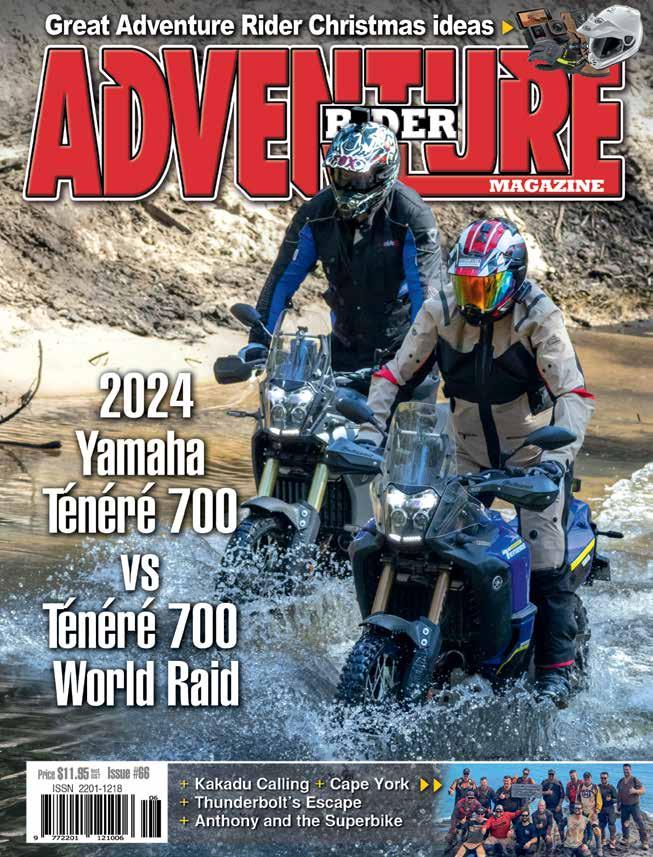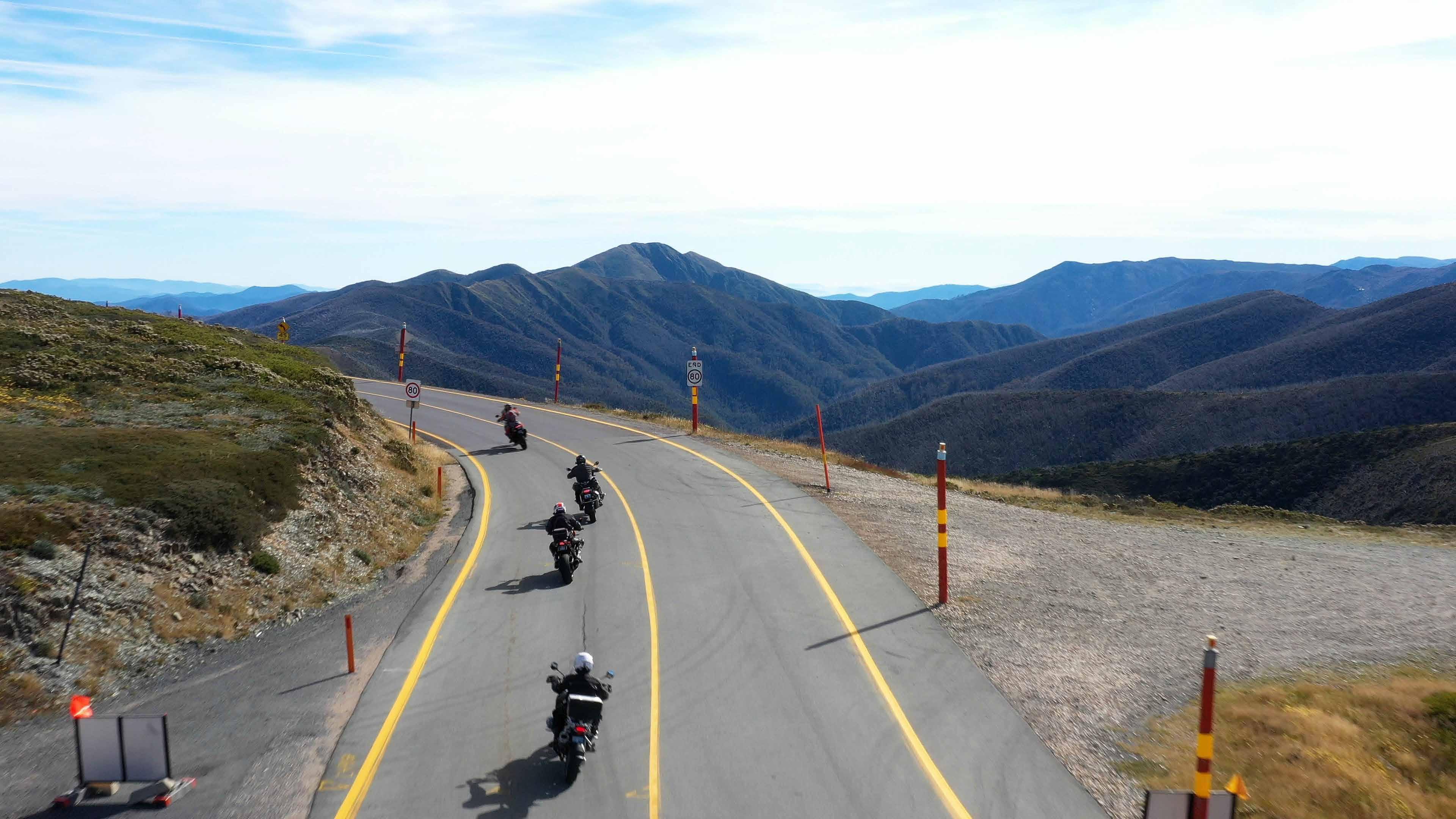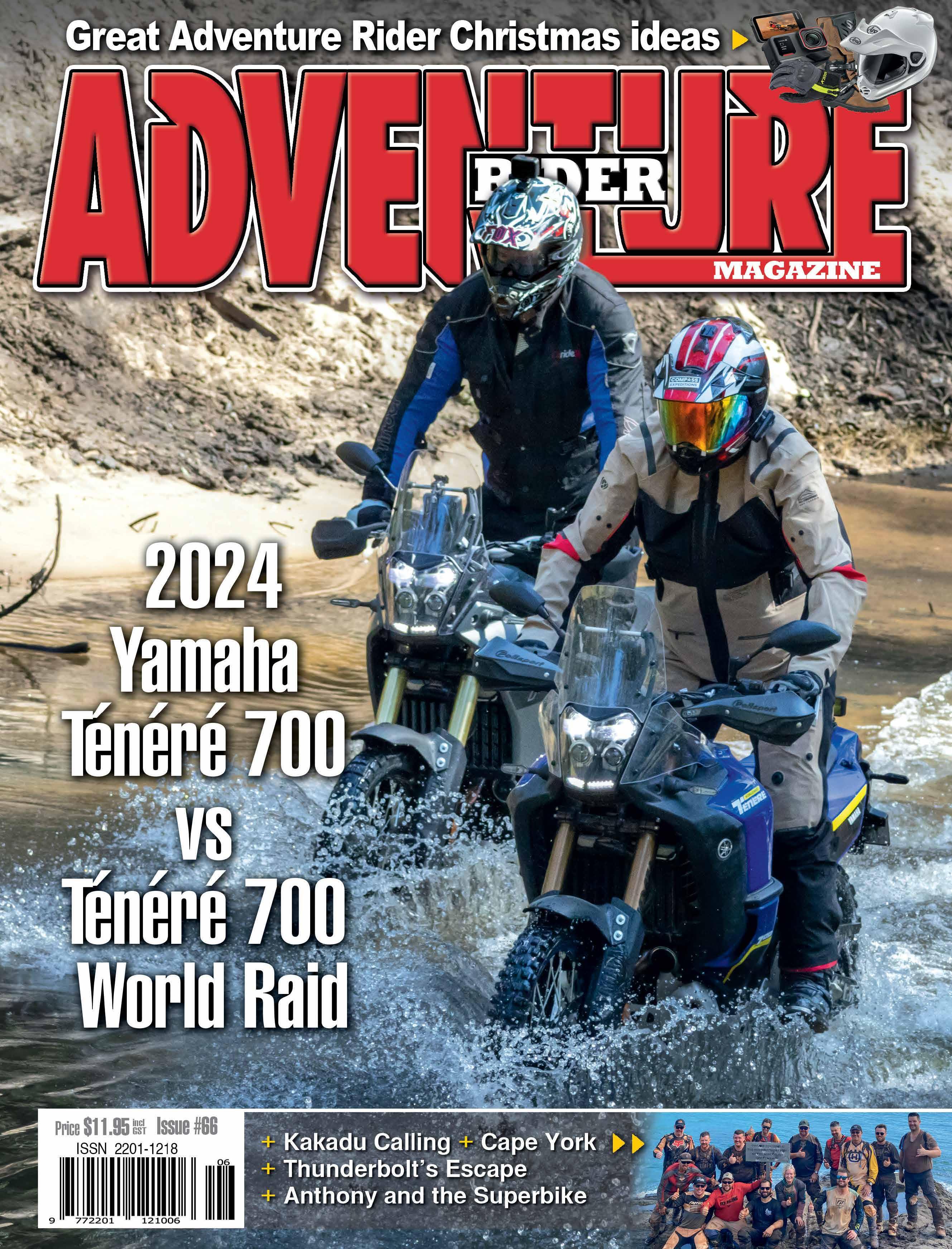
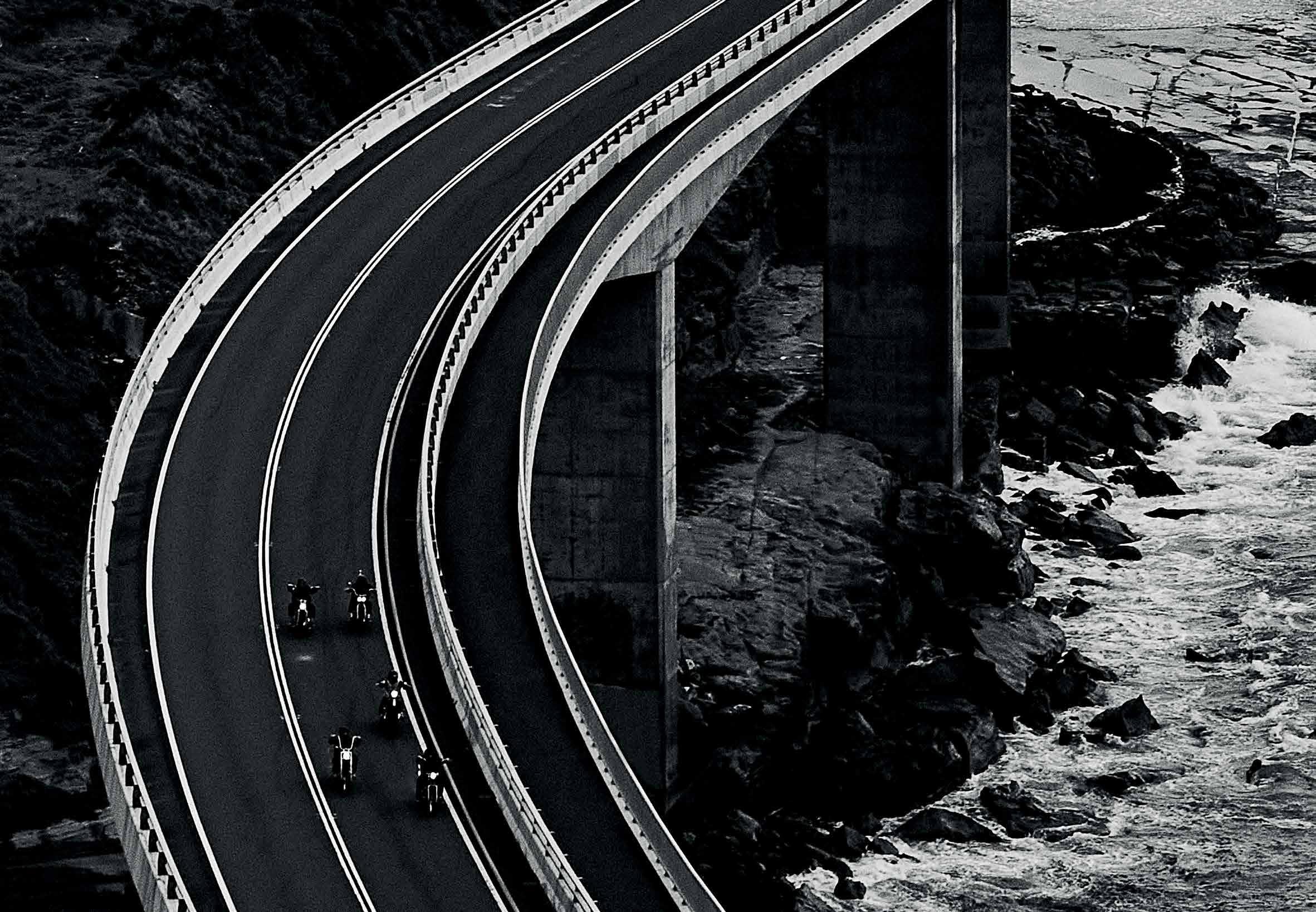







Adventure Rider Magazine is published bimonthly by Clemenger Media.
CEO Tony Clemenger
Editor Ray Vysniauskas
Associate Editor Mert Karakaslar
Contributors
Anthony Morrison, Bob Wozga, Don Beaton, Heather Ellis, Endeavour Motorcycle Tours, Josh Rykers, Pete Vorst, Juan Navarro-Teverter Taboada
Thomas Pfister, Mert Karakaslar, Philipa Tlaskal, Ray Vysniauskas
(If you would like a chance to have your adventure in print please email mert.karakaslar@clemengermediasales.com.au)
Design Danny Bourke Southern-bear@bigpond.com.au
Subscriptions
Phone: 1800 995 007
Website: www.advridermag.com.au
Copyright Adventure Rider Magazine is owned by Clemenger Consulting –Clemenger Media Sales and published by Tony Clemenger. All material in Adventure Rider Magazine is copyright and no part may be reproduced or copied in any form or by any means (graphic, electronic or mechanical including information and retrieval systems) without written permission of the publisher. We welcome ALL contributions but reserve the right to accept or reject any material. While every effort has been made to ensure the accuracy of information, Clemenger will not accept responsibility for errors or omissions or for any consequences arising from reliance on information published. The opinions expressed in Adventure Rider Magazine are not necessarily the opinions of, or endorsed by, the publisher unless otherwise stated.
© Copyright Clemenger Consulting, 2024
Articles
All articles submitted for publication become the property of the publisher. Editors reserve the right to adjust any article to conform with the magazine format.
L1 397 Chapel Street South Yarra 3141 P: +61 1800 995 007
tony.clemenger@clemengermediasales.com.au www.clemengermediasales.com.au

WWelcome to the Christmas edition of Adventure Rider Magazine
With the festive season just around the corner we look forward to the celebrations of the year just gone and the challenges of the year ahead.
Adventure Rider Magazine is all about community and shared passions in the joys of motorcycling, and in the year ahead it is the spirit of community that we aim to push us forward in these pages. It’s no secret that print is a tough industry at the moment, but here at Adventure Rider we are determined to proceed and prosper and the only way we can do that is with the help of our riders and readers.
In the coming year we will turn our focus on the community, to better tell your story, to see the industry through your eyes. We want to talk to everyone, from the

independent repair stores, the tyre shop, the race track owners, the rider educators and anyone else who lives by love of their bike.
We want to hear about your adventures, your misgivings and concerns and any ideas or solutions that you’ve come across that can help, entertain or warn others.
So if you have a story, a quirky moment or some great advice, please tell us and we’ll share your experiences as best we can. The world is changing and we need to go along with it, but we also need to keep a handle on those things that we don’t want to lose - like just riding down the road, along the track or through the bush with a smile on your dial.
It doesn’t get any better than that.

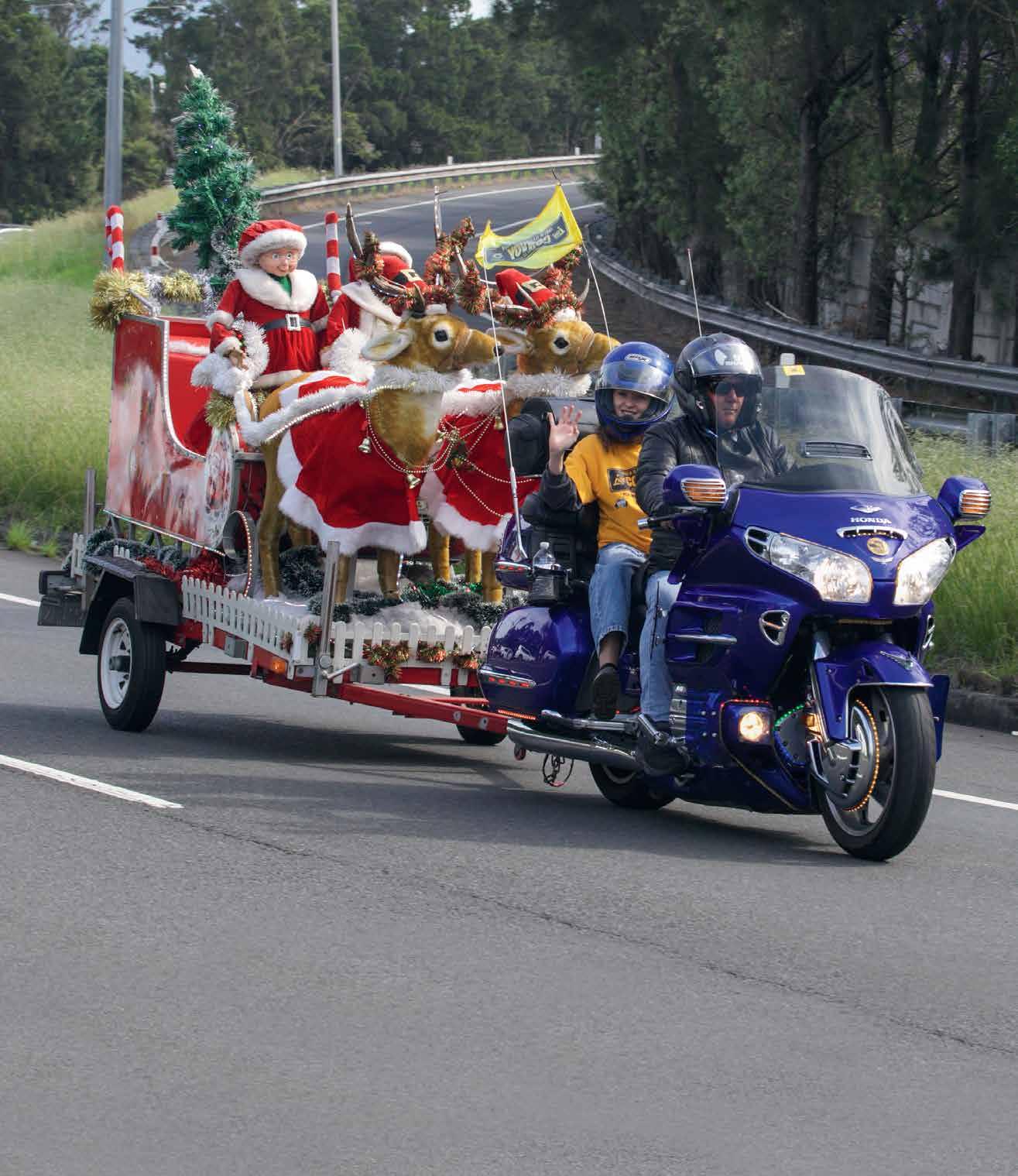





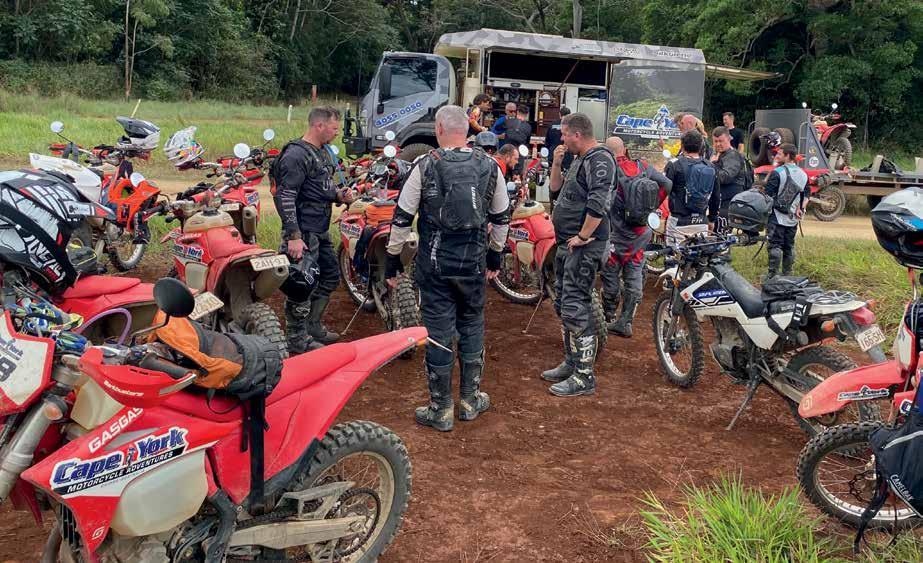


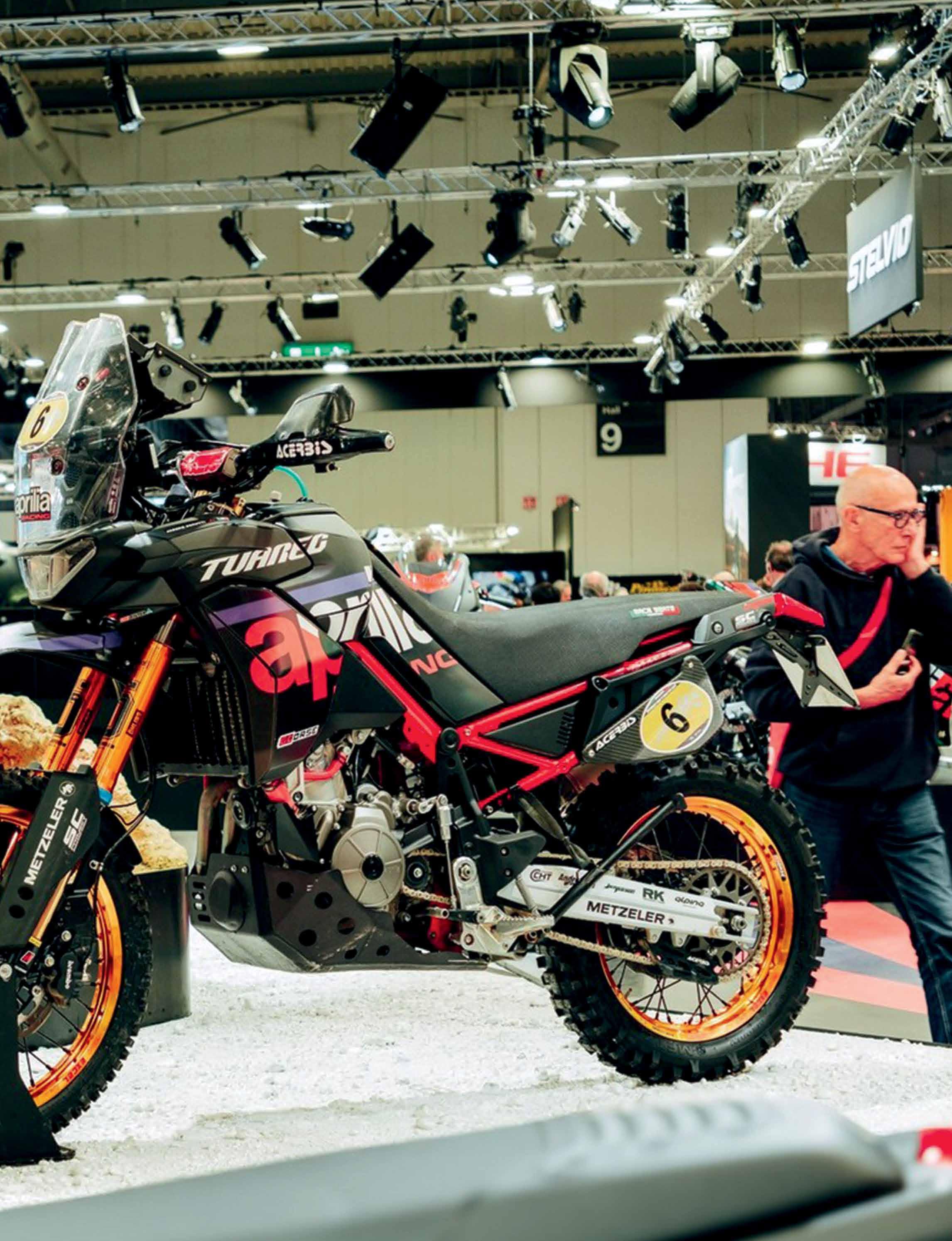
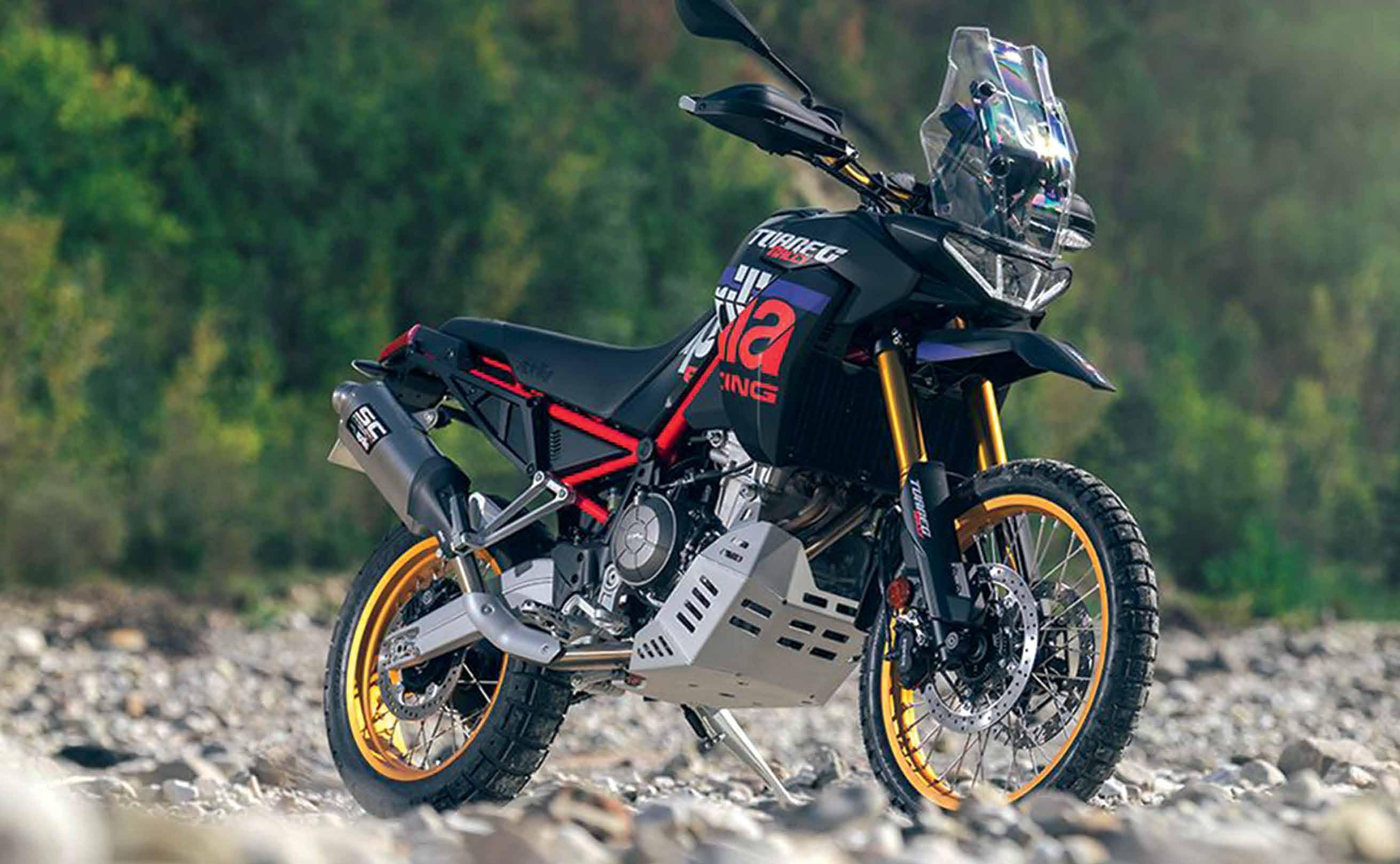
The Tuareg was undoubtedly one of the standout bikes of the past couple of years, and the Rally version is sure to be welcomed in every market in which it’s offered.
A new engine map delivers a quicker and more decisive throttle response, and the suspension has been upgraded to, says Aprilia, ‘improve the bike’s overall stability’. We thought the Toe-rag’s stability was one of its high points, so this thing must be really exceptional.
An SC Project exhaust system, complete with a full titanium silencer looks the


business, and overall wet weight has been reduced to 199kg.
It’s not easy to see how there could be big improvements in the Tuareg as we last rode it, but advances in technology are amazing us every time we jump on a new bike, and Aprilia is right up there leading the pack with great electronics and user-friendliness.
We’re expecting to see this bike being very well received when it makes its way Downunder.


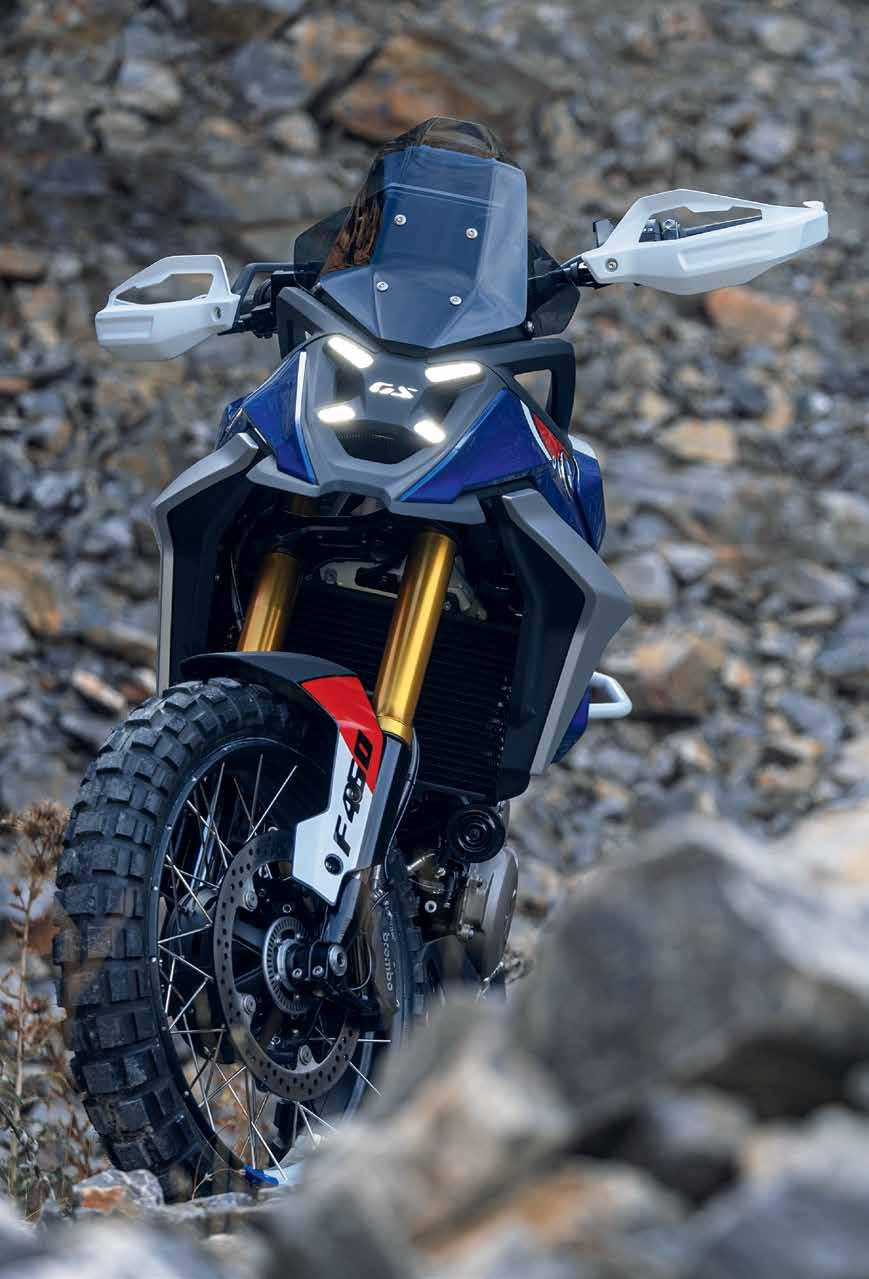
Displayed as a ‘production-ready’ concept, 450GS is BMW’s current entry into the fast-growing lightweight ADV class.
It’s not BMW’s first attempt – there have been a few, including the G 450 X and its air shock a decade or so ago, offered as an enduro bike, and the 300 GS which won a lot of hearts over the past few years. The 450 at EICMA looked a lot like a ‘small GS’, and we’re taking that as a good sign.
“The BMW Concept F 450 GS carries the characteristic DNA of the GS family,” said Alexander Buckan, head of BMW Motorrad Design. “We have succeeded in designing the concept with the sporty dynamic appeal of our large off-road icon in a particularly compact form.”
A 48hp parallel twin with a steel trellis frame and upside-downers in a 175kg package should have the Beemer brigade frothing.
We admit we’re a bit damp around the nether regions at this one as well.





The new Big Daddy of the adventure world – along with the BMW 1300 GSA – KTM’s 1390 Super Adventure S Evo is powered by a V-twin LC8 engine derived from the fearsome Super Duke R. When only the biggest and best will do, the 1390 delivers – 173hp and 145Nm of torque with a stiffer frame and latestgeneration WP semi-active technology.
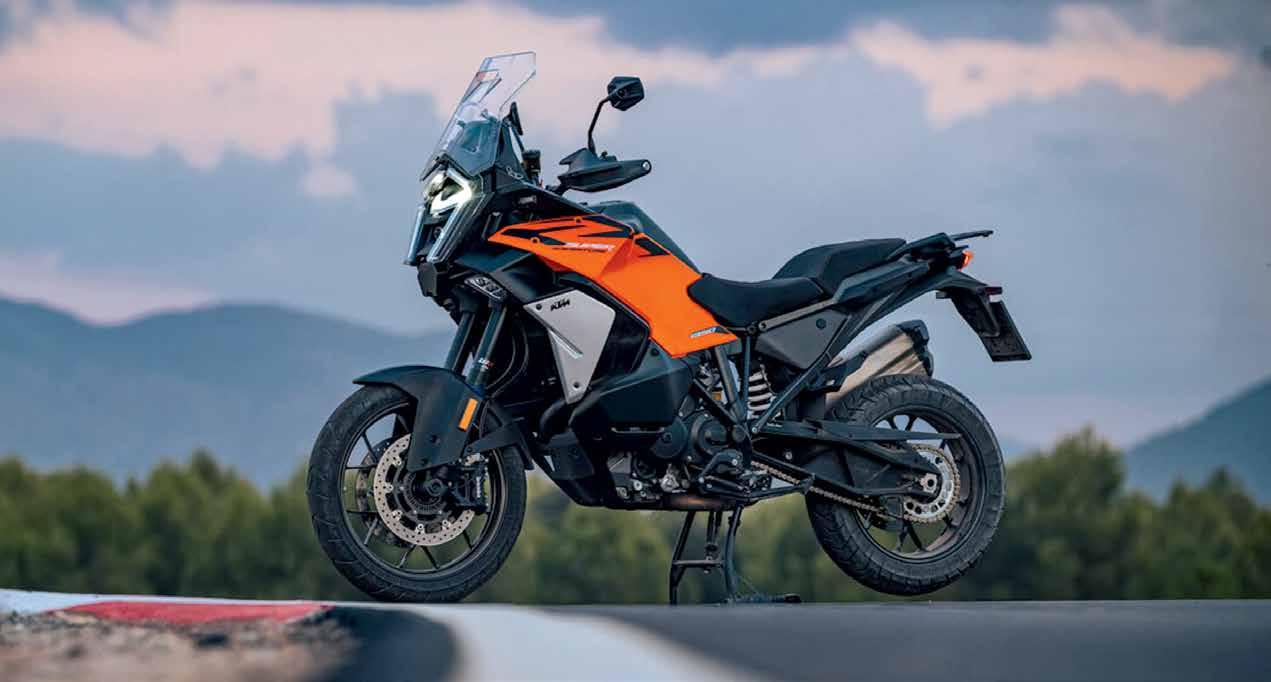
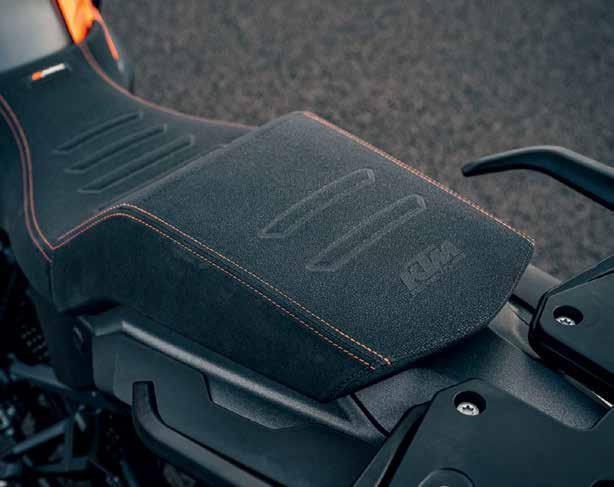
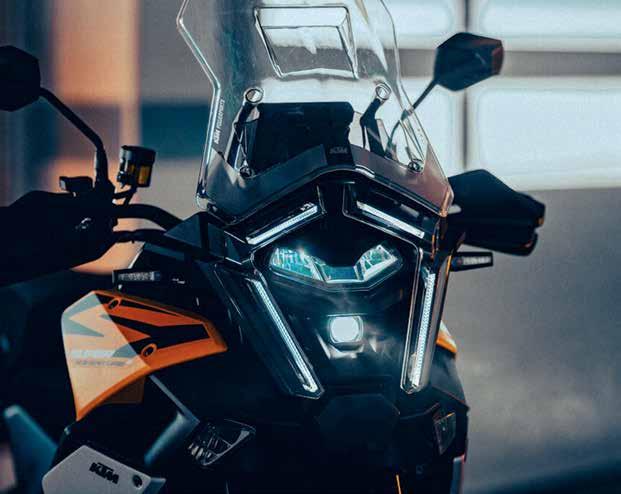
A new eight-inch colour dashboard with touchscreen and offline navigation capability is the techno hub of the bike’s electronics, which also comes equipped with front radar for Adaptive Cruise Control.
The 1390 Super Adventure S Evo will be available with KTM’s Automated Manual Transmission (AMT), which KTM claims to be one of the most innovative engine developments made by the company in recent years.
With any other company we’d roll our eyes and move on to the next stand, but with the way KTM has leapt ahead lately, we’re perfectly ready to be amazed at what we find when we get the chance to ride this one.

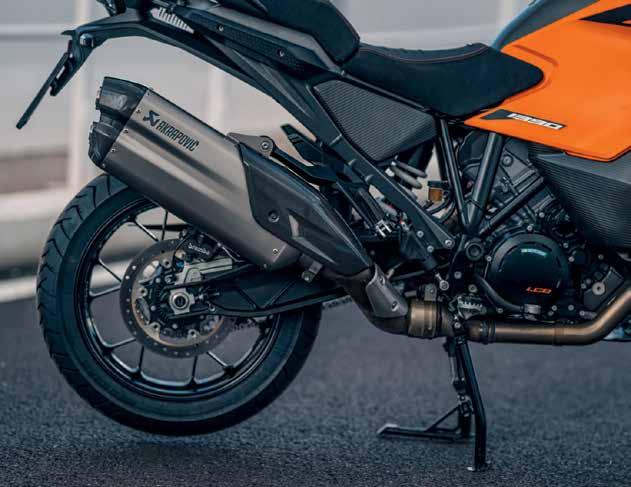

Abig step for another of our favourite bikes.
The 390 Adventure R 2025 is an entirely new, more off-road oriented bike. A new chassis and Dakar-inspired bodywork hold an engine inherited from the latest Duke 390, and which delivers around 45hp. This is the same motor which also runs in the RC390 roadbike, and it’s proven itself a seriously good unit. While it hasn’t shaken the foundations of the World Supersport 300 competition in the hands of the 2023 world champ, it holds its own against the swarming masses of Kawaskis and Yamahas, and has so far shown no problems in any of the models in which
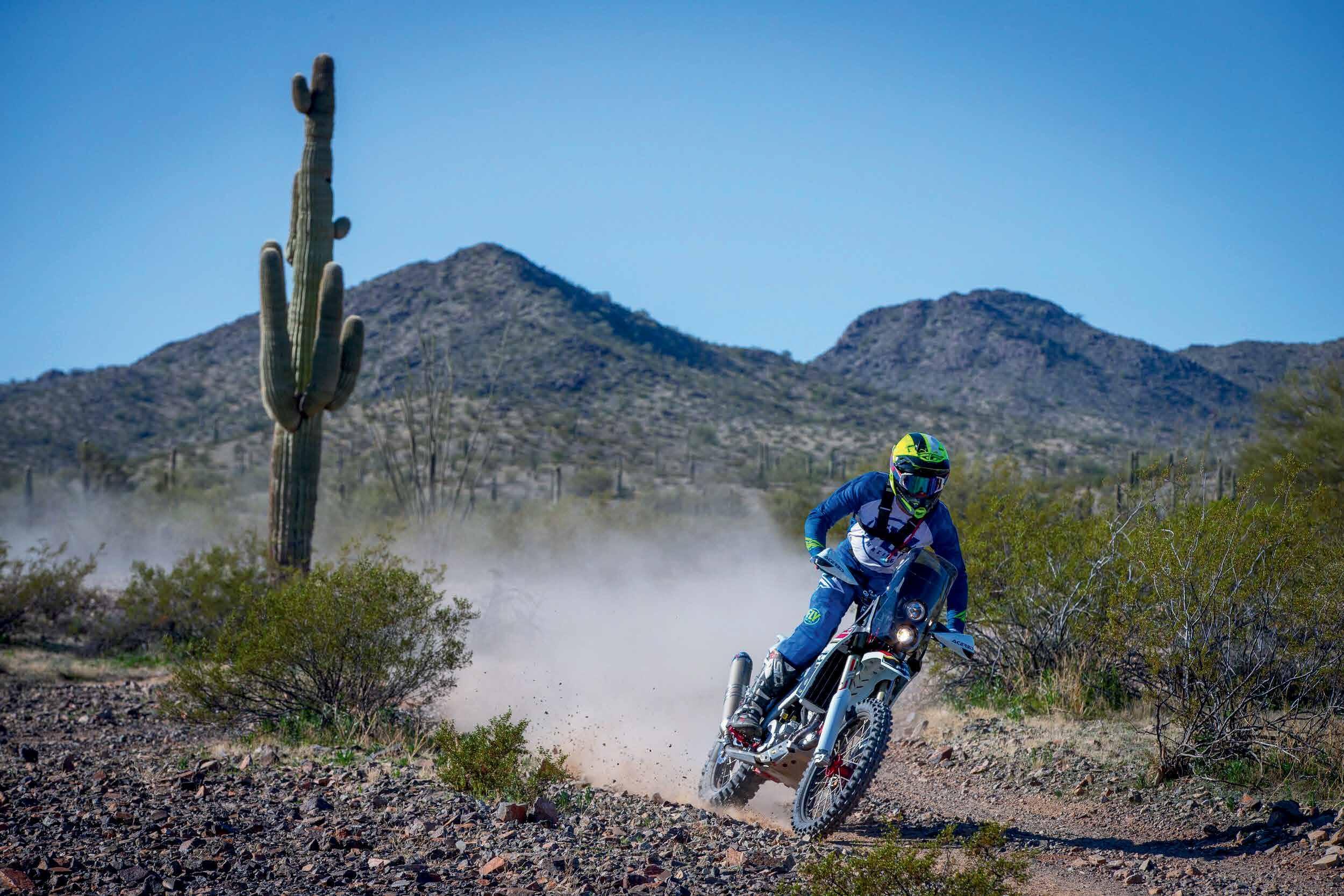


This bike raises the bar in the adventure stakes thanks to an ultra-lightweight chassis, a reliable single cylinder, EFI combined with a sophisticated suspension. When it's time to ride, the AJP PR7 is your best friend.



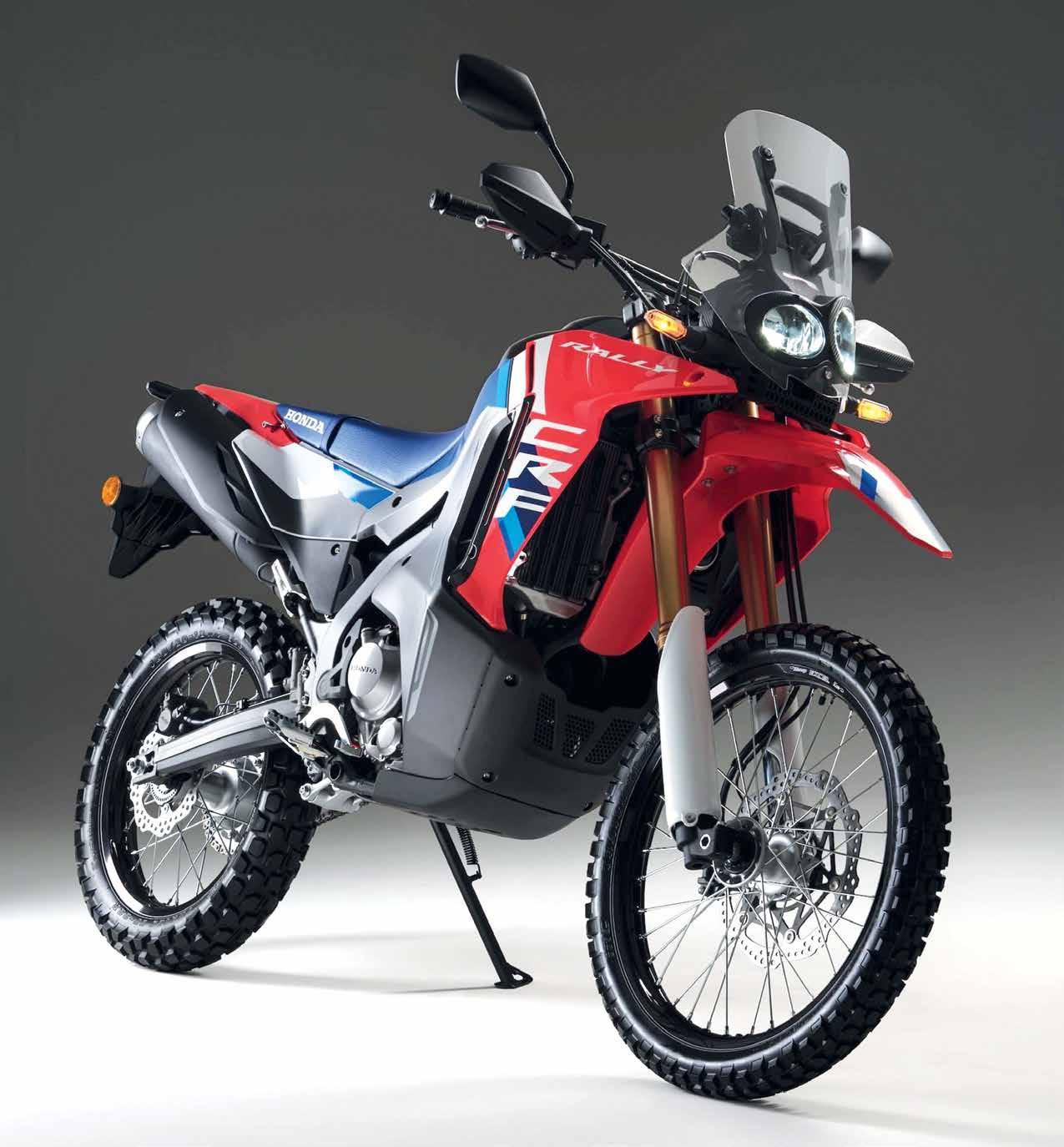

There were no big mechanical updates to Honda’s CRF300 models, but a few a detail upgrades are noteworthy, starting with the radiator fan being moved and a redesigned shroud now directing warm air away from the rider.
The single-cylinder engine is EURO5+ compliant and the six-speed gearbox and slipper clutch remain, while the 2025 CRF300L now has an LED headlight and compact LED indicators.
Suspension was always the problem with the tiddler CRF, otherwise a great bike in our opinion, and Honda claims ‘revised damping settings’ on both CRF300 models. We felt the spring weights were too light for big, hairy-knuckled Aussies, and no amount of twiddling with damping will fix that, but we’ll have to wait and see…maybe that should be ‘weight and see’.
The major difference between the two models, besides the rally-style bodywork versus trailbike plastics, is the weight. The 300L is a claimed 142kg while the Rally 153kg kerb weight.





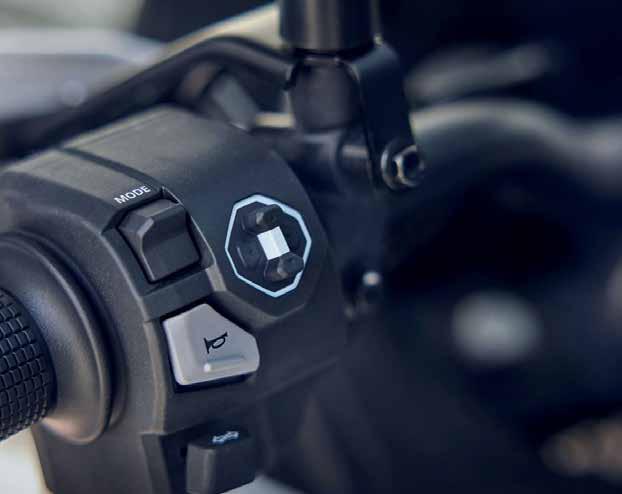
Anothermodel designation reanimated from the glory days of the 1980s, the 2025 version of the Transalp has a new split headlight and a windscreen, made of eco-friendly DurabioTM material, redesigned to better deflect air around the rider and reduce buffeting.
A five-inch TFT colour display with Honda RoadSync connectivity is now the centre of the electronics on a bike which offers six riding modes: Sport, Standard, Rain, Gravel, and two user-customisable modes. A ride-by-wire throttle, of course, but Honda said this one is specific to the Transalp. Switches are backlit – we remember complaining about unlit switches on the first relaunched Africa Twin – and the suspension setup has also been revised in both the 43mm upside-downers and the shock. Both ends are Showa, naturally.
The bike is Euro5+ homologated, and its eight-valve parallel-twin engine pumps out 92hp and 75Nm of torque.
The accessories’ range has also been expanded for the new model and, surprising no one, it’s available in a range of new colours.
It’s a far cry from the Transalp which won so much respect in the mid to late 1980s, but then, so are we. We’ll bet it’s as beautifully engineered, and as reliable and polished as every bike Honda offers.





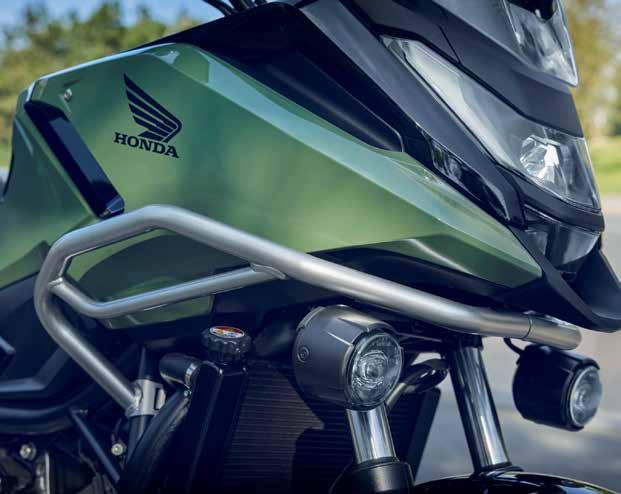

Definitelyat the softer end of the adventure range, Honda’s NC750X now has a sharper look and more braking power thanks to dual front discs. A redesigned seat and new TFT display with Honda RoadSync connectivity up the ante from previous models, and, at EICMA at least, a Dual Clutch Transmission. At the time of writing we couldn’t find any guarantee that gearbox would be available in Australia.
It looks a great long-distance bike, and Honda can be relied upon to offer a great range of accessories. For those looking for a first-class all-rounder and who don’t want to go too hard-core, this could be a great option.

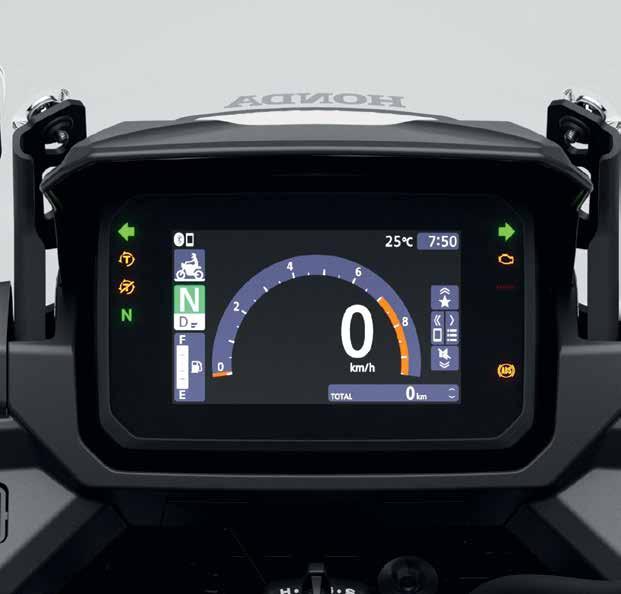
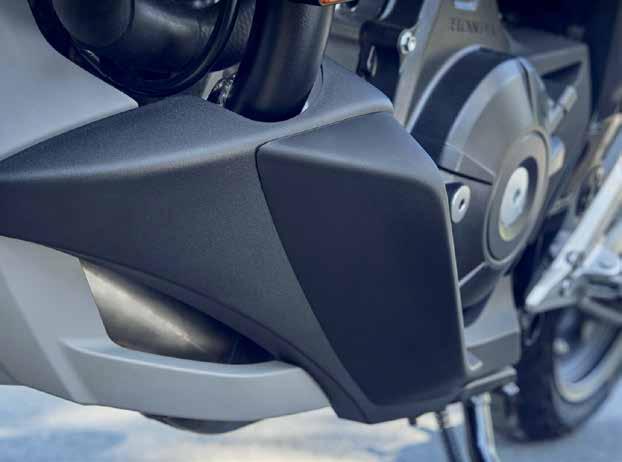

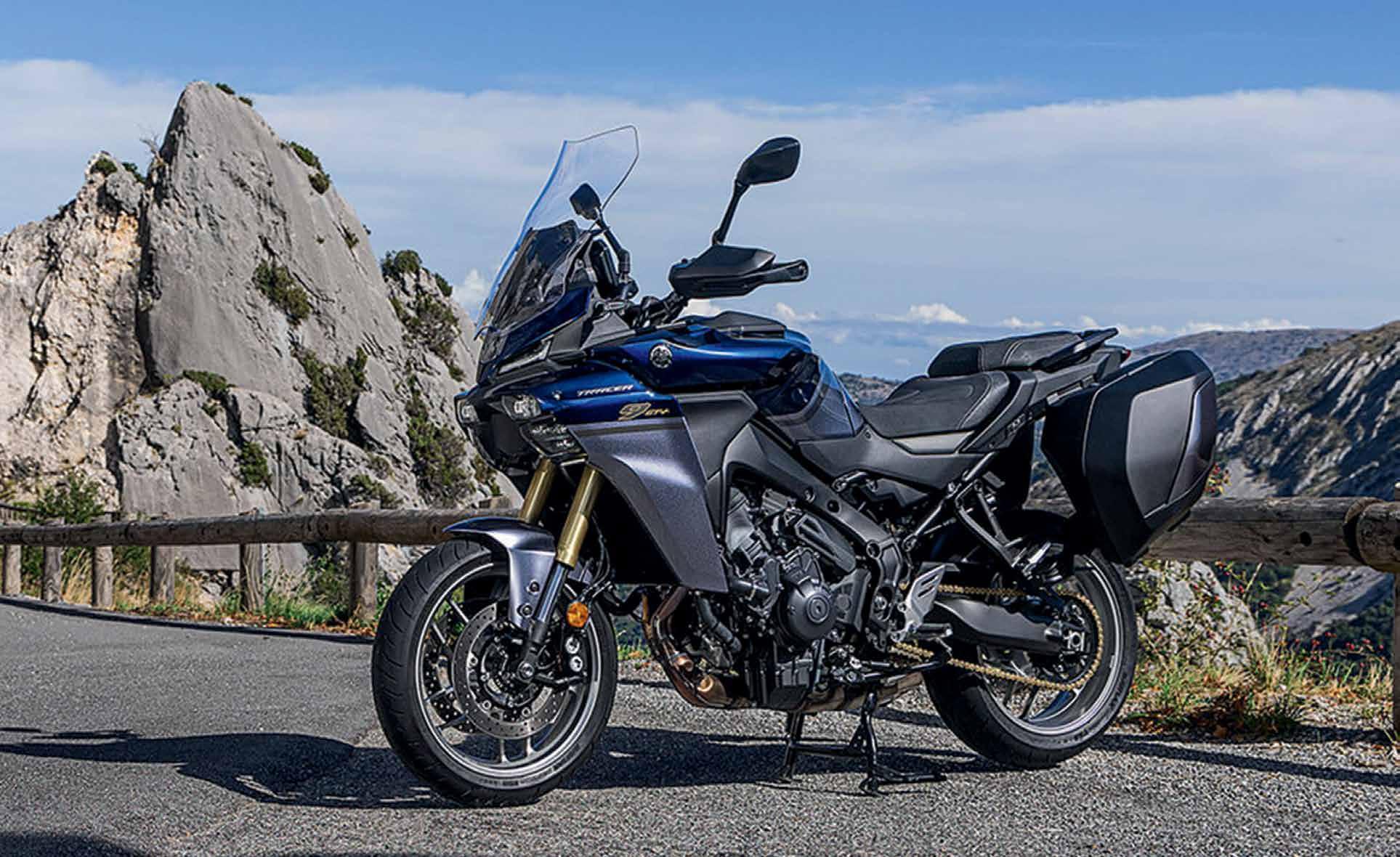
We’re not too sure where we sit with Yamaha’s Tracer.
The CP3 890cc motor is fantastic, and Yamaha’s quite correctly made great use of it in several models.
But the Tracer is definitely a road-oriented bike. It’s a damn good one, we fully allow, but like Honda’s NC750, it doesn’t look well suited to the rough stuff.
Of course, there are plenty of riders who don’t have a Simpson crossing as part of their plan for the coming year, and we bet the Tracer can actually be surprisingly capable off road within reasonable limits.
For 2025 the Tracer 9 gets an LED matrix lighting system, which Yamaha says is a first of its type for a motorcycle. Combined with a front camera, it automatically adjusts the light beam intensity based on lighting conditions, allowing optimum visibility without dazzling oncoming vehicles.
We’re tempted to say the lighting is very flash, but it might sound like we were searching for a pun (and we’re above that…a little bit).
All versions of the Tracer 9 are powered by the 890cc CP3 threecylinder engine with 119hp, and run an unchanged aluminium frame with the same braking system as last year. Seat, footrests, and handlebars have been moved to improve comfort and the seat is softer. The rear subframe is 50mm longer, providing more onboard space. All versions feature a seven-inch TFT dashboard, with the GT and GT+ models also equipped with connectivity, allowing turn-byturn navigation through Yamaha’s MyRide app.
Among the three available versions, the Tracer 9 is the base model, equipped with mechanical suspension; the Tracer 9 GT features semi-active suspension and standard side bags; and the Tracer 9 GT+, the top-of-the-line version, includes all GT features, while adding a front-looking radar, Y-AMT robotic transmission, LED matrix lighting, and central locking for the bags.
Definitely a great touring package with real dirt-road capability.



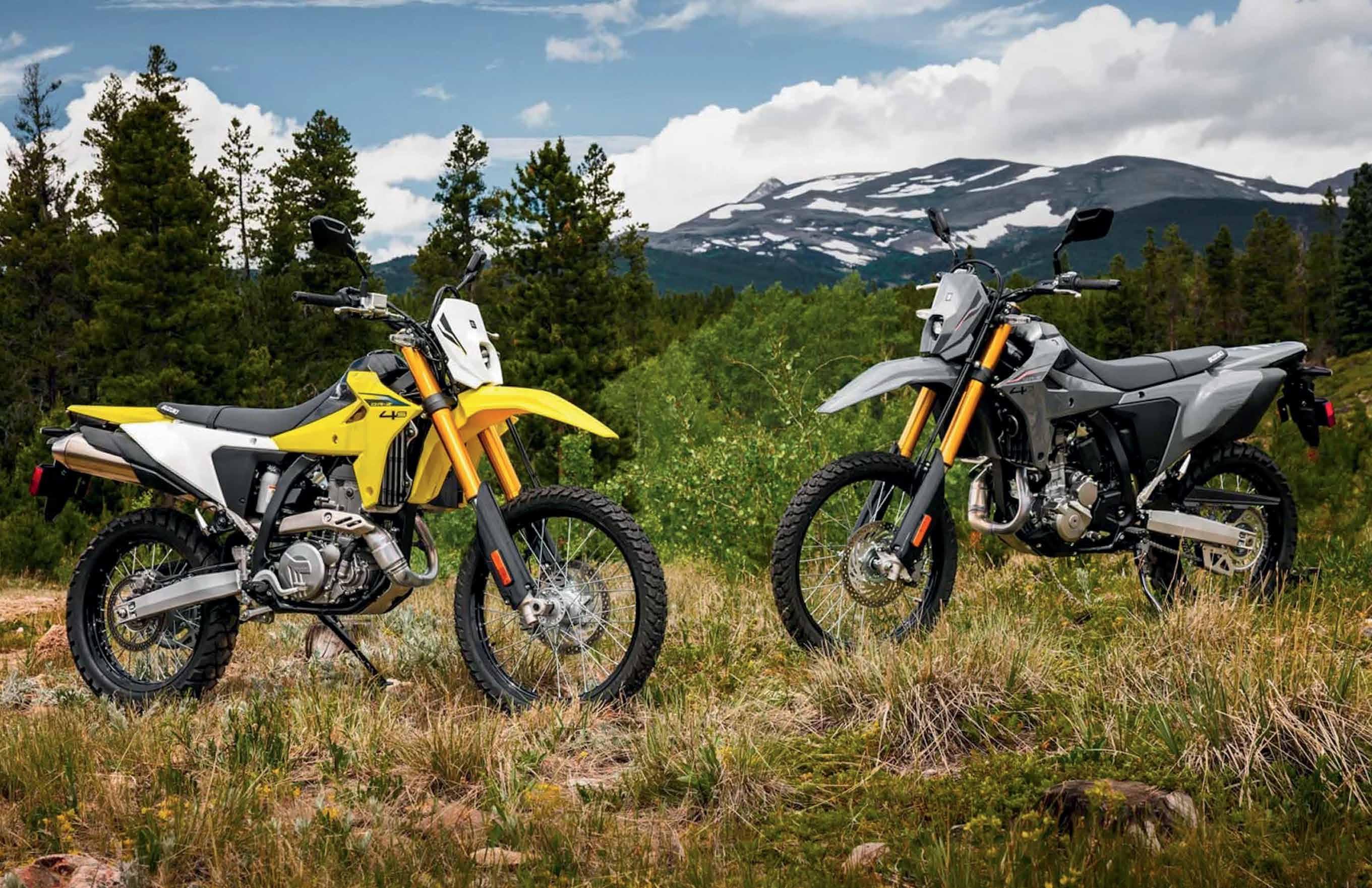
With everyone on the edge of their seat wondering whether the DR-Z would follow the DR650 onto the Euro-non-compliant dungheap of great bikes, the cheers of joy were heard around the globe when Suzuki unveiled a fuel-injected DR-Z 400 S with future-proofing Euro 5+ certification.
There probably isn’t a more universally accepted and respected dualsporter anywhere in the world.
Not since the XR400 was phased out, anyway.
The good old DR-Z was never the fastest or best performing, but it was always extremely comfortable, reliable, and in the right hands could give an excellent account of itself off-road in almost any company.
Let’s hope the new model continues the tradition.
A new steel frame features a twinbeam upper structure, along with adjustable KYB suspension, and on the electronics side, the DR-Z now runs ride-by-wire with three engine maps, adjustable traction control and ABS which can be deactivated.
That’ll be almost blasephemy for
the diehard DR-Z fans, but we can imagine is being a big step forward in performance for this bike. It also opens the door for cruise control at some time in the future, and we’re big fans.
The single-cylinder, DOHC engine has dual ignition, a five-speed transmission –boo, hissss, Suzuki – with a slipper clutch, and a claimed curb weight of 151kg.
We’re backing this one to be a winner. Suzuki doesn’t make many mistakes with the DR range, and that’s benn proven over several decades.

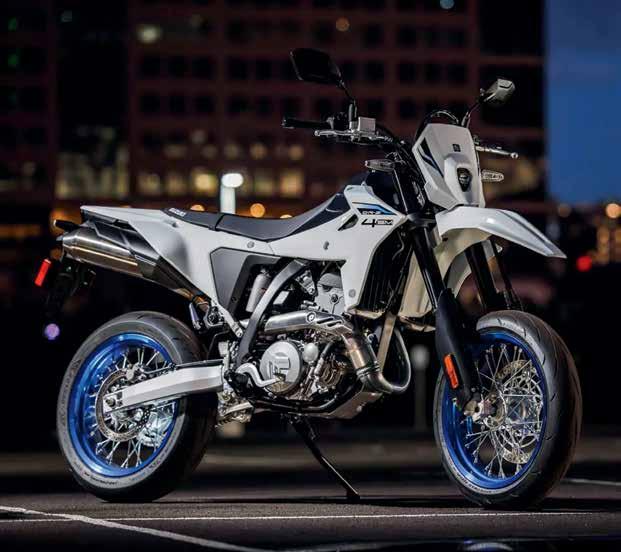

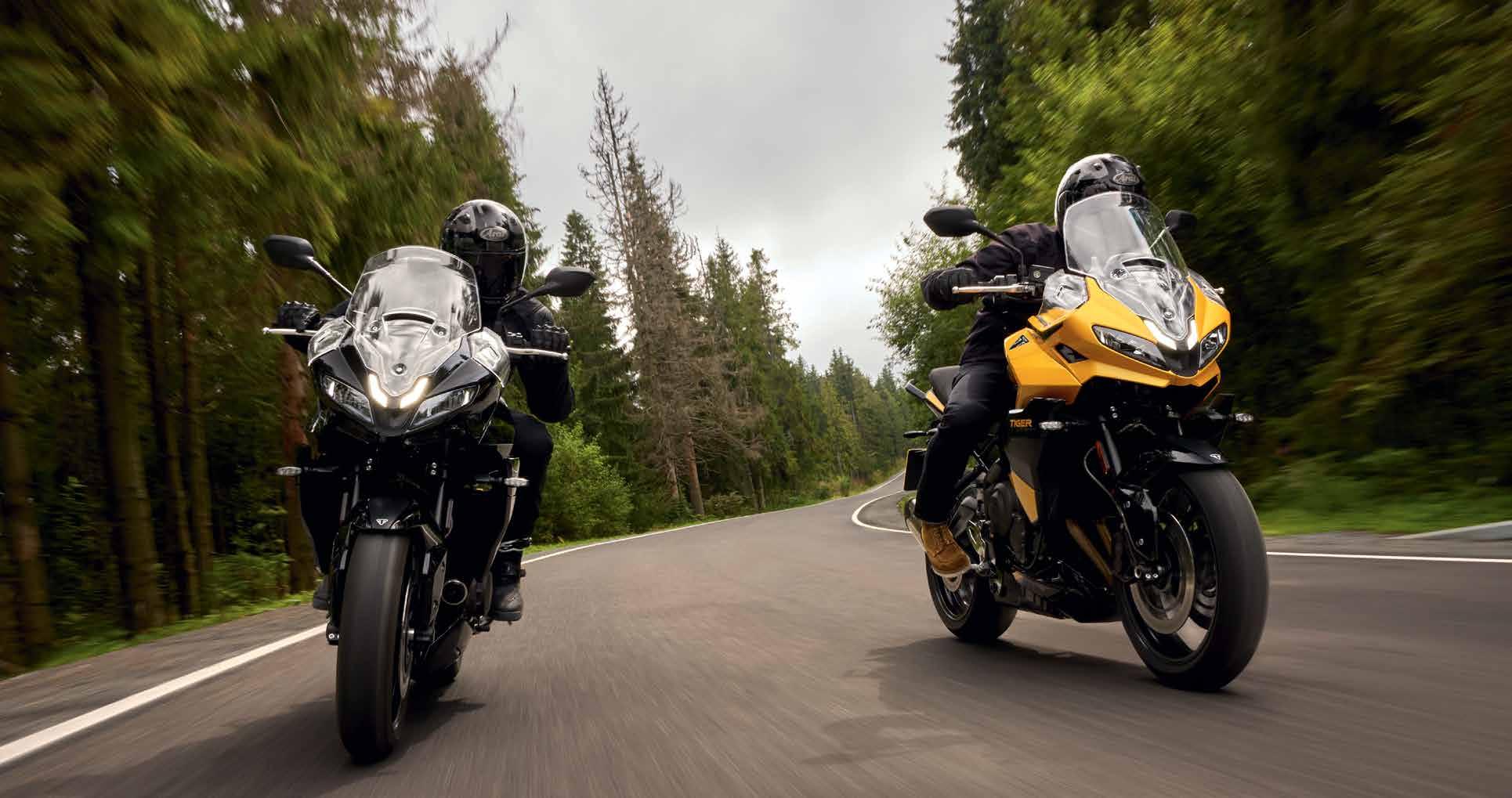
Thisone really did bring a tear to the eye.
The Tiger 800 was one of the most impressive bikes we’ve ridden in the past decade or 15 years. When it first burst onto the scene in 2011 we were in awe of the linear power delivery, the sensational feel, and the incredible ability of the bike, on and off road.
That awe stayed with us through the years as the electronics were added, the capacity increased to 900cc, and we felt the 800 of blessed memory had drifted into the nostalgic past of fantastic rides, incredible places and wonderful people.
But now there’s a new Tiger Sport 800, which, Triumph says, is ‘designed to provide the perfect balance of exhilarating sports performance and long-distance touring capability’.
The bike features a new version of
Hinckley’s three-cylinder engine, delivering 115hp at 10,750 rpm and 84Nm of torque at 8500rpm. It comes standard with a slip-and-assist clutch, and a quickshifter with downshift blipper. A tubular-steel perimeter frame gives plenty of rigidity, while the suspension is adjustable Showa front and rear: hydraulic adjustments for the fork, and rebound and preload settings for the shock.
Completing the package is a pair of four-piston radial callipers and 310mm discs, as well as an electronic setup based on an inertial platform with three riding modes. It’s a ride-by wire-throttle, naturally, and traction control is switchable.
We’re only guessing, but we feel like this bike harks back to the days of the 800 XR, the more roadie version of the

800. It was a little lower and little racier than the adventure model, but man! That bike could hook up and go! And it was an absolute joy on a loose surface.
We have our fingers crossed that that’s what we’re seeing here.

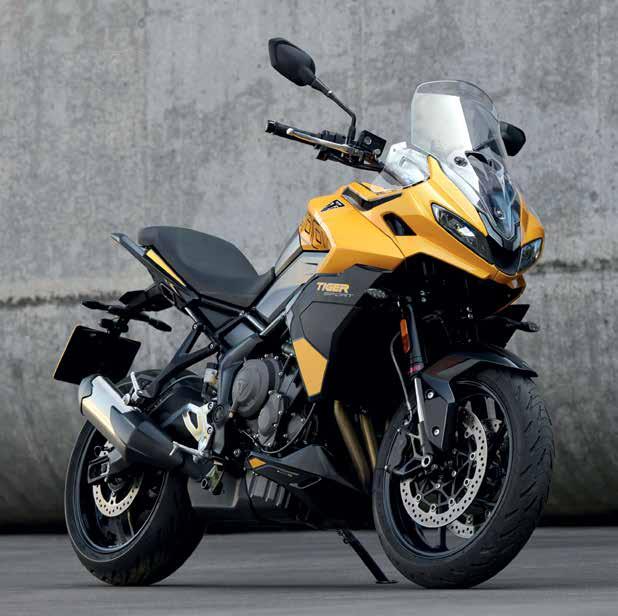
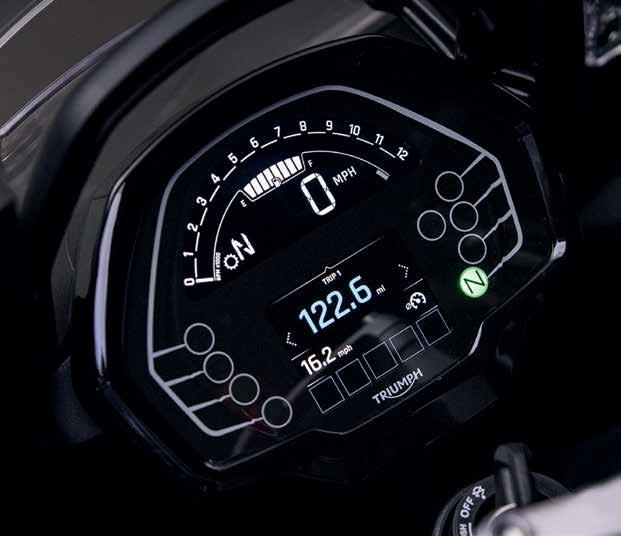
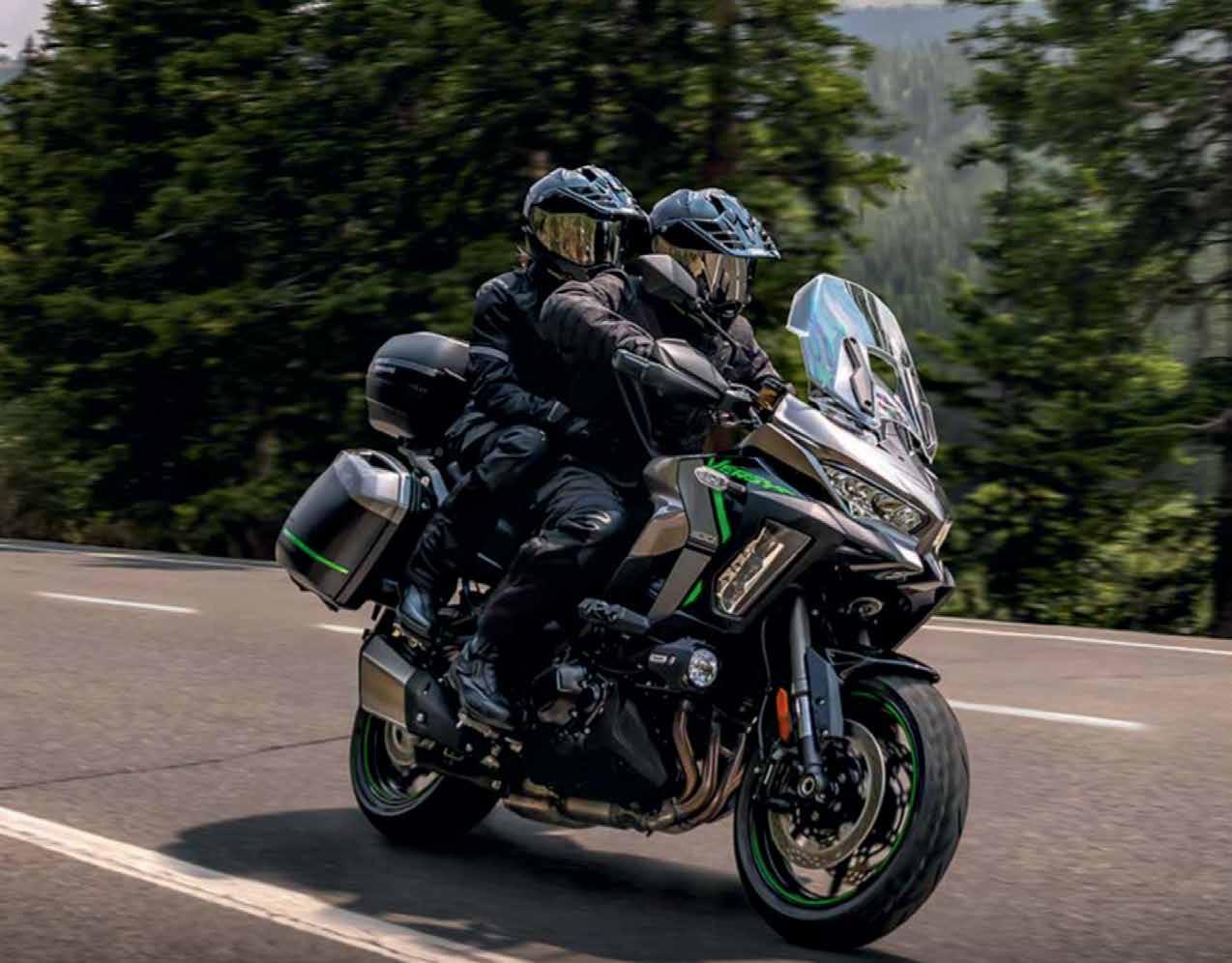
We haven’t had a great deal of experience with the Big Mofo Versys.
We found the 650 a capable bike, and we were astonished at both the performance and versatility of the 300 – who can forget the Touratech guys blasting across the centre of Australia on them – so we’re inclined to feel the big Kawa is likely to be a stellar performer…pretty much all the multi-cylinder Kawas are.
For 2025, and on show at EICMA, the Versys gets an engine-capacity boost of around 100cc, jumping from 1000cc to 1100cc. Don’t get too excited. As we’ve seen in so many bikes lately, it looks as though the capacity increase is to help cope with the loss of performance in compliance
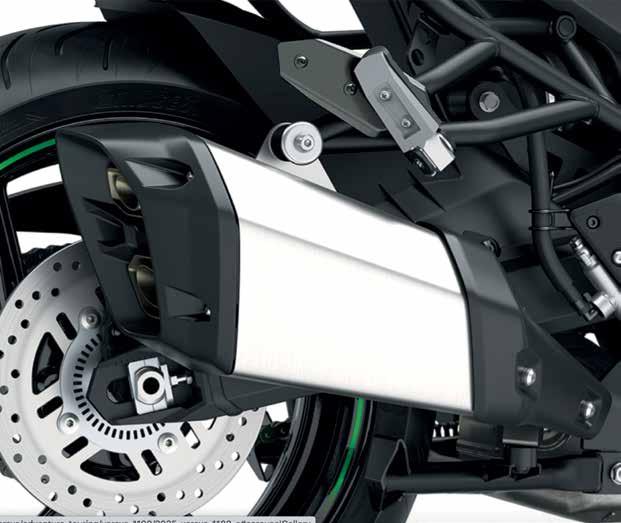
with Euro 5+ regulations.
That’s not just Kawasaki. That’s all brands.
Having said that, power output jumps from 120hp to 135hp, which is a fair ol’ hike in snort, and a new Quickshifter works from a lowly 1500rpm.
The throttle jockies will love that, and the whole bike should be gift for the two-up brigade.
The rear disc is larger than the 2024 model, and advanced electronics now include traction control and cornering ABS managed via a new inertial platform. The SE version still has Showa EERA electronic suspension.
Once again, we expect this be more of a distance tourer with some dirtroad capability, and once again, we bet it’s an absolute hoot!

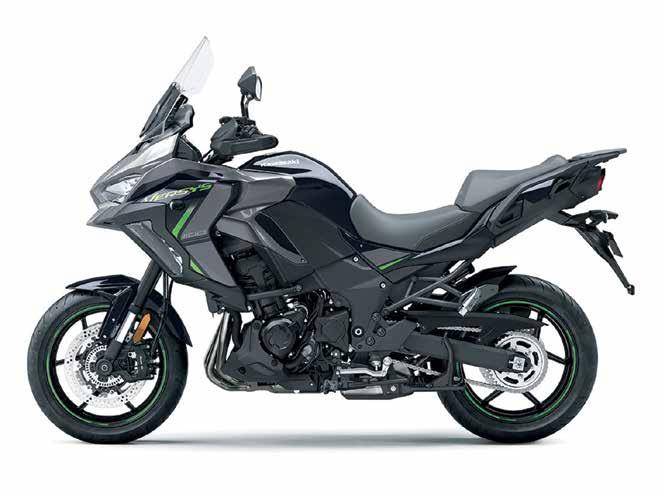

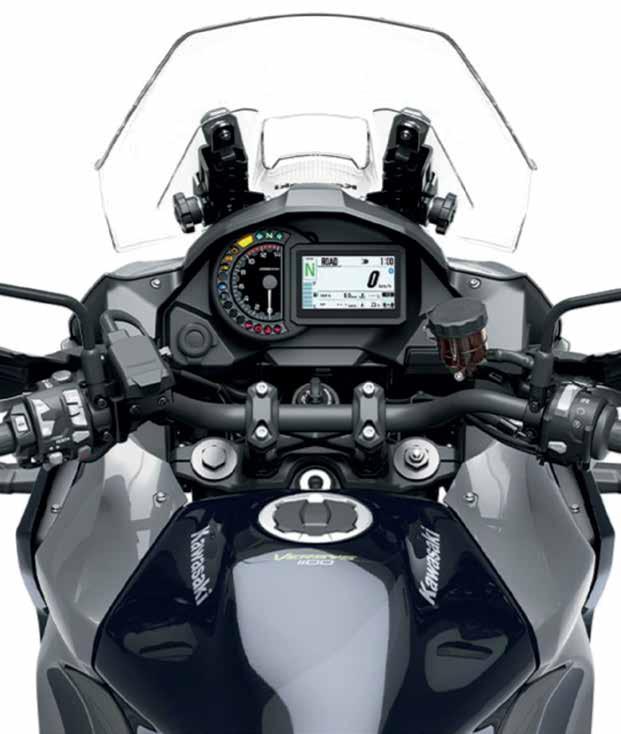
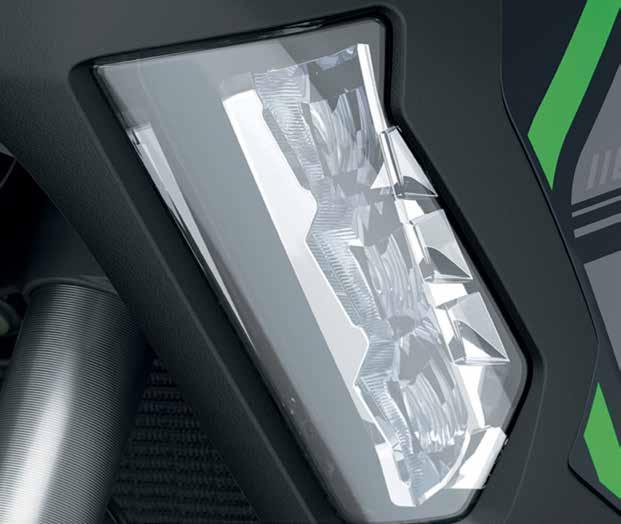


Aprototypederived from the GYTR special parts catalogue, the Ténéré 700 Raid displayed at EICMA was stacked with racing components. Long-travel suspension included a 48mm KYB fork, and the motor ran into an Akrapovic exhaust with a dedicated control unit. A reinforced clutch directed power through shortened gear ratios, and a more efficient cooling system is designed to keep the beast working in

tough going.
New discs and a more powerful braking set up are in line with the bike’s higher level of performance.
We have to say, the motor on the standard Ténéré, and now the World Raid, is an absolute peach. One of the best for an adventure bike in our recent memory. We didn’t feel the Akro made a great difference to the engine’s power delivery or characteristics, but it shaved off some weight, and that’s always welcome.
And of course, everything may well be very different with this bike.
We hope we get the chance to find out for ourselves.



There’s now two Ténéré 700s to choose from, which one you should choose is the big question
Words
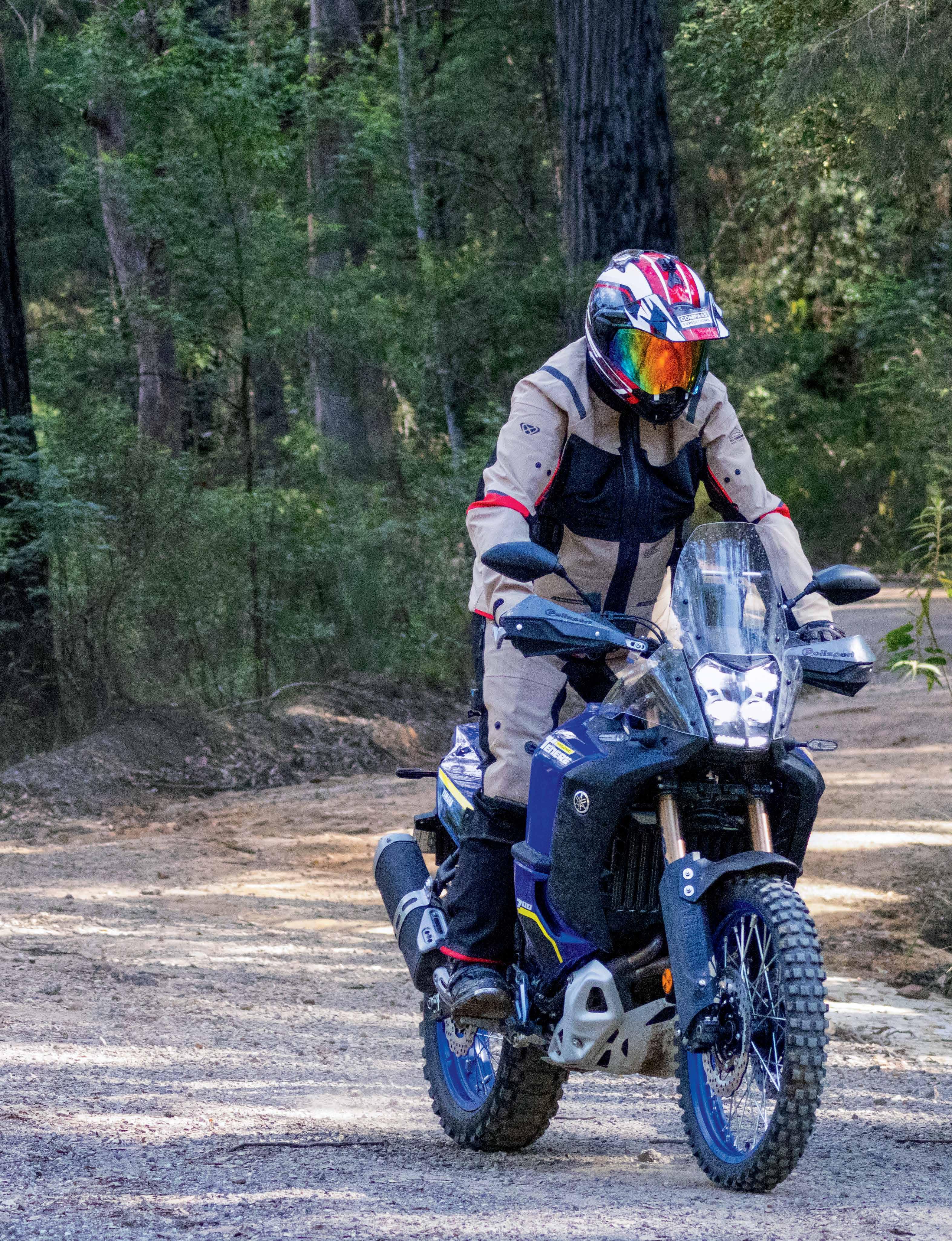

After years of watching Scooby-Doo cartoons and reruns of Gilligan’s Island, I genuinely thought quicksand would be more of a struggle in life than it has been in my 49 years on this planet. I’d started to think the stuff didn’t really exist—until I found myself roaring with exhaustion, sweating like a Melbourne Cup nag, and using a whole new range of colourful language as I tried to drag Yamaha’s Ténéré 700 World Raid out of the sucking sand of the Colo River, northwest of Sydney. Punting a 200-kilogram adventure bike through a sandy river seemed like a good idea at the time, and I almost made it—right up until the rear tyre lost its hopeless struggle for traction in the soft, quicksand-like riverbed and bogged the World Raid down to and past the bashplate.

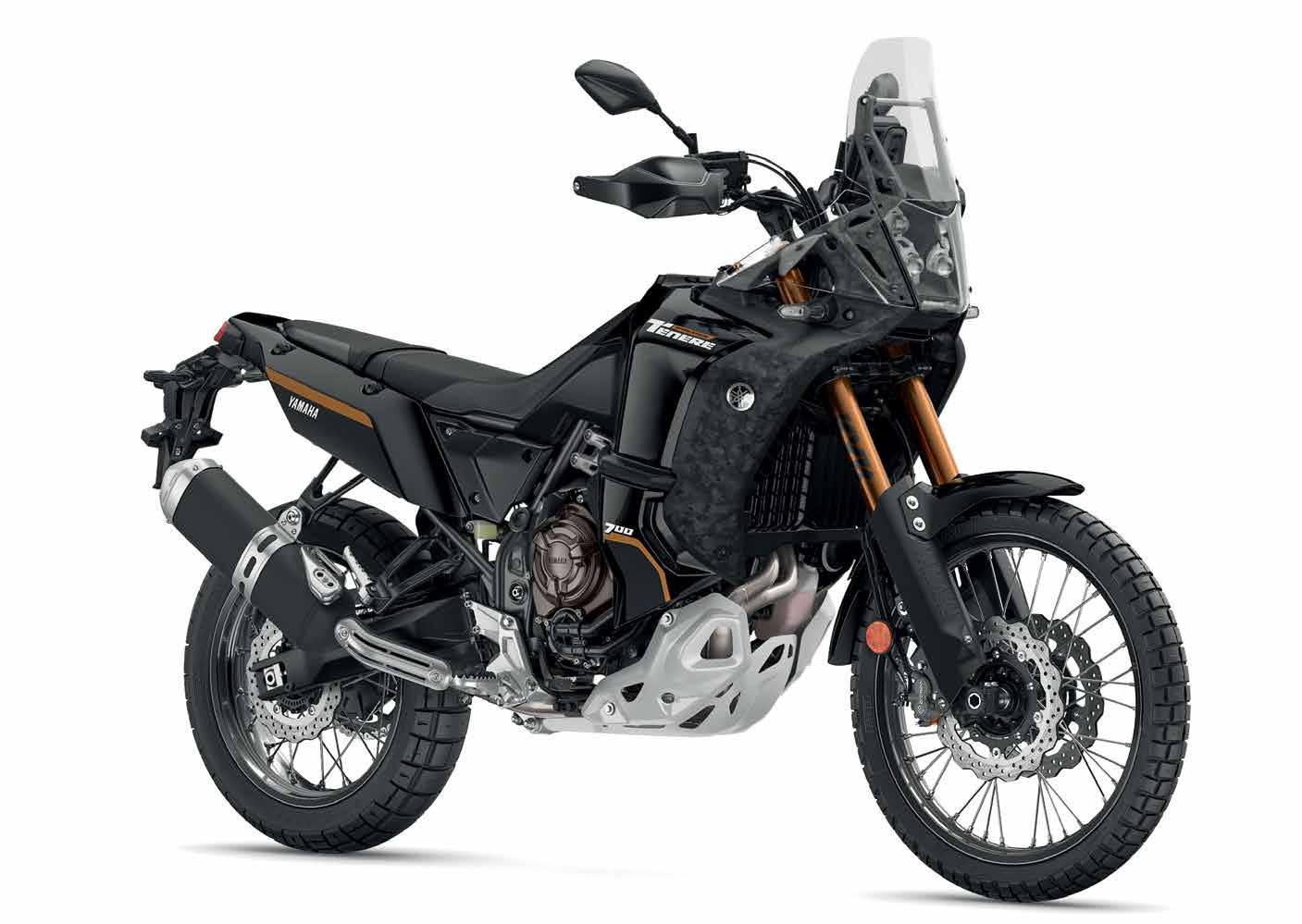




Flooding a bike isn’t fun. Extracting water from an engine is one thing, but trying to drain water from a fizzing electronics system while the heated seat boils the surrounding water—and the ABS, traction control, and radar-assisted active cruise control systems throw a barrage of fault codes onto your 400-inch TFT dash—is another kettle of mud crabs entirely.
And that’s why I love Yamaha’s Ténéré—and probably why it’s such a popular rig. There’s something downright refreshing about hopping on an adventure bike that doesn’t require a postgraduate degree in electronics to operate. Just thumb the starter, click it into gear, and bugger off to explore. And if things do go pear-shaped on some dusty track in the middle of nowhere, you’ve got a fighting chance of figuring it out and getting back on the road. The Ténéré 700 ticks all those boxes.
Yamaha has expanded the family, and we now have two models to choose from: the standard Ténéré 700, which I will refer to as the T7 from here on, and the new Ténéré 700 World Raid, which I will refer to as the World Raid going forward. They both share the same bones—a fuel-injected 689cc parallel-twin engine committed to a tough-as-nails steel frame—but the World Raid is truly a very different beast.
The T7 has received its most significant
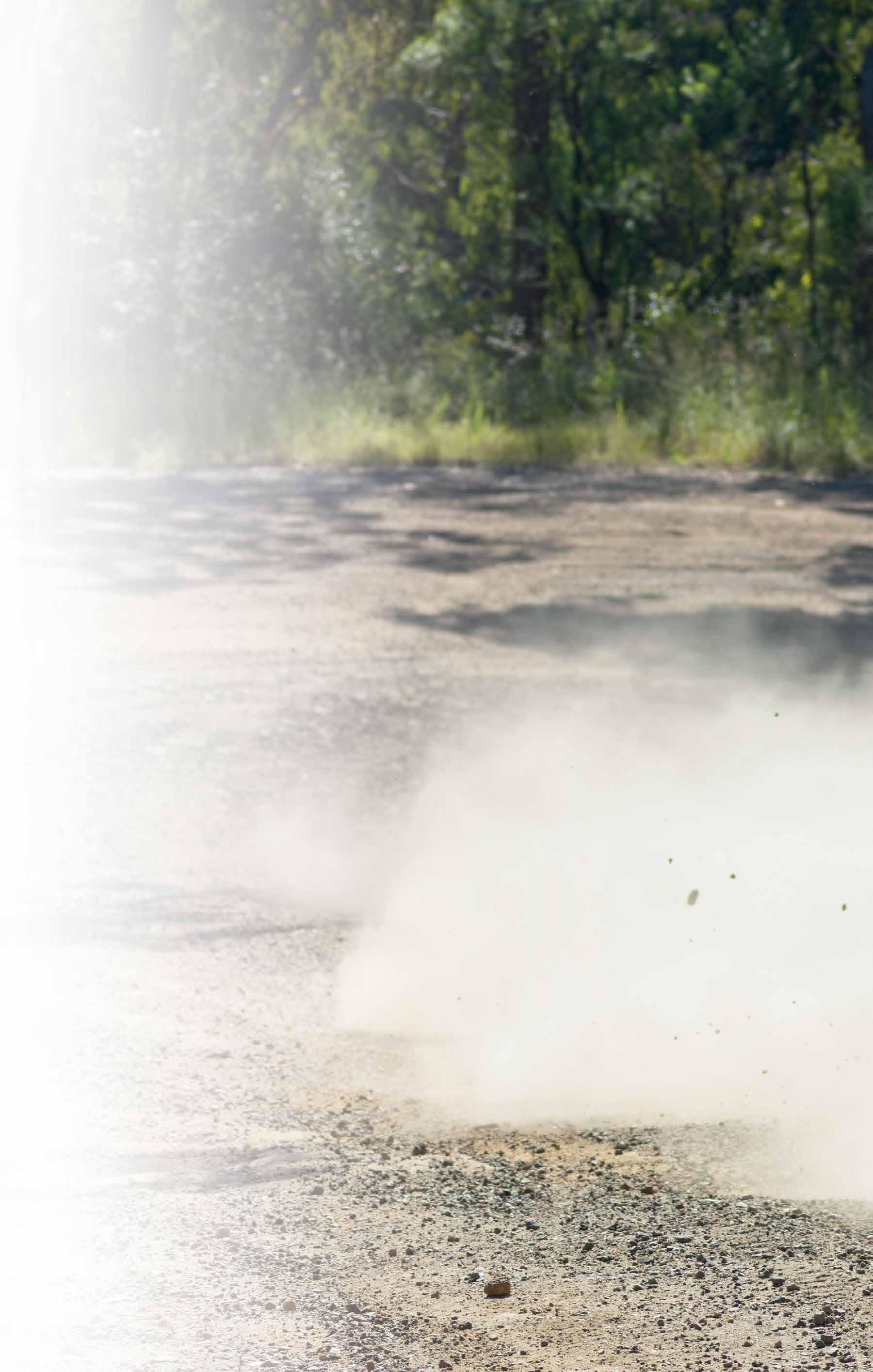

The World Raid ups the long-distance ante with its mighty 23-litre tank, which eclipses the T7’s 16-litre tank by a healthy seven litres. u

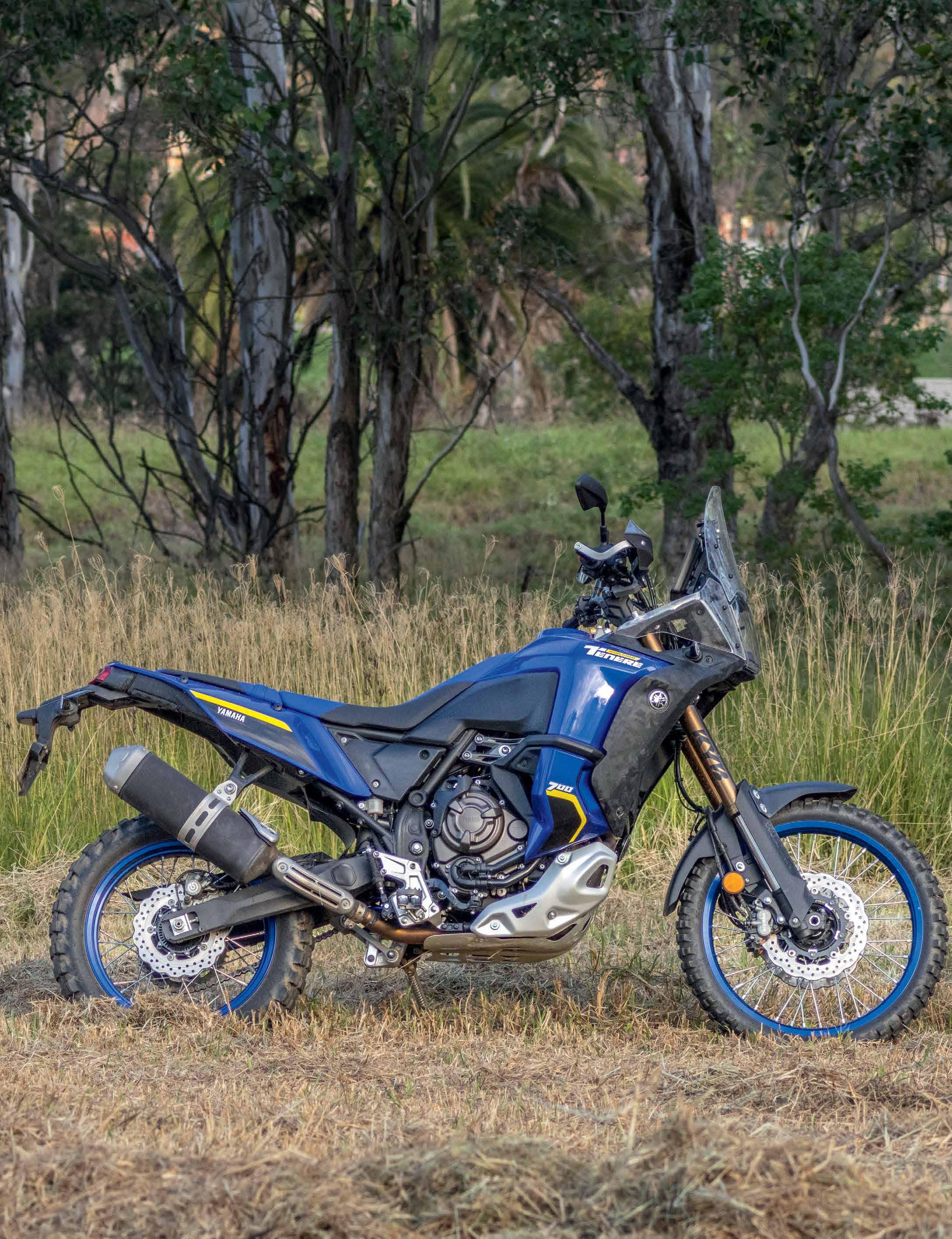
update since its release in 2024, and of course, the World Raid sports the following changes as well. The first thing to catch the eye is the new vertical 5-inch TFT dash, which gives the Ténéré cockpits a cool rally look. There’s a choice of two screen themes, plus Yamaha has added Bluetooth connectivity, allowing you to connect your phone via the Yamaha MyRide app. This feature enables you to see notifications for calls, emails, and texts right there on the screen. You can also track your ride, monitor distance, acceleration, top speed, and elevation changes— more than enough data to keep you entertained.
Both Ténérés also feature an improved
3-mode ABS system, giving you the choice of switching the ABS on at both ends (default), front only, or off at both ends.
“ You can also track your ride, monitor distance, acceleration, top speed, and elevation changes. ”
Then there are some less glamorous updates that are just as handy in the real world. Yamaha has swapped the old-school 12-volt durry-lighter-style
charging port for a USB port, and the Ténérés are now pre-wired for Yamaha’s optional quickshifter.
The World Raid, of course, inherits these new features, but there’s a smorgasbord of other elements that set it apart. Let’s start with the twin fuel tanks, which expand the World Raid’s fuel capacity to 23 litres—seven litres more than the T7’s 16-litre tank. That difference might not seem enormous, but when you’re out there counting kilometres and wondering when you’ll next see a roadhouse, all while carrying old coke bottles full of fuel in your backpack, it’s a game-changer.
The World Raid also features an upgraded suspension package that

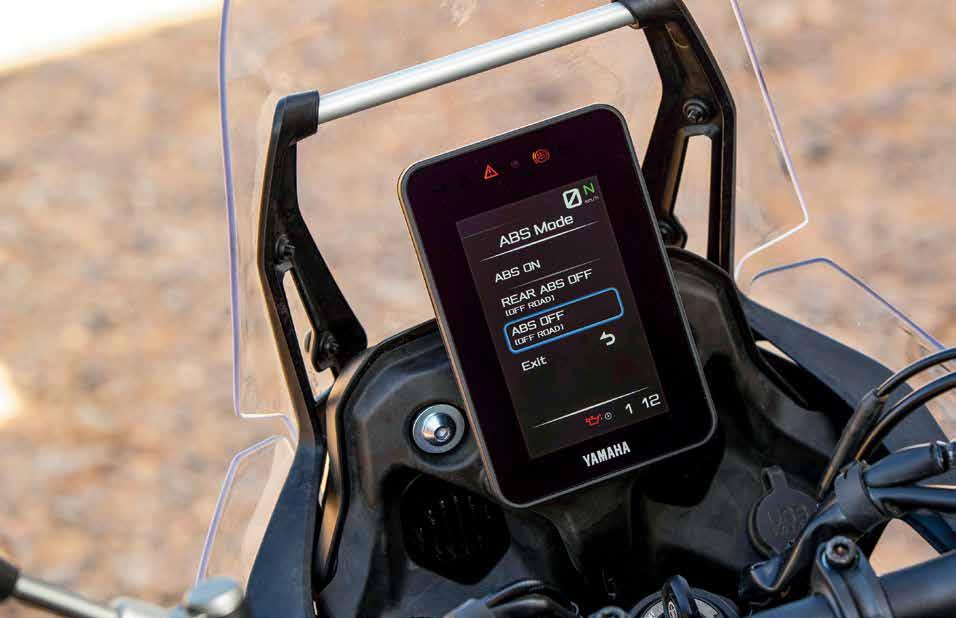

The updated 5-inch TFT display connects to your phone, providing notifications for text messages and incoming calls, among other information.

offers an extra 20mm of travel at each end. The new KYB fork is fully adjustable for compression, rebound, and preload, with a Kashima coating that reduces internal friction. At the rear is a fully adjustable shock with damping, spring rate, and linkage ratios all tuned to handle the extra fuel payload.
Additionally, there’s an adjustable Öhlins steering damper offering 18 clicks of adjustment, larger pegs with removable rubber inserts, a three-piece aluminium engine guard, a radiator grille, and a fuel pump protector.
There are enough differences to be interesting, but they are still, on paper at least, quite similar. So, with the World Raid carrying a price tag that is over $5,500 more than the T7, you may be thinking, “Is it worth the extra bucks?”
There has been some criticism of the T7’s suspension since its release—nothing that can’t be tuned out, but it is the main bugbear of most T7 owners, especially regarding the rear shock. With the updated T7, not much has changed. The T7’s suspension is perfectly fine if you’re taking it easy off-road or cruising the highways, but it’s noticeably softer than the World Raid’s. Once you pick up the pace, the difference in suspension between the two models becomes
acutely obvious. When pushing over big obstacles, tackling rough off-road terrain, or launching it off a drainage ditch, both ends bottom out sooner on the T7. It’s also simply not as composed off-road overall, and even on-road, especially when you have your luggage loaded, the World Raid’s suspension is just a step above—a significant step above!
The World Raid’s front end is superb, especially over rough terrain. The Kashima-coated forks track beautifully, no doubt assisted by the Öhlins damper, while the KYB shock provides a solid and compliant ride. The rear isn’t as sweet as the front end, but where the T7 can feel a little uncomposed in the rough stuff, the World Raid’s rear soaks up everything in a far more civilised and controlled manner.
Where the suspension differences between the two are really thrown into stark relief is when landing a jump. The T7 requires a more managed approach to the jump in question—planning the launch, picking the landing spot with care, and bracing yourself for the harsh landing as you inevitably bottom out at both ends. The World Raid, by contrast, is a far better flying machine. Point it, fly it, and land it! It takes far more effort to bottom out the World Raid, resulting in a much plusher landing—consequently, the World Raid

Wheel Around (Right)
Proper off-road rubber choice isn’t a problem, thanks to the properly sized 21-inch and 18-inch wheels on both Ténérés.
Long John (Far right)
As well as offering better performance than the standard T7, the World Raid also provides an extra 20 mm of travel at both ends of its fully adjustable KYB suspension.


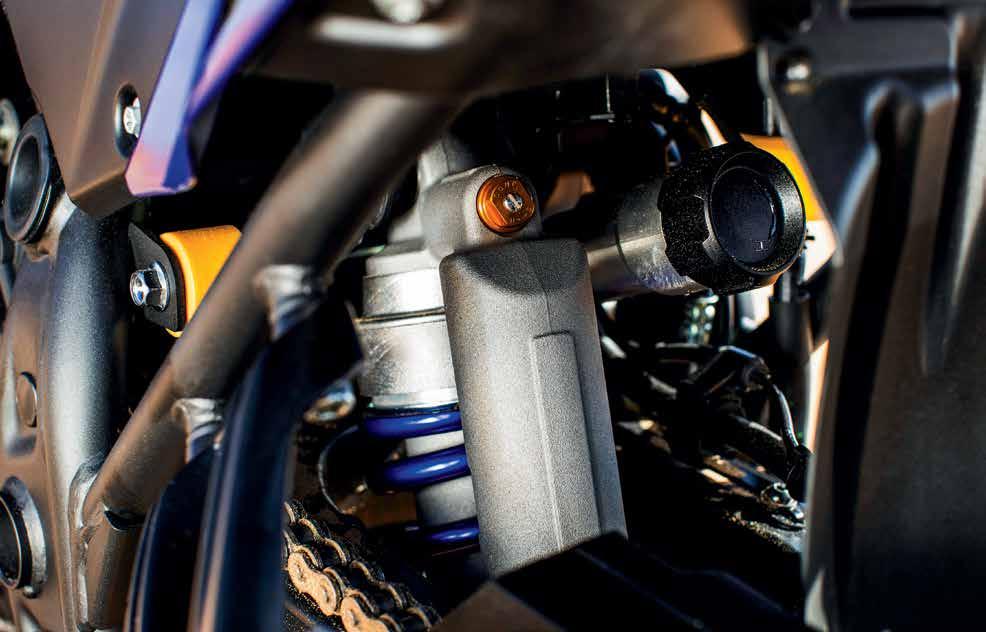

Yamaha’s CP2 engine isn’t the most powerful in the class, but it’s bombproof and sounds good once you flick the standard silencer.


puts the fun back into jumping your Ténéré. It’s no MX bike, obviously, but it’s a pleasure to play on.
That’s not to say that the World Raid’s suspension is without fault out of the box. If I owned a T7, I’d be straight to my local suspension tuner to get the boingers tuned to suit me, and that’s no different with the World Raid.
Now, as you would expect, the other hugely noticeable difference—both visually and in terms of performance—is the different tank sizes. The T7 is noticeably narrower, and you might think that would pay dividends when you hit the dirt, but you’d be wrong. While a slimmer profile is nicer for the most part, the T7
carries its fuel higher, giving it a heavier top-end feel than the World Raid. The World Raid’s twin tanks carry the fuel lower, and you can clearly see that the T7’s tank sits higher. This equates to the World Raid being far better in terms of balance when you’re up on the pegs and picking a line on a slow, technical trail. Both bikes are easy to move around on, but I didn’t feel hindered at all by the World Raid’s larger tank; in fact, it aids the World Raid, making it a better off-road machine because of it.
Both machines are powered by the same 54kW, 68Nm 689cc CP2 parallel twin. Yamaha has been refining this engine for years, not just in the Ténéré,


but also in its MT-07 and R7 road machines, and it shows. It’s a highlight of both bikes: smooth, eager, and tractable, constantly providing consistent and predictable motion to the rear wheel. No, it’s not the most powerful twin in the mid-capacity range, and yes, if you line up against a KTM 890 or even the Aprilia Tuareg 660, you’ll get hosed. But adventure riding isn’t about winning drag races; the CP2 donk is torquey and peppy, with enough poke to get you in and out of trouble. Off-road, I didn’t long for more power or torque; on the highway, however, it would be nice to have more of both, especially when you load up with luggage or a pillion. This longing is eased by the fact that you have, between your legs, one of the most reliable engines you’ll find in a modern adventure bike. Check the forums, check the Facebook pages, and you’ll struggle to find any stories of unreliable Ténéré powerplants or Ténérés in general, for that matter.
Both Ténéré flavours share the same braking package, and there isn’t too much to say here. Both ends are adequate without being brilliant—they simply can’t compare to the Brembo-shod Euro bikes. You’ll get an immediate improvement in power and feel as soon as you get your Ténéré home, dispose of the rubbish rubber brake lines that the Japanese manufacturers still insist on putting on their bikes, and replace them with a set of braided lines.
The ABS system works well; it’s always best to flick it off when off-road, and that brings up one annoyance I have with the system. I nearly always turn ABS off completely when on the dirt, but if it’s
not too challenging, I’ll just shut the rear off. By default, ABS is on at both ends, and if you switch the bike off to grab a drink, check your route, or take a leak, the ABS will be back on when you fire the bike up again. This can be rather interesting if you forget and then grab a fistful of brakes going into a corner, and the ABS has a conniption in the rough stuff. So, remember to reset the ABS before you get going again.
Comfort-wise, both bikes feel quite similar for long hauls. The seat on the World Raid, however, feels a touch comfier. Maybe that’s just me, but on long rides, my backside certainly seemed to prefer it. Wind protection is reasonable, and all in all, both are just fine for hitting the highway and banging out the ks.
It would be nice to have some extra farkles like cruise control and heated grips, but then you’re messing with the simplicity of the machines, which is one of the biggest, if not the biggest, drawcards of Ténéré ownership, is it not?
So, if you’re still wondering which of the two Ténérés is best straight out of the box, I’d have to say that the World Raid is an

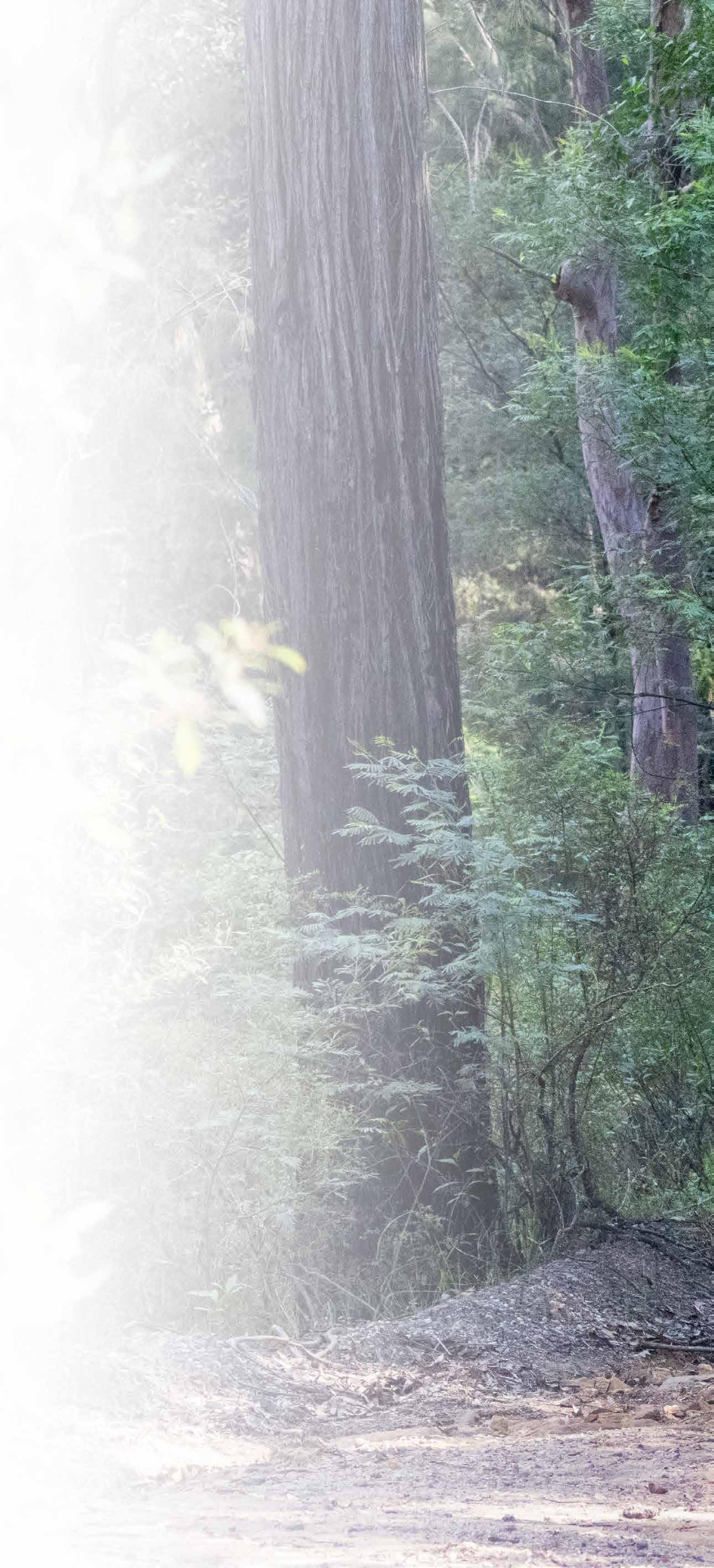
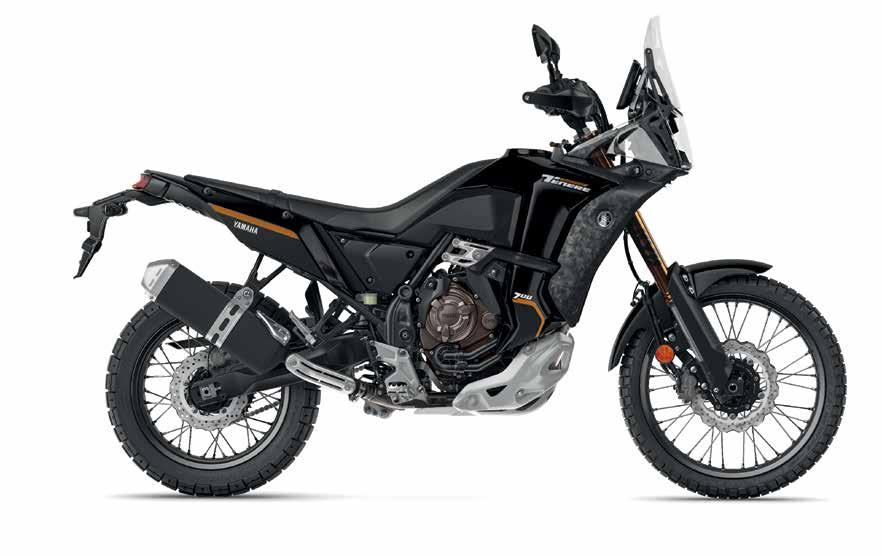
Engine type: 4-stroke, 2-cylinder, Liquid-cooled, DOHC
Displacement: 689cc
Bore x stroke: 80.0 x 68.6 mm
Compression ratio: 11.5:1
Power: 54kW (72.4hp) @ 9,000rpm (claimed)
Maximum torque: 68Nm @ 6,500rpm (claimed)
Lubrication system: Wet sump
Clutch type: Wet, Multiple Disc

Ignition system: TCI
Starter system: Electric
Transmission system: Constant Mesh, 6-speed
Final transmission: Chain
Fuel consumption: 4.3 L/100 km (claimed)
Fuel system: EFI
Frame Type: Double cradle steel tube
Suspension Front: 43mm USD telescopic fork, fully adjustable, 210mm travel
Suspension Rear: Monoshock, fully adjustable, 200mm travel
Brakes Front: Brembo calipers, dual 282mm discs
Brakes Rear: Brembo caliper, single 245mm disc
Tyres Front: 90/90 R21 M/C 54V
Tyres Rear: 150/70 R18 M/C 70V
Length: 2365mm
Width: 915mm
Height: 1455mm
Seat Height: 880mm
Wheelbase: 1590mm
Ground Clearance: 240mm
Fuel capacity: 16 litres
Wet Weight: 206kg (claimed)
Price: $20,349 ride away


Engine type: 4-stroke, 2-cylinder, Liquid-cooled, DOHC
Displacement: 689cc
Bore x stroke: 80.0 x 68.6 mm
Compression ratio: 11.5:1
Power: 54kW (72.4hp) @ 9,000rpm (claimed)
Maximum torque: 68Nm @ 6,500rpm (claimed)
Lubrication system: Wet sump
Clutch type: Wet, Multiple Disc

easy winner—it’s the Ténéré I’d put my money down on. But is the World Raid worth the extra $5,550 ride-away price? Well, no but at the same time, yes. Aside from the improved suspension performance, which I’ll touch on in a moment, the biggest reason to go with the World Raid is the extra 7 litres of fuel capacity that it offers. However, $875 keenly spent with Safari Fuel Tanks will get you a 25-litre tank—a two-litre improvement over the World Raid. If you just can’t get enough seat time in the remotest parts of the bush, then Safari Tanks will sell you a tank that can carry a whopping 45 litres of go-juice. This silo-sized tank will set you back an equally whopping $3,300!
On the suspension front, yes, the World Raid’s pogo-sticks perform better, but if you’re looking for suspension performance that suits your speed, weight, and riding preferences, you’ll be taking either Ténéré to the suspension doctor for a nip and tuck anyway. As for the extra 20 mm at each end, well, I’ll leave that for you to decide whether it is important to you.
I will concede that the bigger tank on the World Raid looks far better than the offerings from Safari Tanks, and those tanks do appear to carry their extra fuel quite high, but looks, at least, are of course subjective.
If you’re the type of rider who will commit to proper suspension setup and fuel range isn’t a big consideration, then the T7 will do you just fine, and the savings can buy you a lot of bling and hot-up parts for your T7. However, if you want the best handling and composed Ténéré out of the box, and you want extra fuel range from a tank that doesn’t look like an afterthought, then the World Raid is king.
Whichever way you go, there is one big thing to remember about both: if you buy a Ténéré of any persuasion, you’ll be purchasing one of the most
Ignition system: TCI
Starter system: Electric
Transmission system: Constant Mesh, 6-speed
Final transmission: Chain
Fuel consumption: 4.3 L/100 km (claimed)
Fuel system: EFI
Frame Type: Double cradle steel tube
Suspension Front: 43mm USD telescopic fork, fully adjustable, 230mm travel
Suspension Rear: Monoshock, fully adjustable, 220mm travel
Brakes Front: Brembo calipers, dual 282mm discs
Brakes Rear: Brembo caliper, single 245mm disc
Tyres Front: 90/90 R21 M/C 54V
Tyres Rear: 150/70 R18 M/C 70V
Length: 2370mm
Width: 905mm
Height: 1490mm
Seat Height: 890mm
Wheelbase: 1595mm
Ground Clearance: 250mm
Fuel capacity: 23 litres
Wet Weight: 220kg (claimed)
Price: $25,899 ride away
capable and reliable adventure bikes the segment has ever seen, and that is always the most important thing when you’re in the middle of the desert, riding a mountain range, or sitting on a sandy riverbank sweating your guts out and swearing like a trooper.


This list is crafted specifically for ADV riding enthusiasts, though many of the items can also work well for other types of riders. We’ve chosen gear that stands out in its category or represents the best of what’s available, with a focus on items that suit the current summer climate. If budget is a concern, consider exploring slightly lower-tier options within the same categories - these recommendations lean toward brand name, high quality and durability, which can some-
First introduced over 20 years ago, the Tour-X lineup of helmets had been crafted to reflect the values of adventure riders, including versatility, comfort, safety, elegance, and endurance.
It’s back with a newly redeveloped model - the Arai Tour-X5, which marks the fifth generation of Arai’s renowned Tour-X helmets. With improved aerodynamics, enhanced ventilation, a redesigned visor system, and ECE 22.06 certification, the Tour-X5 elevates Arai’s ADV helmet line to the next level among a sea of competitors.
Improved airflow in the Arai Tour-X5 has been partly achieved through a redesign of the forehead logo, which now doubles as an air intake. This is complemented by an upgraded chin vent, which they call the “Mouth Shutter,” which has been larger thanks to a stronger shell. The new visor system also features a quick-release mechanism, allowing for tool-free replacement - a practical upgrade for adventure riders on the go.
The peak has been redesigned in a wind tunnel to reduce buffeting at
times mean a higher price tag. It’s worth noting that we haven’t personally tested or reviewed these products, instead, they have been selected through thorough research and community feedback. Lastly, there’s no sponsorship or payment involved in this list - these are simply honest recommendations to help you gear up for your next adventure and help you choose items for your self, a loved one or a friend this Christmas.
higher speeds, a redesigned rear section now featuring a rear spoiler further reduces turbulence. Additionally, a deployable chin curtain can be extended from inside the helmet, adding another layer of aerodynamic refinement that is said to reduce wind intruding from the bottom of the helmet and help prevent the visor from fogging. Combined, the Tour-X5 is one of the most aerodynamic helmets outside of MotoGP-style race helmets.
Arai has long set the standard for high-quality helmets, trusted by adventure riders and motorcyclists world wide. The redesigned sun peak and enhanced ventilation make the helmet invaluable in the Aussie outback, hot days and the sun blasting at you at a low angle is not exactly a rare occurrence here.
The Arai Tour-X5 has 3 shell sizes, comes with a Pinlock, weighs 1735 grams and has an RRP $1,199.95.

Why we love it:
v Build and design quality of Arai is unbeatable
v Improved ventilation and advancements in aerodynamics
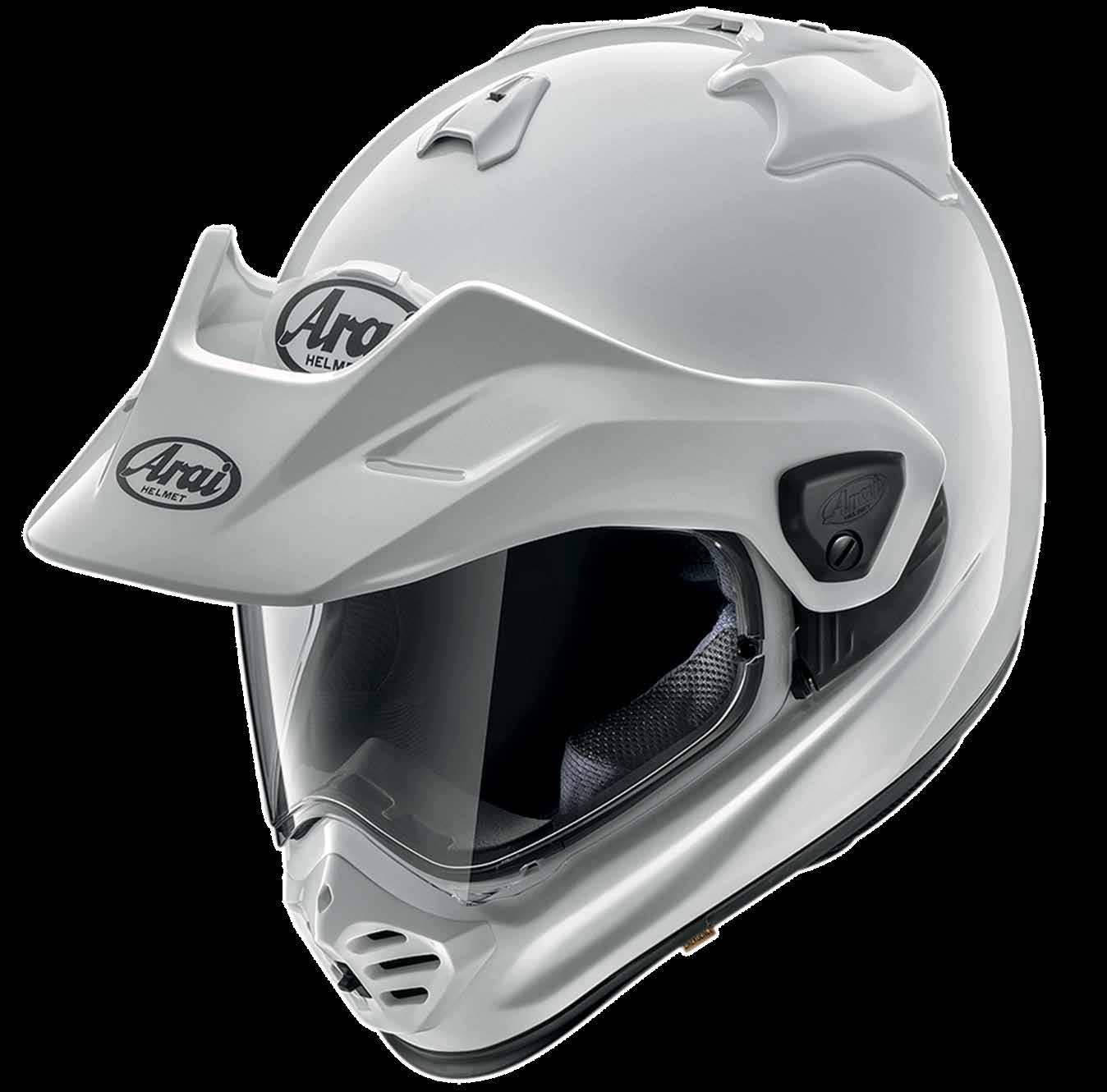
Anewbrand to Australia, Scorpio EXO is the new kid on the block and has a lot to prove, but we think that they might have just done it.
Unique to Scorpion EXO helmets is their “Airfit” system, which is basically an airtight bladder in-between the cheek pads and the shell, that pumps up via a button on the inside of the chin. It also mitigates when the liners loosen over time, ensuring a tight fit even when the inside pads loosen as the years go by.
The internal drop-down sun visor is, personally, a standout feature, setting it apart from many other adventure helmets. Not bad for a helmet that weighs 1500 grams, and it beats having to carry a separate set of glasses. We are not sure why it has taken so long for it to make its way, but we are glad to see more and more ADV helmets come with dropdown visors.
The titanium double D-ring fastener is a premium touch rarely seen at this price point. Depending on how its designed, Titanium will be either lighter but as strong compared to steel rings, or as light yet stronger then aluminium rings.
The Scorpion EXO ADF-9000 has 3 shell sizes, comes with a Pinlock, weighs 1500 grams and has an RRP $749.95.
Why we love it:
v The inclusion of an internal drop-down sun visor
v Lower price without skimping on quality of features
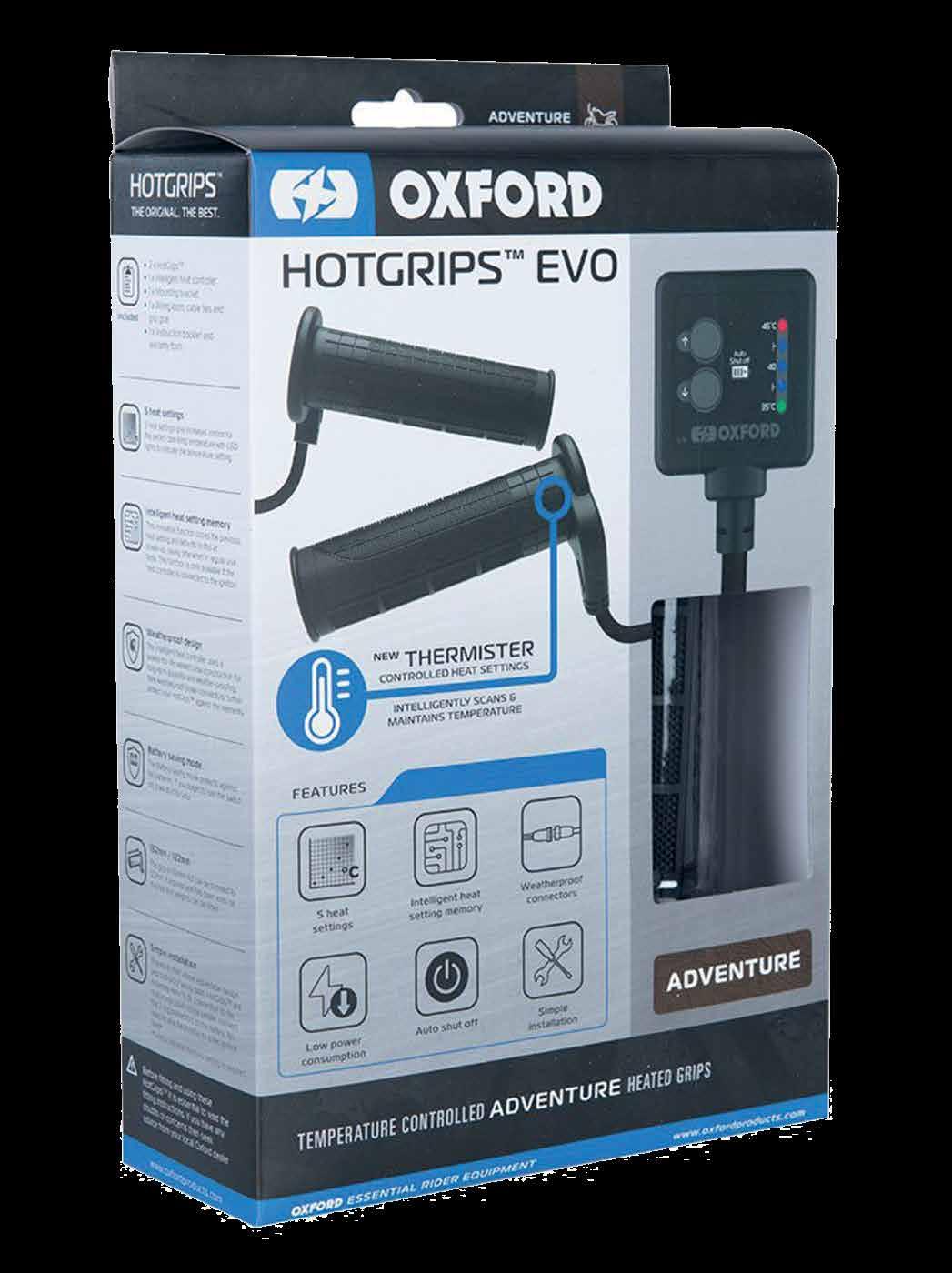

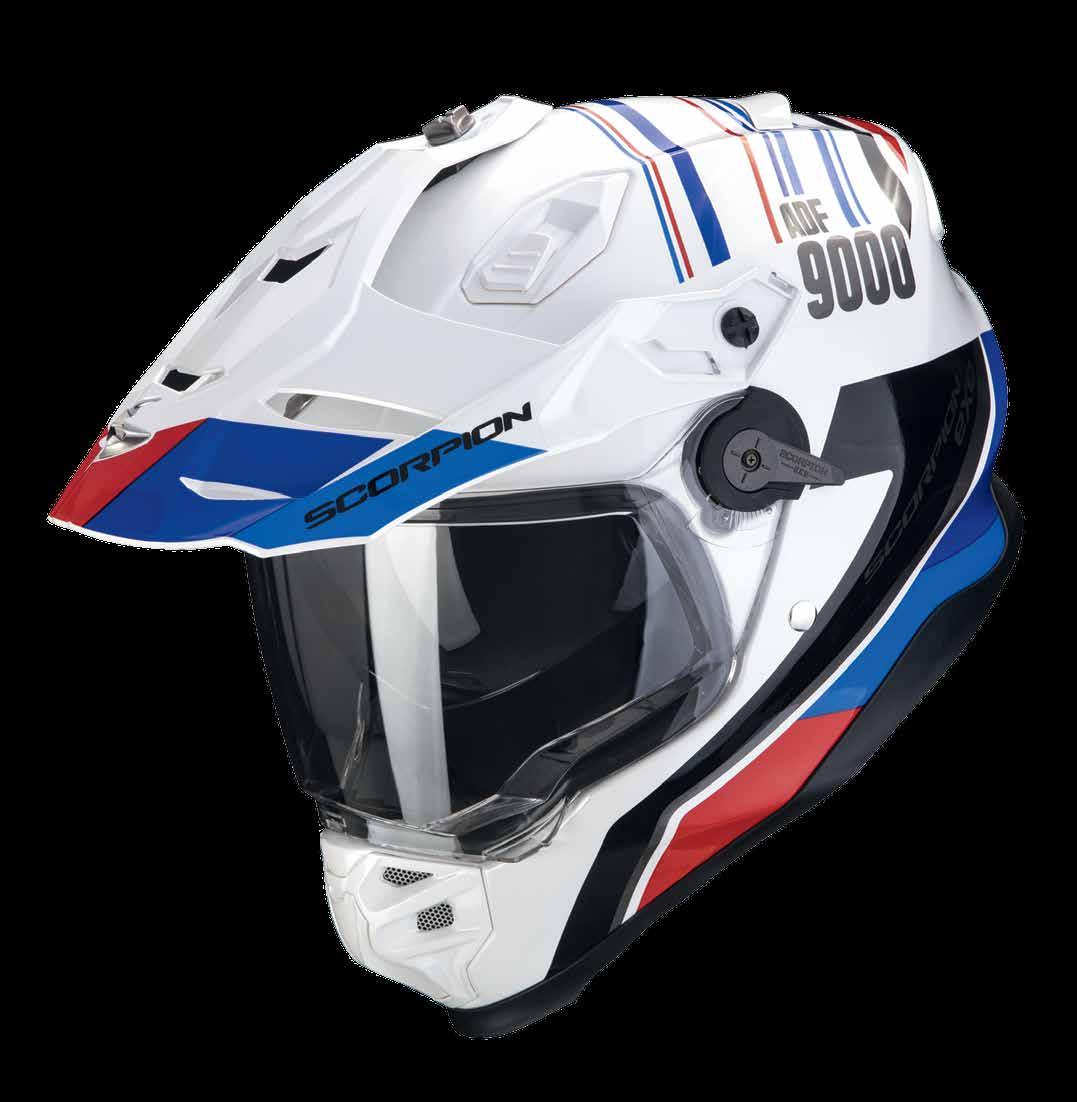
nlike the other gear on this list, this is only for those who ride into the cooler and colder climates. Heated grips are a game-changer, OEM heated grips are usually the way to go if they’re available for your bike model - they integrate seamlessly and are designed specifically for your setup. But if you don’t have that option, Oxford’s universal heated grips are well worth considering.
the temps drop. Keep in mind that in extremely cold weather, heated grips alone won’t suffice - You will get tempted to turn up the heat, and it will make your palms feel nice and warm, but a few centimeters over to the tops of your hands will be absolutely freezing cold. A very strange and very uncomfortable sensation that you will have likely never felt before otherwise. We would recommend to pairing them with hand-
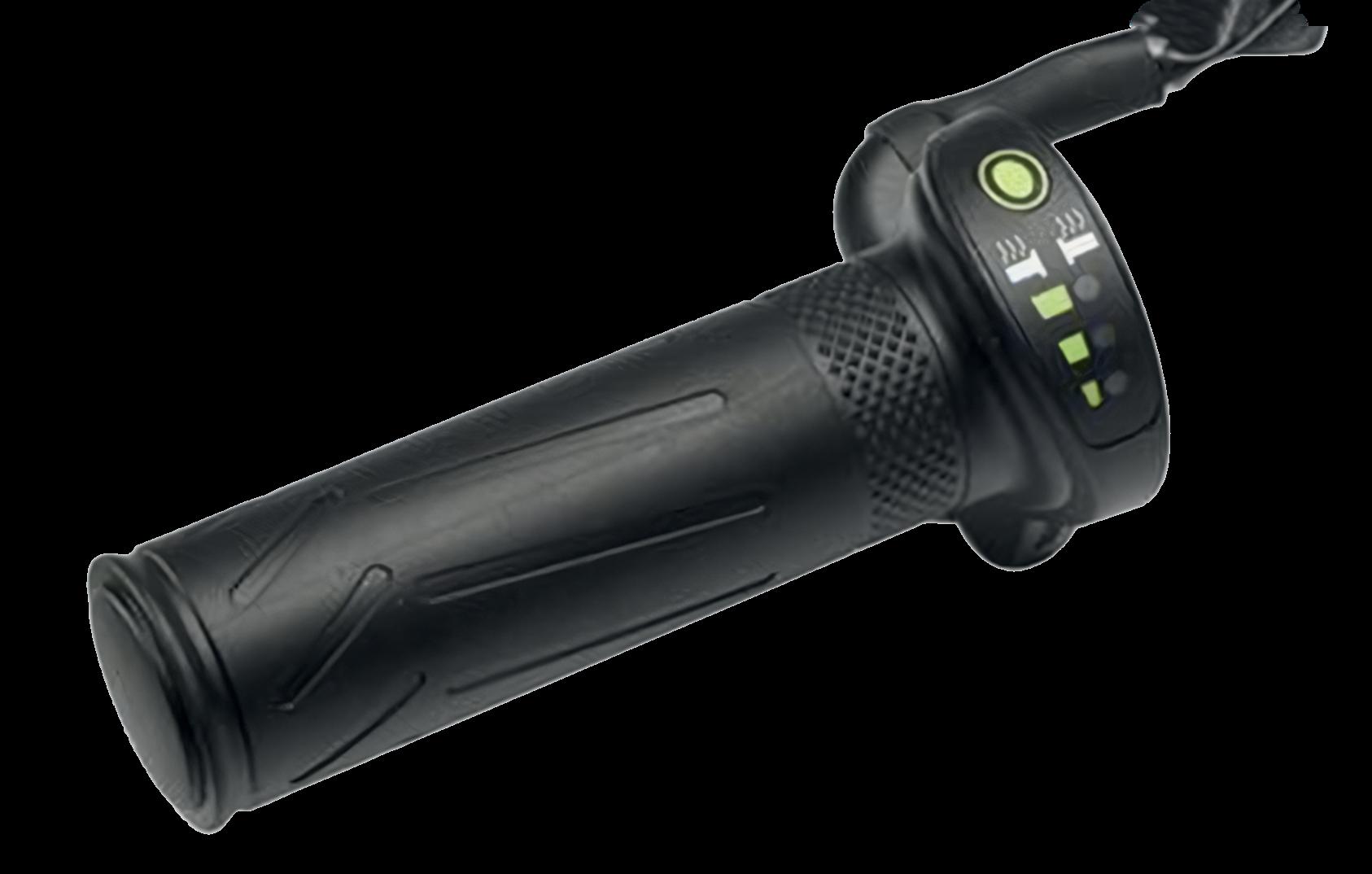

OEM heated grips are generally easier to install and usually has a more integrated functionality and look.
If you’re looking for a versatile ADV setup that can handle a wide range of conditions, the REV’IT Sand 4 Jacket & Pants should be high on your list. This is one of those do-it-all, 3-season gear sets that gets a lot of love in the ADV community for good reason. The three-layer construction is much lighter than the previous model, so it’s better suited for long-distance touring without feeling weighed down.
REV’IT has really dialled in the protection here. You get Seeflex CE-level 2 armour at the knees, shoulders, and elbows right out of the box, and there are pockets if you want to add back and chest protection later. It’s clear the Sand lineup has been built with durability and rider protection as priorities, and it’s a lineup that has a strong reputation in the ADV world.
The jacket’s adjustability is a big win as well. You’ve got a drawcord at the hem, straps on the lower and upper arms, tabs at the cuffs, and the Flexisnap collar to fine-tune your fit. This adjustability is great for getting everything dialled in just right, especially when layering up or down with the detachable thermal liner. The outer shell is made from 3D air mesh, which is a smart choice since it’s a highly breathable material with a 3-dimensional structure that promotes airflow. This is exactly what you want for long rides in variable conditions.

As for ventilation, the Sand 4 really shines. It has large ventilation panels on the front and back and generous zippers on the sleeves that you can open up when things get warm. This setup works well in both hot and cold weather, and the airflow is impressive. When it cools down, just add the thermal liner, which packs down small and can be stored in a pannier or backpack.
The pants are just as functional, with a Hydratex waterproof membrane and an insulated winter lining to keep you warm and dry when the weather turns. REV’IT also added polyester and ripstop patches on the bum area to keep you from sliding around, which is a nice touch when you’re navigating off-road sections. Waterproof pockets add extra practicality, and the reflective trim on both the jacket and pants is a great safety feature for increased visibility at night.
At an RRP of $849 for the jacket and $599 for the pants, the REV’IT Sand 4 setup is definitely an investment. But if you’re serious about ADV riding and want gear that can handle a variety of conditions without skipping a beat, it’s a worthwhile one. This set is designed for riders who don’t want to be limited by their gear, whether you’re doing a cross-country tour or just hitting up weekend trails.
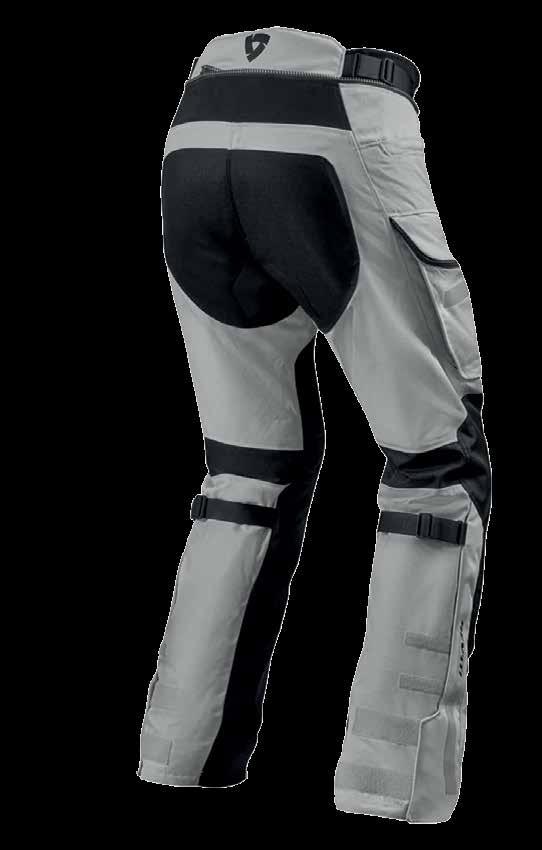
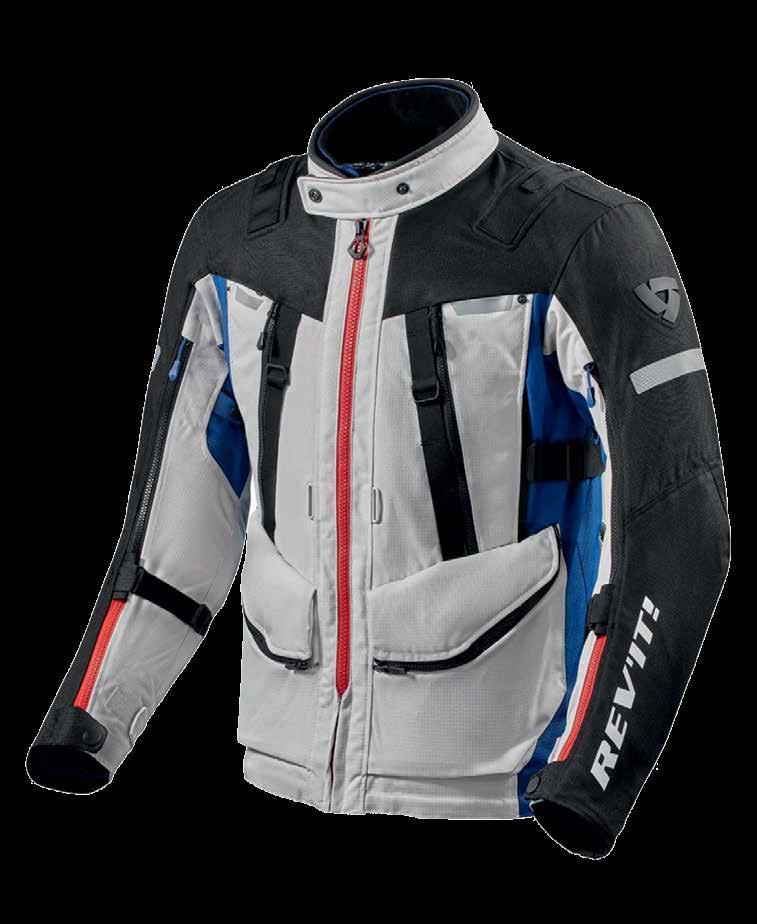
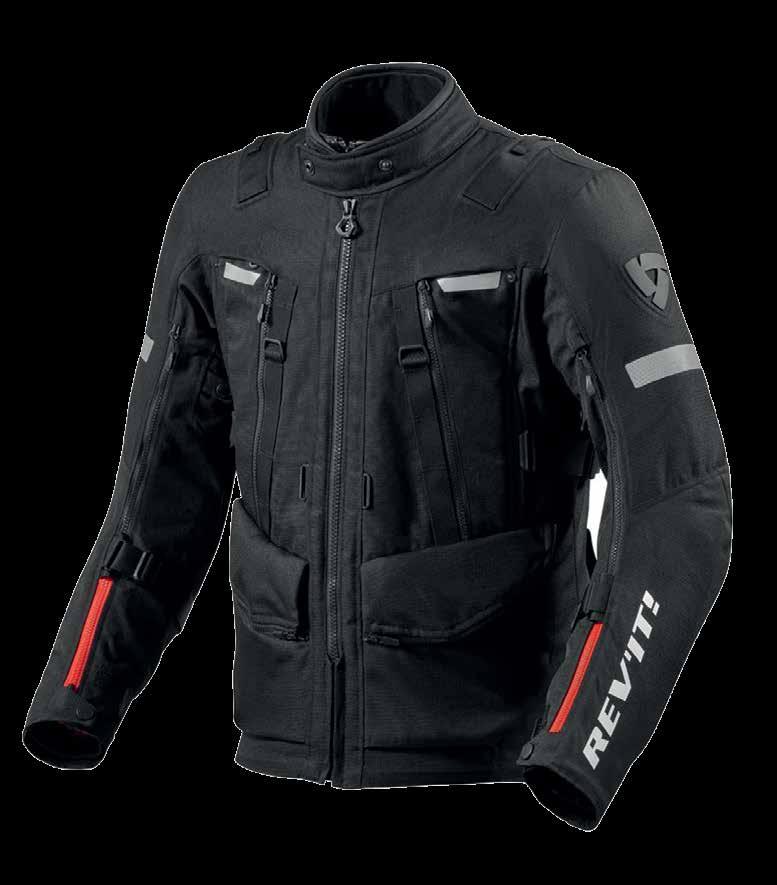

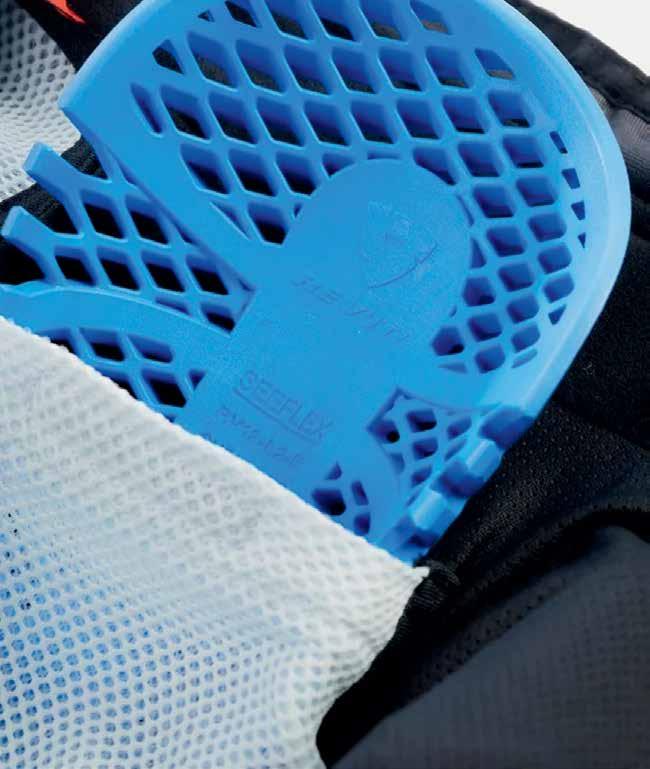

Why we love it:
v The rugged and do-everything nature of the Sand 4
v Revit armour is extremely thin and flexible while being CE-level 2 rated Seeflex CE-level 2 armour
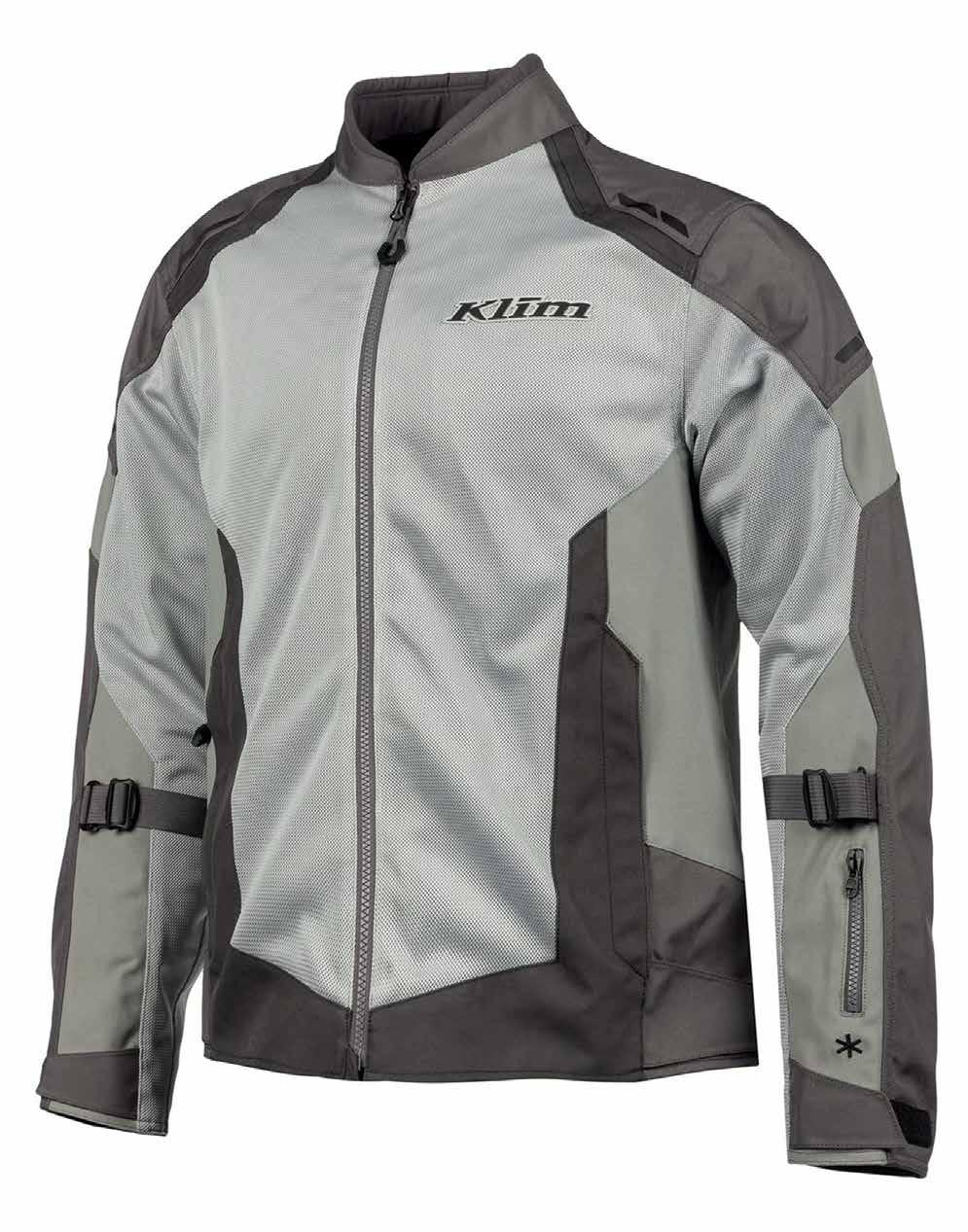
For riders in hot climates or looking to maximize airflow, the Klim

Why we love it:
v Unmatched ventilation for hot weather
Induction Jacket & Pants combo is an excellent choice. This setup is fully focused on ventilation, making it a top-tier warm-weather option. The entire jacket is built for airflow, with vented areas on the chest, back, and arms, so it’s perfect if you’re riding in high temperatures. Just keep in mind that this jacket is so highly vented that it’s strictly a warm-weather piece – it makes no qualms about making you want to be comfortable in colder conditions.
The Induction jacket is made from Klim’s Karbonite mesh, a strong and durable material that holds up well in terms of abrasion resistance while still letting air through. It’s also CE AA rated and certified to en 17092-3, which is great for peace of mind. Klim’s attention to detail with the YKK zippers and overall build quality really shows; this gear is made to last, even with the lightweight design. And the best part is that Klim has redesigned this line to be even more comfortable and flexible, which is a huge plus on long rides.
One of the standout features is that it comes with D3O protectors and a back protector included, so you’re set right from the start. These protectors are known for being both protective and flexible, so you’re not sacrificing comfort for safety. The jacket also features reflective trim around both the jacket and pants, which is a thoughtful touch for those late or early rides where visibility matters.
Sizing is inclusive, from XS to 4XL, so there’s a good range for different body types. And while the Induction set isn’t the cheapest option at $679 each for the jacket and pants, you’re paying for Klim’s quality and reputation, which is well-established not only with motorcycles, but also with snow and off-road gear markets.

v Klim has a stellar reputation for producing ADV gear that is built to last
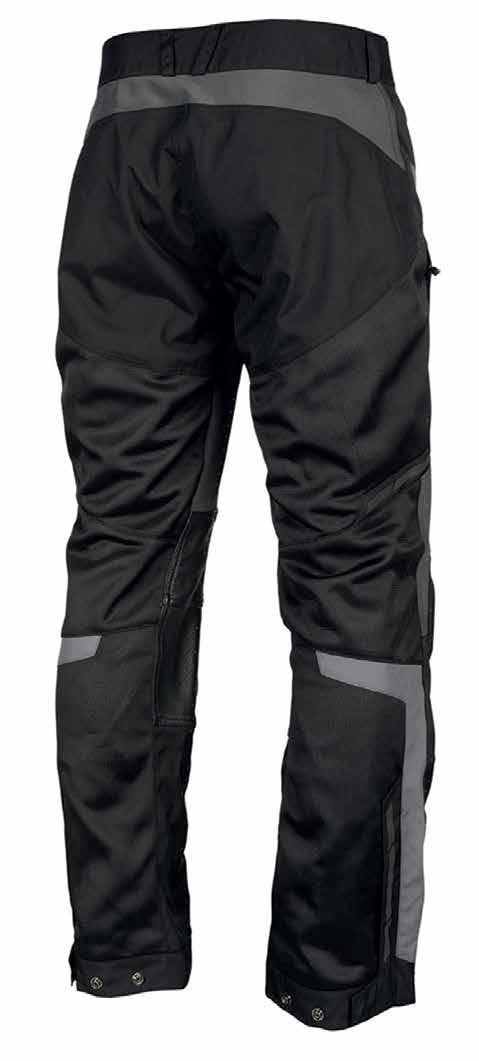

If you’re already a fan of the KLIM Induction Jacket & Pants, the KLIM Induction Gloves are the perfect companion to round out your gear. They bring all the same airflow and lightweight benefits, designed for warm-weather riding but with a focus on protection and comfort.
First off, these gloves are super easy to get on and off. KLIM added loops to help pull them on, and a zipper paired with an adjustable Velcro strap means you can get a snug fit quickly. The goat skin leather makes them feel soft but durable, and the gloves stay light and flexible, so you don’t lose any movement or dexterity. The fingers and palms are pre-curved, too, so it should start feeling like a second skin the moment you put it on, and it won’t require as much breaking in compared to other gloves.
Protection-wise, KLIM didn’t skimp. There’s a carbon fibre plate over the knuckles to take care of impact protection, which is reassuring when you’re pushing through trails or hitting high speeds. Exterior stitching on these gloves means no pressure points or uncomfortable seams digging into your hands.
Some neat functional touches: they added a small wiper blade on the left index finger for clearing your visor in the rain (such a lifesaver in wet conditions). And since we’re all glued to our devices, there’s a touch screen-compatible finger. It actually works pretty well, which is a nice bonus for checking maps or quickly snapping a photo.




For anyone looking at serious ADV riding, the SIDI Adventure 2 Gore boots hold up to a pretty high standard. These are built with high-tech microfibers, suede, Cordura nylon, and Gore-Tex, so you’re getting top-notch materials and construction (which, honestly, is what you’d expect for $650). They are advertised as 100% waterproof, so your feet stay dry even if you’re slogging through puddles or caught in rain.
The Adventure 2 boots are known for being warm, so they might not be the best option if you’re mostly riding in hot weather. To help with that, it’s worth investing in some Merino wool or Cool-Max socks. They can help a bit with ventilation and prevent your feet from overheating.
Comfort-wise, these boots are surprisingly good for longer rides, and they don’t feel too stiff for walking around off the bike. Sure, they’re not hiking boots, but they should hold up for medium-length walks, and the design supports you while standing on the pegs, which is huge for ADV riding. They’re designed for all-around adventure riding and definitely hold their own for long-range comfort.
Sizing ranges from 41-50. The fit feels secure and supportive, which is nice when you’re tackling uneven terrain and don’t want any wiggle in your boots. Just keep in mind that these are all-around adventure boots, not necessarily made for hot weather, but they’ll handle everything else with ease.

Why we love it:
v Designed for long rides and all-day comfort on and off the bike

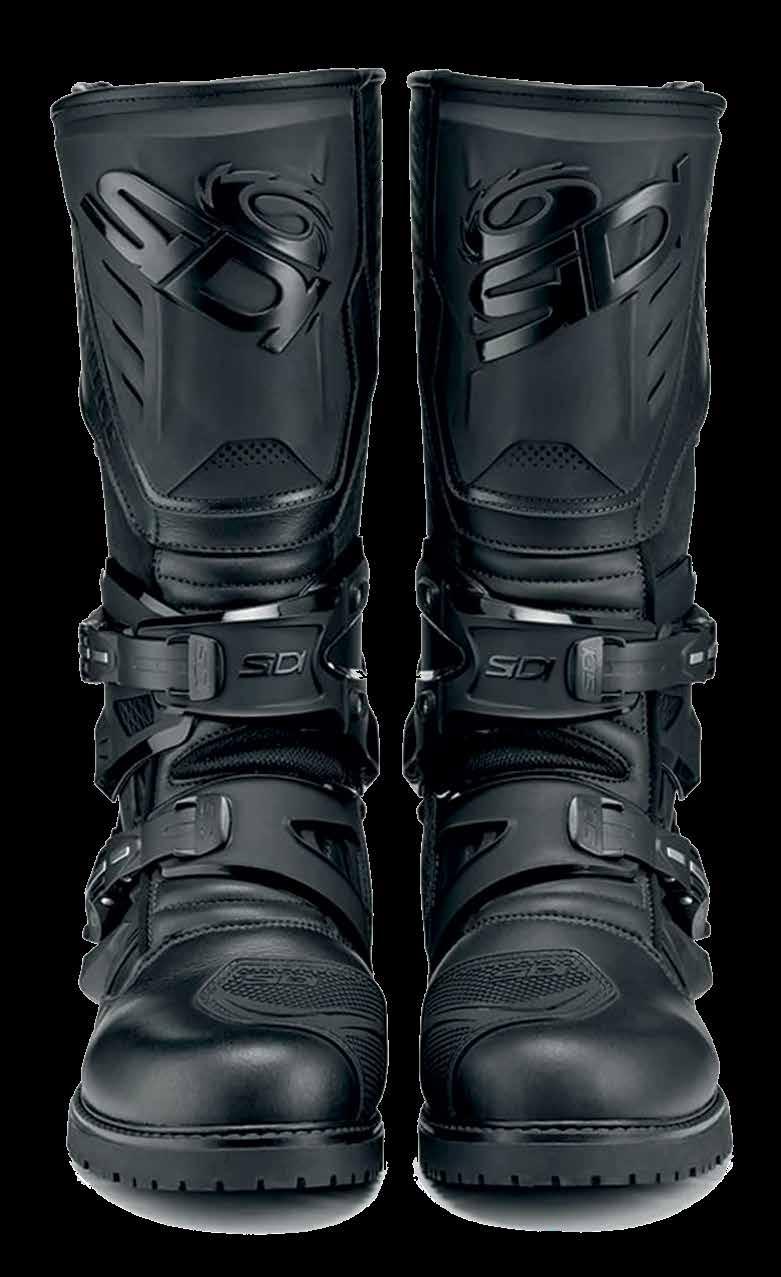

v Made of premium materials including water-resistant Gore-Tex lining

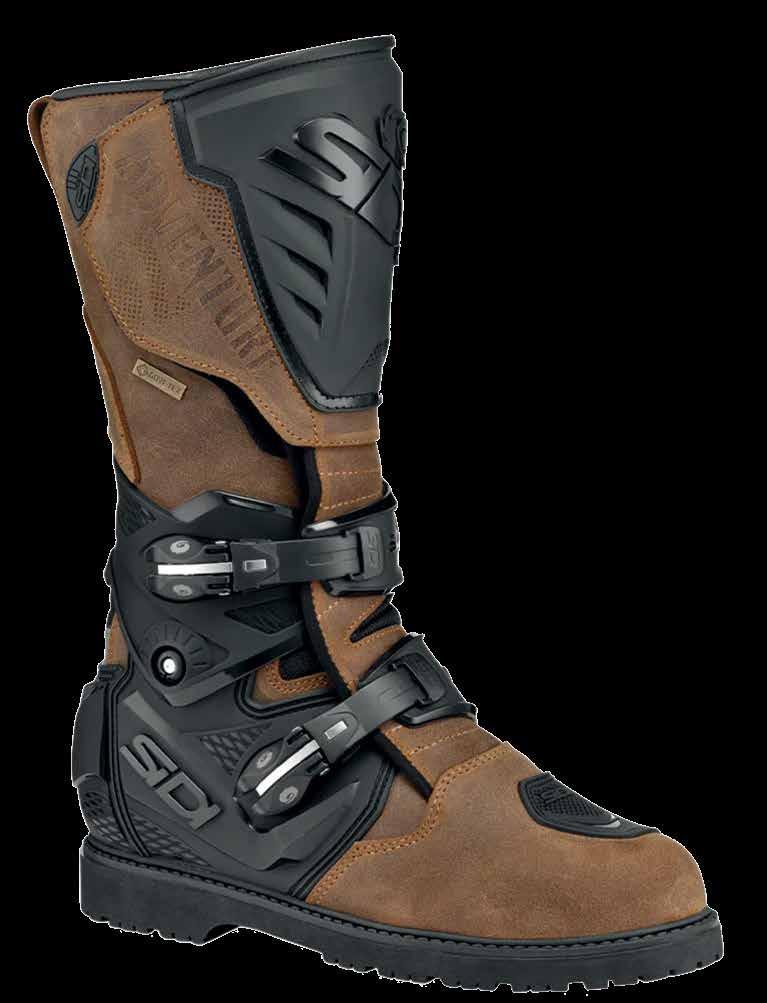
Moto-vlogging is a growing sub-niche/sub-culture for motorcyclist and we can see why. It adds a layer of fun, and gives people who have never ridden before a point-ofview shot of what it looks like to ride.
Having a camera rolling while you ride lets you document the journey as it happens, which makes it way easier to relive those views and moments, and captures a little slice of the pure freedom of the ride.
The Insta360 X4 captures everything - literally. With its 360-degree recording, you don’t have to stress about setting the perfect angle before a ride. Just mount it in the right position, hit record, and worry about framing the shot later.
The 8K resolution is uniqe in its class and lets you zoom and crop your footage like it was shot with a traditional camera. Want some slow-mo action? You can record
Plus, with a helmet mount setup, you can capture high-quality photos and videos without stopping all the time. Share them with friends, family, or your social media followers, and they’ll feel like they’re riding alongside you. Moto-vlogging also gives you a new way to connect with the riding community online, and you’d be surprised how many tips, advice, and even new friends you can make just through sharing your adventures.
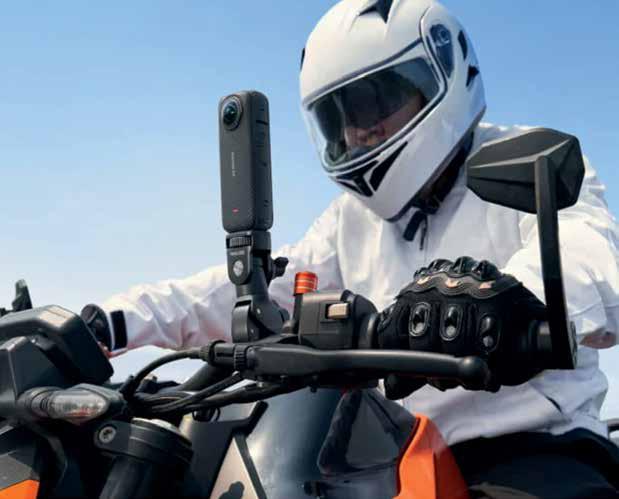
at 100fps even at 4k for smooth playback. There are motorcyclespecific bundles available too, so finding the right mount for your bike is easy.
We recommend to grab the optional lens guard to protect your investment because, well, debris happens on the road. The AI-powered editing app is also a win - it’ll handle the tough parts of editing and spit out sharable clips for you in no time.
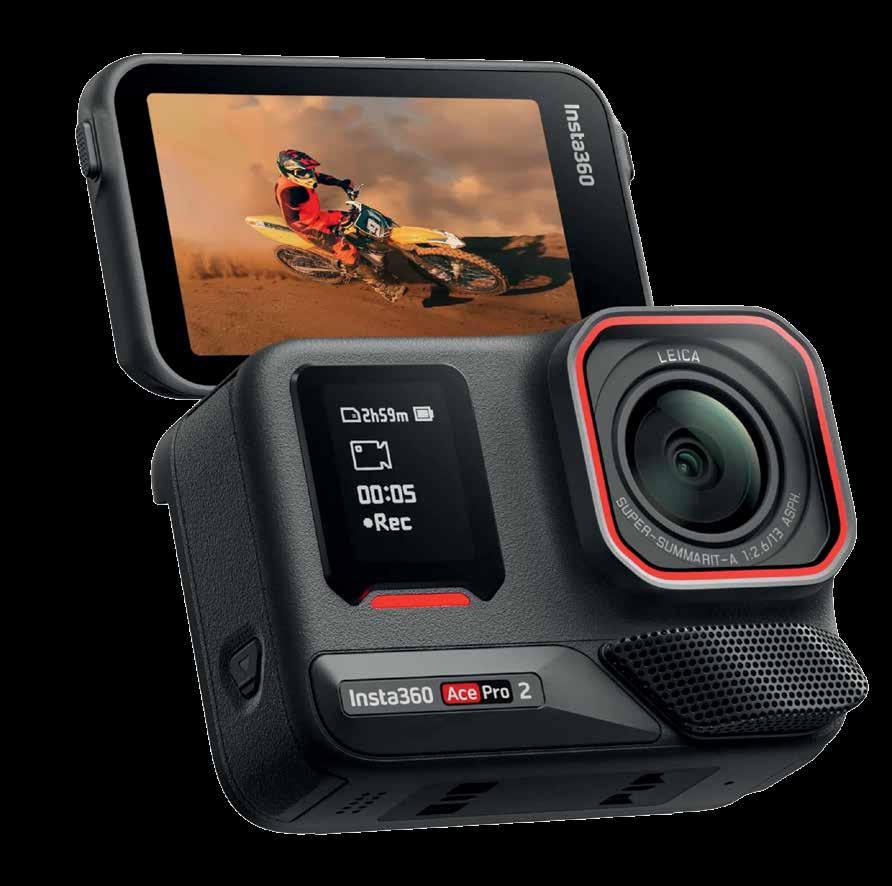
InSTA360 ACe PRo 2
Looking for something a bit more traditional and also performs like a champ in low-light conditions? The Insta360 Ace Pro 2 delivers. Thanks to its larger 1/1.3” sensor, it captures more light than most other action cameras,


making it much more usable for night riding footage. That is also thanks to the dual AI processors onboard that further processes the image for better quality. You’ll be recording well after sunset while others pack it in.
It offers the same 8K option and 4K records at 120fps, but what stands out is the 157° wide-angle capture. It gets more of you, your bike, and
the scenery in the frame.. Plus, the included wind-guarded mic ensures your audio doesn’t sound like a your in the middle of a hurricane that it otherwise would sound like.
And just like the X4, the Ace Pro 2’s app makes editing a breeze with automatic short-clip generation, so you can focus on the ride, not the post-production.

Intercoms are absolute game-changers for anyone who rides with friends, a group, or even a pillion. Being able to stay connected on the road makes things so much easier and way more enjoyable. There is much less planning and contingency planning needed since you can communicate in real-time, which takes out the guesswork on where to turn, when to stop, or if something goes wrong. It’s also super helpful to stay in touch with a pillion - they’ll feel safer and more comfortable if they can talk to you (but we know plenty of riders who would rather not!).
Another big plus? Entertainment. Most intercoms let you connect to your phone, so you can listen to music, podcasts, or even an audiobook to make those long solo rides more palatable. Some models even include FM radio, so you can listen to local stations. And if you’re into voice commands, most intercoms will let you use voice control on your phone, which is a nice hands-free bonus.
One of the main drawbacks is compatibility. To get the best, most reliable connection or to be even able to get everyone connected at all, everyone in your group typically needs to be on the same intercom brand. However, if you’re only pairing with one other rider, many intercoms support basic Bluetooth connections, so you might be able to mix and match if needed.
The cost is also worth mentioning - good intercoms, especially those built for group riding, can be pricey. We’d suggest keeping an eye out for sales or deals if you’re looking to add an intercom to your setup without breaking the bank.
The Cardo Packtalk Pro is packed with features, including crash detection that can automatically send for help in case of an emergency - what they call a “silent guardia”n. With its 2nd Generation DMC, it provides seamless group connectivity with a range of up to 1.6 km (1 mile), plus it’s auto-healing so it reconnects riders who may have fallen out of range. Attaching and detaching the intercom to the mount is a breeze thanks to the “Air Mount,” which uses magnetics. The Packtalk Pro also includes voice command functionality, so you can stay hands-free on the road. With IP67 waterproofing, 45mm JBL speakers for loud and clear audio, and a twohour charge providing 13 hours of talk time, it’s built for the long haul. MSRP $799, with a 3-year warranty to back it up.

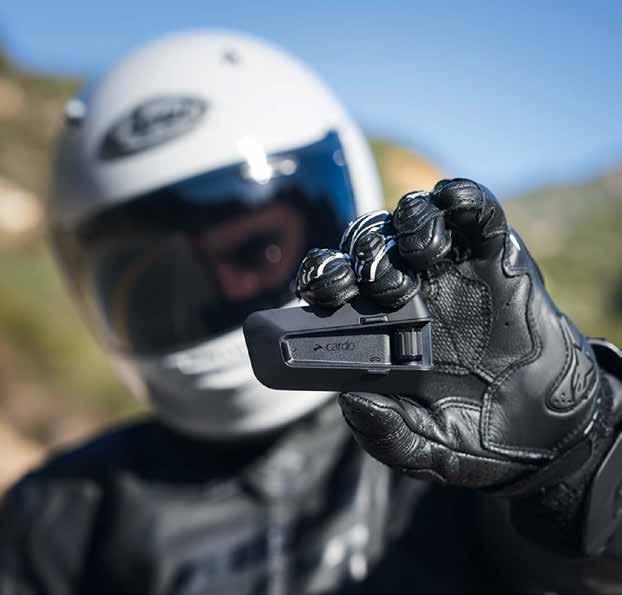
For riders looking for high-quality sound and a reliable connection, the Sena 50S is another top pick. Featuring SOUND BY Harman Kardon speakers, it delivers clear audio and good voice quality. It has quick setup for group rides, with an Easy Mesh connection that lets you connect to the open Sena mesh network with the press of a button. With a range of up to 1.6 km (1 mile) for group rides, it’s built for those longer, collaborative journeys. The 50S also has impressive battery life: one hour of charging gives up to 9 hours of Mesh talk time or 14 hours of Bluetooth talk time. MSRP $549.


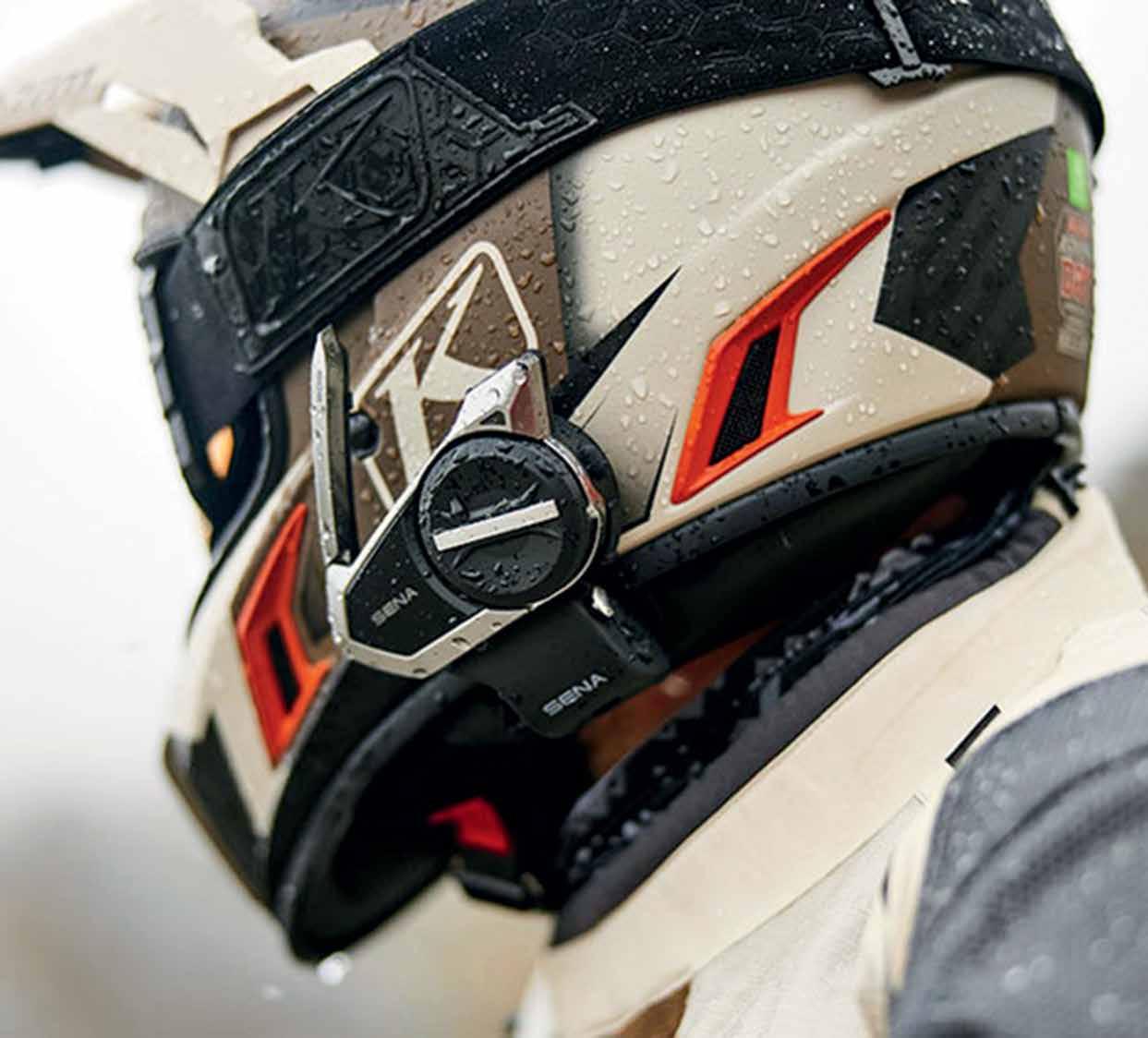
If you’re looking for versatile and durable soft luggage for adventure riding, the Kriega Universal Fit Tail Bags are a solid choice. These bags have a sizing range from 5L to 40L, giving you plenty of flexibility based on the length and demands you seek. For most light adventures, a single 20L or 30L tailbag is ideal, providing ample space without making the rear section too bulky. The RRP for those sizes is $275 and $315 respectively - not the cheapest, but you’re getting very good build quality and 10-year guarantee for your money. One of the best features of the Kriega tail bags is their almost universal fit and modular design. They’re designed to work with most bike setups, and Kriega even offers a “Fit Kit” for bikes that are typicallychallenging to mount on, like certain Ducati models and the Tenere 700. Kriega has engineered these to integrate easily with other Kriega bags, which means you can stack them on top of each other if you need extra space, or if you upgrade to a larger
Lock has quickly become one of the go-to choices for securely mounting your phone to your bike. It’s especially popular with riders who use their phone as a GPS, and it’s easy to see why - their system has a reputation for being one of the most secure phone mount options out there.
One thing to note is that Quad Lock offers a range of mount options, handlebar, brake reservoir, and mirror stem mounts, just to name a few. Each one is sold separately, so you’ll need to buy the specific mount that want for your setup. For most riders, the handlebar mount seems to be the most common choice, and it’s also their top seller. Installing it is quick and straightforward; it should only take a 10-20 minutes to get it all set up and ready to go.
One essential add-on that is a must-consider is the vibration dampener. This is a must-have in our opinion, especially if you have a phone with optical image stabilisation (OIS), which many do these days. These OIS systems are so easily damaged by vibrations caused by motorcycles, so the dampener provides some extra protection that’s well worth the investment.
Quad Lock also offers a wireless charging add-on, which is such a good convenience. Just mount your phone, and it starts charging - no need to fiddle with cables before you ride or worse, fiddle mid-ride when you realise your phone is running out of charge. If you’re looking for a budget-friendly charging option instead, you could opt for a 12V to USB adapter, running a cable from your battery to your phone for a DIY solution.
One thing to keep in mind - you’ll need to use Quad Lock’s proprietary phone cases. They’re durable and impact-resistant, made from a rubber that’s easy to grip, so it’s not a bad trade-off. However, it does mean that if you upgrade your phone, you’ll also need to get a new case, and you will be invested in their ecosystem.



bag, you can mount the old one on top. Another nice touch is that they come with adapters for mounting on the tank, they are sold separately but they give you more mounting options. And if you need a bag that transitions off the bike, the 20L and the 30L sizes comes with a shoulder and waist strap so you can carry it like a backpack. The removable internal white liner makes it easy to keep clean and find items inside, while the YKK waterresistant zips and Kriega’s guarantee of water resistance mean your gear should stay dry in all but the worst downpours. These bags are made from 420D Cordura Lite fabric, so they’re lightweight but strong. The 10-year guarantee doesn’t hurt, either - Kriega stands by its products, which is a big reason they’re so respected in the ADV riding community. For riders who want a highly adaptable, rugged tail bag with options for stacking and compatibility across bike models, the Kriega Universal Fit Tail Bags are definitely worth considering.

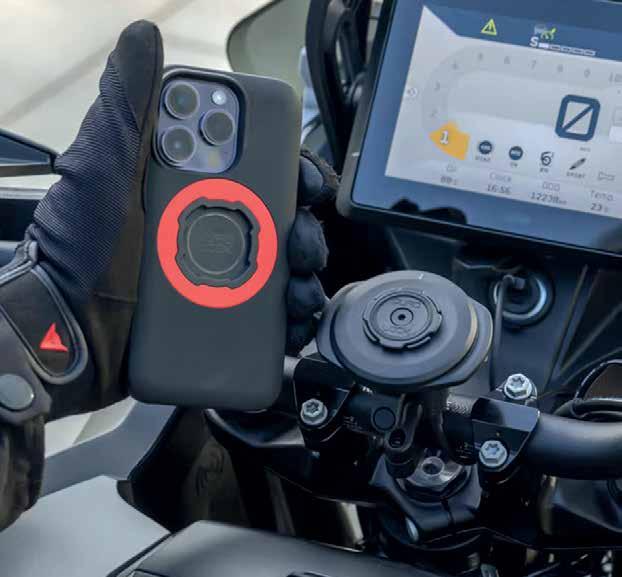


Key chains make for good stock stuffers for Christmas. Rubber or soft material key chains are ideal because they won’t scratch your tank or other surfaces when dangling.

Riding without ear protection? Big mistake. Some do. Wind noise on the highway is no joke. Aside from the obvious, constant exposure subliminally makes you more tired, more susceptible to a crash and not to mention the long-term damage it can do to your hearing.

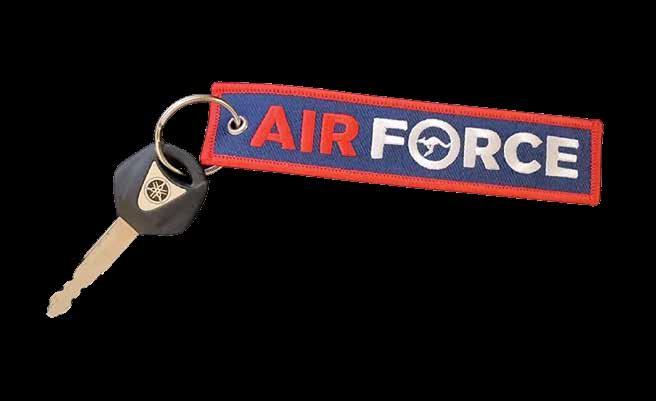
A good pair of earplugs, like the NoNoise Ear Plugs, are a solid choice. They’re specifically designed for motorcyclists, with a special filter inside that cuts down on the wind noise frequencies while still letting frequencies that would come from traffic, sirens and intercom pass through easier. Wear them enough times and they become cheaper then constantly buying disposable ear plugs.





Clear vision is critical, and visor cleaning sprays or wipes are perfect for maintaining a streak-free visor. Bonus points if the cleaner comes in a travel-friendly bottle that can be tossed in a jacket pocket or tank bag. Something like the Muc-Off Visor Cleaner is perfect for quick cleanups on the go. It’s compact enough to fit in a pocket or tank bag, so it’s always there when they need it. This one works on helmet visors and even goggles, and it’s safe to use on anti-fog coatings too. Pair it with a microfiber cloth, and it’s a lifesaver for keeping their view crystal clear after riding through bugs, dust, or rain.



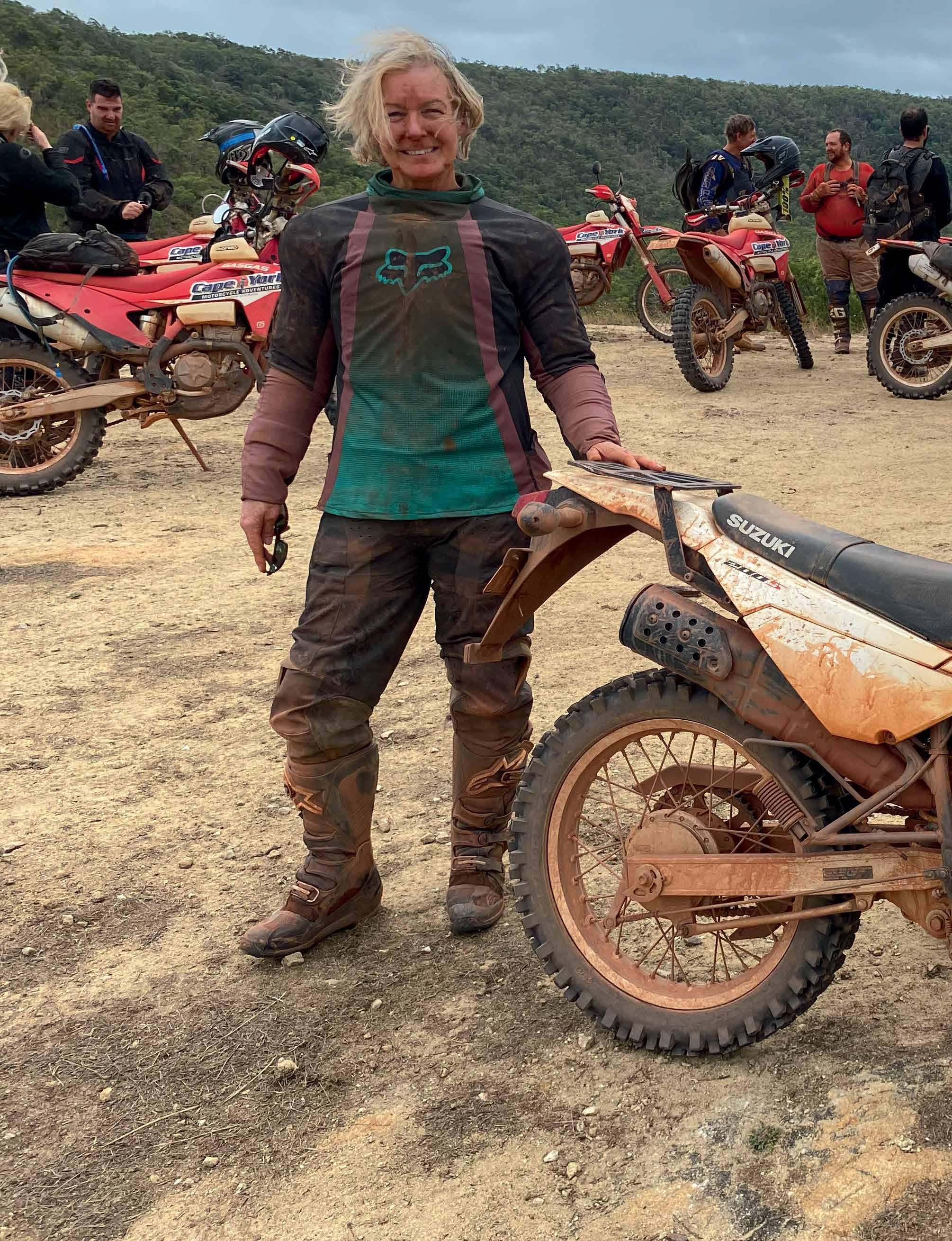
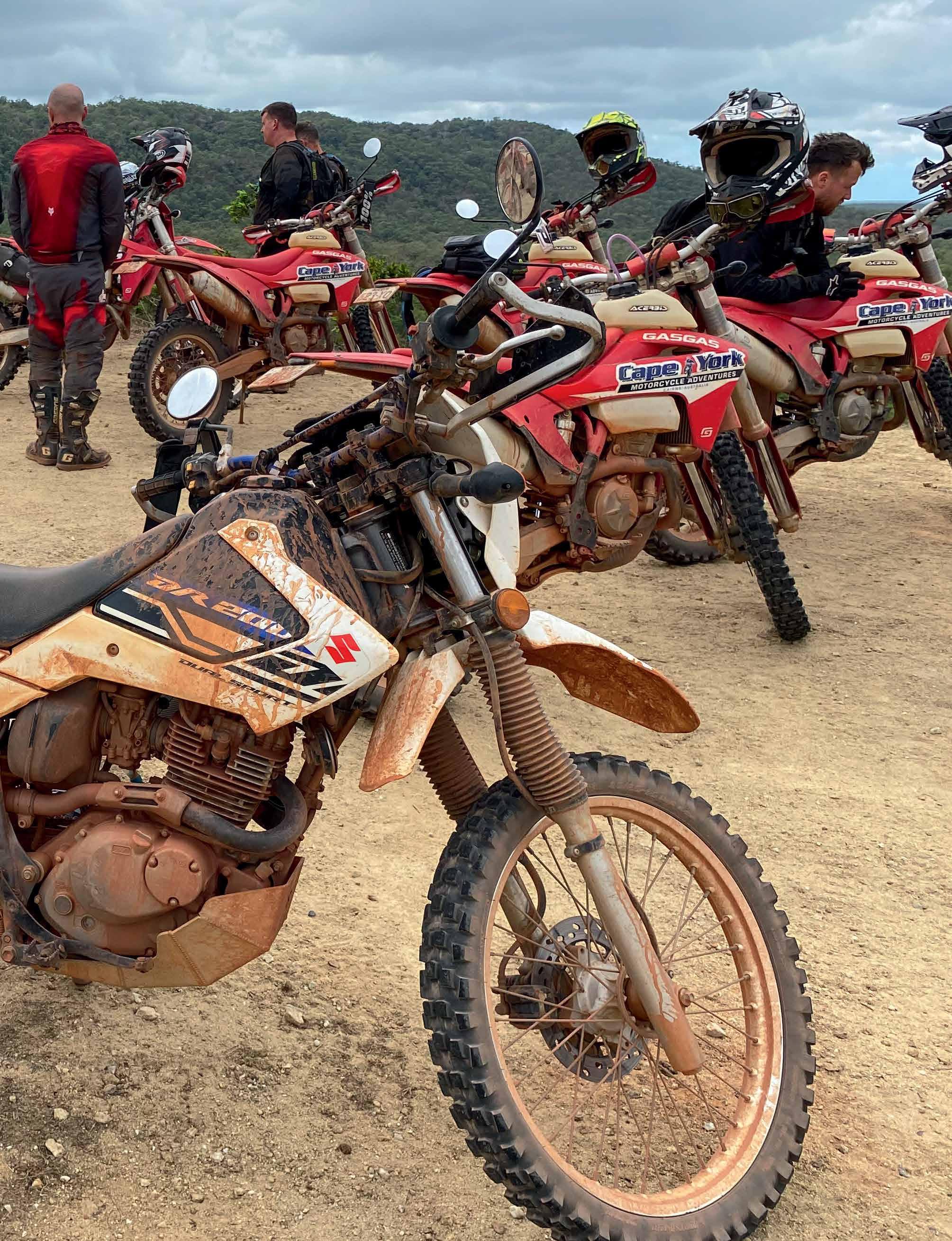
When the offer of a six-day trip with Cape York Motorcycle Adventures landed in my inbox, I gave no thought to the fact I had not ridden serious off-road since the Altai Mountains in Kazakhstan way back in 1997. In a nanosecond, I hit reply: ‘Yes, count me in’. The deal was I would ride with Anita Eley from Brisbane, who had won the trip as an Adventure Rider magazine subscriber prize. I’d report on the experience and hopefully my story would encourage more women to book a sixday bucket list trip with Cape York Motorcycle Adventures. I was to learn that only about five percent of their riders are women and very few do the tough tracks: CREB, Coach Road, Starcke, Frenchmen’s and the Old Telegraph. During the ride in late August, when I asked one of our ride leaders, he gave it some thought: ‘A few months ago. With her husband. She came off about 40 times and was bruised all over’. He added there are always three or four riders, sometimes more, on every trip, who opt out of riding the tough tracks and instead ride the Peninsula Development Road (PDR) with the support truck. ‘Those tracks are not for everyone. For some riders just getting to the Tip, even on the PDR, is enough of a challenge,’ he added.
drowned… and then de-watered to ride another day. For the unprepared, the easy option to these seriously tough tracks, is riding the choking red dust and bone-rattling corrugations

of the PDR. There are a few cruisy tracks that wind pleasantly through rainforest on day one and day six, but if you’re relegated to the PDR through lack of skill and/or injury, your Cape York adventure will be a much tamer kind of challenge. You will still be riding through ancient rainforest, woodland, open savannah, and negotiate a few creek crossings in one of the remotest and most scenic places in Australia that really is a last frontier.
Those tough tracks, and especially the Old Telegraph Track, are the main drawcards and why Cape York is so popular with dirt-bike riders the world over and plenty of 4WD drivers as well. Testing skills to the limit, riders tackle deep sandy tracks that go on and on for kilometres; ride over hidden ruts covered in bulldust; negotiate, for some at speed, washouts, sharp rocks and tree roots that puncture tubes with frequent regularity, plus numerous creek crossings, some with crocs, and where many a bike has been
“ Riders tackle deep sandy tracks that go on and on for kilometres; ride over hidden ruts covered in bulldust; negotiate, for some at speed, washouts, sharp rocks and tree roots that puncture tubes with frequent regularity, plus numerous creek crossings, some with crocs. ”
Above: Anita Eley was the Adventure Rider Magazine subscriber winner of the Six Day Bucket-List Tour with Cape York Motorcycle Adventures.
The offer from Cape York Motorcycle Adventures came in mid 2023. The ride was booked for late August 2024. Plenty of time to work on my dirt riding skills, I reasoned, and so other priorities like family, my day job in communications and my various side hustles took over. It wasn’t until about three months before the trip, I watched a few You Tube videos and immediately knew I was out of my dirt bike riding depth and ‘leg length’ as I’d be riding the GasGas 350 with a seat height at 960mm (pretty normal for dirt bikes). To get the most out of this six-day bucket-list ride, something had to be done. Otherwise, I would at worst, ‘crash and burn’ or at least, hold up the team as I repeatedly dropped my bike every time the going got tough. I added strength and stretch training to my weekly Pilates workouts and borrowed a mate’s 1991 Suzuki RMX 250 2-stroke. I had hoped my beloved 1991 Yamaha TT600 would be ready by this time so I could fully embrace the dirt trails near my home in the Yarra Ranges, but sourcing parts for its rebuild continues to prove difficult.
Was I prepared for Cape York? Did I realise how tough it would be? F__K no. Without a high level of dirt bike skills for the kilometres of sand and bulldust, deep ruts and washouts, and creek crossings: disaster was inevitable.
Right: Pascoe River on Frenchman’s is one of the deeper crossings where bikes must be carried. u

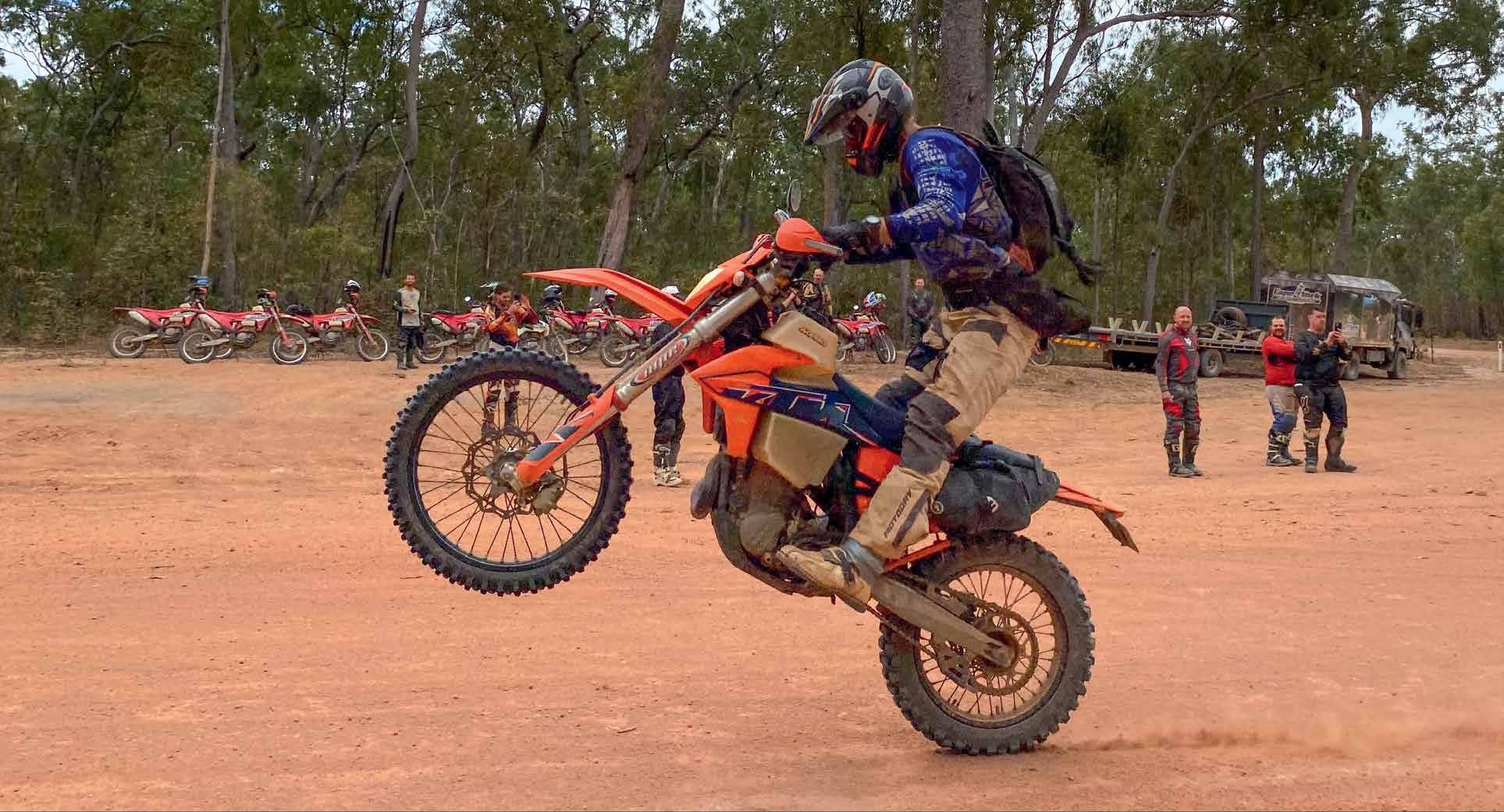
At Cape York Motorcycle Adventures HQ on the outskirts of Cairns, our group of 15 were allocated bikes. All, except myself, were on the GasGas 350 with two lowered ones offered to Anita and I. As Anita has a KTM 350 and rides the tracks near her home in Brisbane, she chose the lowered GasGas. A much lower Suzuki DR200 was also on offer and after testing both, I opted for the DR200. Even on the lowered GasGas, I was still on tippy toes not having the body weight to push down the suspension. I aptly named her ‘The Little Pig’ and by the end of that first day and some steep rocky climbs, she was quickly renamed the ‘Gutless Little Pig’. Good thing, most of the 1200km ride to Cape York is flat other than a few steep climbs out of some gnarly creek crossings. With my feet comfortably on the ground, I figured there would be less chance of dropping her on uneven ground and while underpowered, this ride to the ‘Tip’ was not a race for me. I already knew I would be a back runner. I reasoned I didn’t need the power, superior suspension and clearance of the GasGas as I’d just dawdle along at a nice safe pace, and hopefully avoid a crash. But, there is no dawdling, no time to smell the gum trees, while on an organised tour of Cape York to reach the Tip in six days.
With ride leaders Jordan and Scotty, we
headed up the Kuranda Range, turning off at Black Mountain Road, where it soon turned to a narrow track of red dirt that wound pleasantly through thick rainforest and across a few shallow creeks until we popped out at the top of the Mossman Range. Descending on tarmac into Mossman and after burgers at a local cafe, we took the ferry across the Daintree River and rode through the ancient Wet Tropics World Heritage Daintree Rainforest. It was
a nice way to ease into our first day and I looked forward to some slightly harder going when we reached the Bloomfield Track. Having lived in Mossman for a year back in 2000, I knew this track well and was relieved the red clay would be dry on this day. But the Bloomfield has been tamed with concrete on all the narrow hilly sections, which was probably a good thing for me on the ‘Gutless Little Pig’. We couldn’t take the CREB track from Daintree
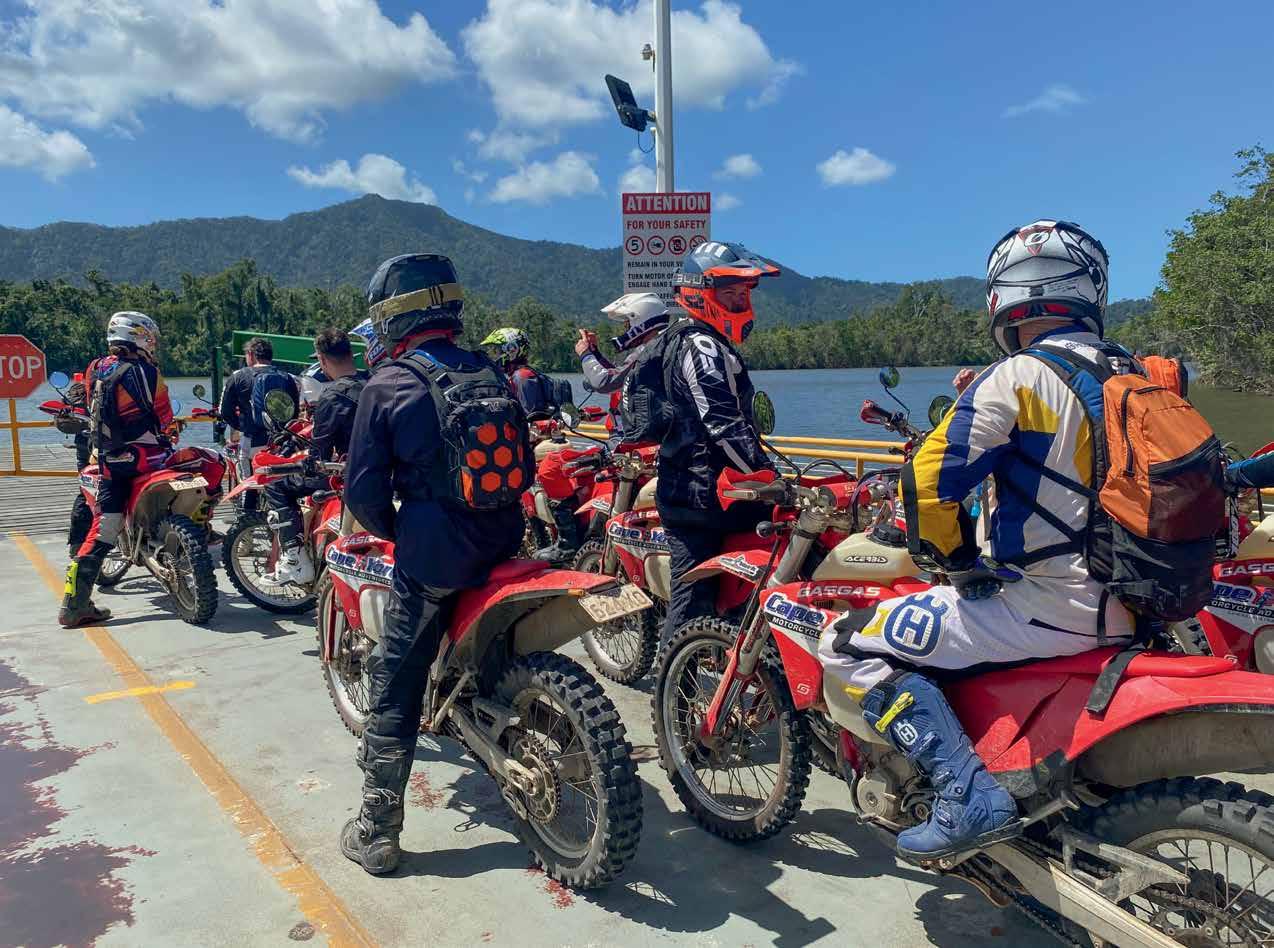

left: Ride leader Scotty, pops yet another long-distance wheelie.
Bottom left: After crossing the Daintree River, we ride through ancient rainforest to Cape Tribulation. Above: Riding hard over sharp rocks and tree roots play havoc with the standard tubes.
Right: Anita crossing Emmagen Creek on the Bloomfield Track.
Bottom right: Russ, our support truck driver, cooks up chicken curry.
Village to Wujul as the Daintree River crossing was still closed. Even though this was late August, the opening of tracks is dependent on rainfall and clearing after the wet season. Given a choice, end September/early October would be the pick of a ride to Cape York. Creek crossings are low, tracks are dry, yes there’s dust, (there’s always dust, choking dust), and it can be hot. However, the humidity or build-up to the summer wet season has not really started. But weather can be unpredicable and an unseasonal downpour can soon make creeks impassable. We took a detour after Wujul Wujul to follow a track to Lions Den Pub and our first night’s camp. After riding some hilly sections we dropped down to a normally easily passable creek crossing, but a recent downpour left it fast-flowing.
Cape York Motorcycle Adventures have been offering guided tours to Cape York since 1991 when founder Roy Kunda after his first ride to the tip, wanted to share the adventure with other riders. Over the years, he’s mapped out multitudes of tracks so if one is impassable, there’s always an alternative. Son Jordan Kunda,

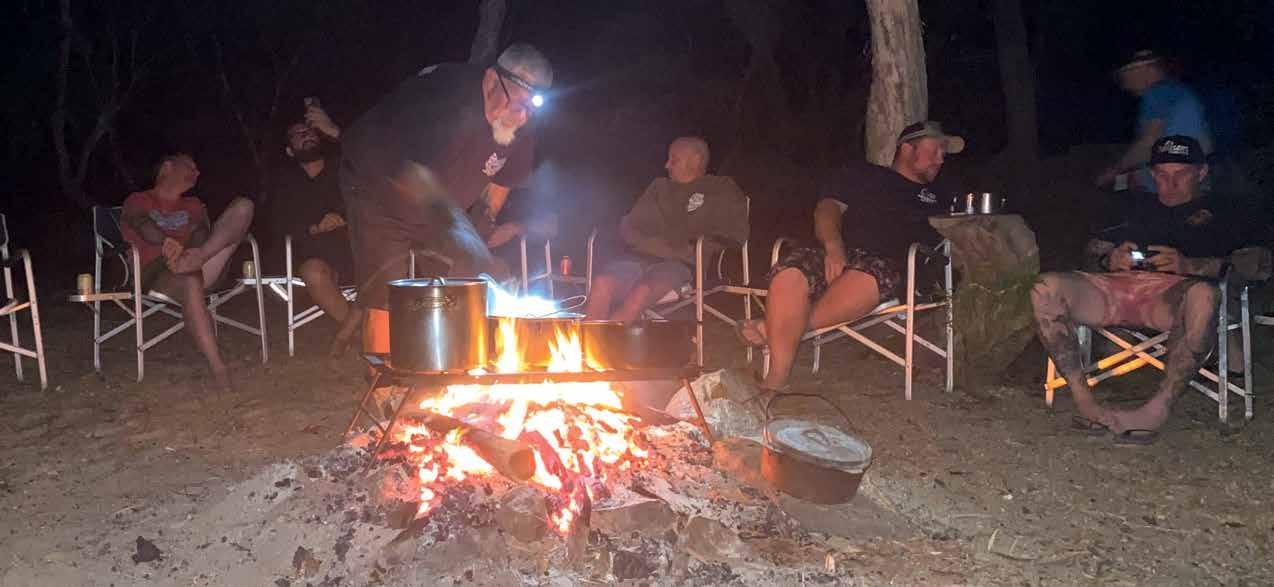
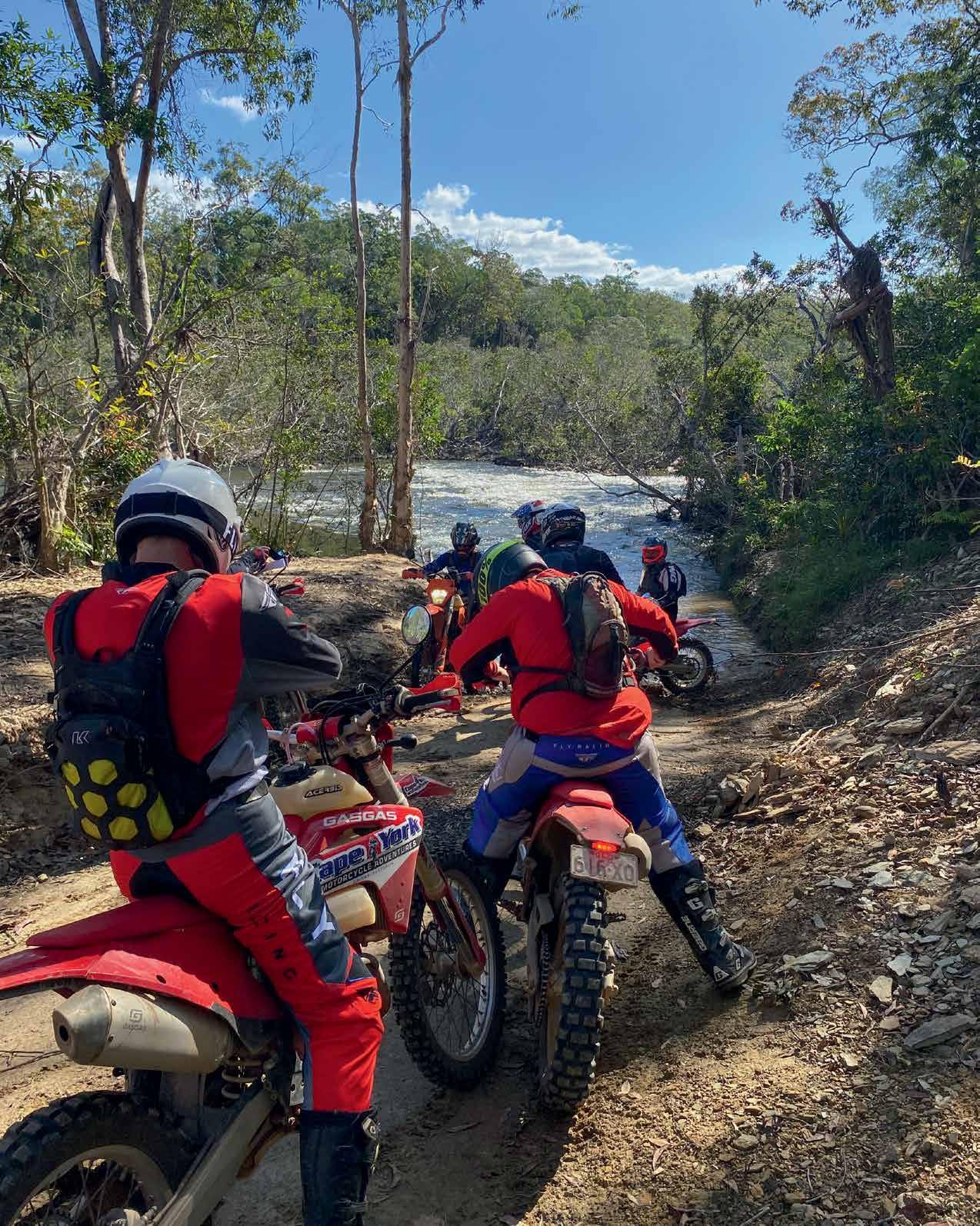

one of our ride leaders, thankfully was quick to turn us around although there was a brief discussion about walking the bikes across. I could just see myself slipping on the rocks and being washed downstream to end up as croc bait.
The idea of taking us on these back tracks was to gauge our riding ability, which would determine who would ride the tougher tracks to the Tip or be relegated to ride with the support truck on the PDR. Our 15 riders were made up of four groups of mates and ‘man could they all ride’. Two groups were from New Zealand including a father and son, who was a former NZ motocross champion. For dad Lance, this was his ninth ride with Cape York Motorcycle Adventures. ‘Why do you keep coming back,’ I’d asked. ‘It’s a tough ride and I love the wide open spaces. There’s nothing like this in NZ,’ he replied. Another Kiwi, a farmer, told me he’d never ridden a dirt bike. But he’d ridden farm bikes like the DR200, all his life, which explained his pretty high level of skill. Riding Cape York is very popular with the Kiwis and there’s always a group on most rides, I was told. There was also a group of mates from southern Queensland and another group from Victoria. All were experienced dirt bike riders. As kids, I imagined they were riding motocross before they could walk. It was a similar story for myself first learning to ride a Honda Z50 when home was an outback sheep station. After any brief stop during those six days, the boys would take-off in a cloud of dust testing their skills against each other as they vied for second place behind the ride leader, and out of the dust. That left three of us to bring up the rear: Anita, myself and Andrew, also from Victoria. Like me, this Cape York trip was also his first time back on a dirt bike after many years.
All was going well until we turned on to the aptly named Powerline Track, which was a narrow rutted track of steep ascents and descents covered in loose rocks. Anita took a tumble and while she could still ride, the engine burns on one leg and an injured knee on the other ended her dream to ride the tough tracks to the Tip. Anita had also been riding dirt bikes since
Top left: Unseasonal rain can quickly make river crossings impassable on a ride to Cape York. The Annan River on Day 1.
Left: A lunch stop before Starcke Track. We refuelled ourselves and our bikes from the support truck.
Right: One of the many sandy tracks on a ride to the Tip of Cape York.
Below: Huge termite mounds dot the dry savannah like this one near Bramwell Junction.
Bottom right: Camping at a secluded creek on a cattle station near Archer River.
she was a kid and as well as her KTM350 for the dirt, she also rides a BMW S1000 RR sports bike.
Soon after Anita’s tumble, in a bid to save myself going over a steep edge, I also dropped the DR200 when the front tyre slipped on a rock. ‘What tyre pressures am I running,’ I asked Scotty, who was riding as sweep. ‘22 psi. Stops getting so many punctures,’ he replied. I pushed him to drop the pressure as I wasn’t riding hard like the boys, who had the skill to go with it. We compromised on 18psi. I suddenly had much more control and less rear tyre spin as the Little Pig did its best to climb the steep hills.
We reached Lions Den pub and camp ground late afternoon where the support truck with crew Russ and Adam had already set up camp chairs and the bar was open; a huge esky filled with ice and cold beers. For our first night we were glamping it in safari tents and a pub dinner.
After a stretch of tarmac and stop at Cooktown for photos at the lighthouse,

we turned off at Battle Camp Road towards Starcke Track, a 124km track of sand, bulldust and washouts. Jordan and Scotty had quickly accessed that myself and Andrew were not up to it. ‘You’ll wear yourselves out for the rest of the trip,’ they advised. Disappointed, I watched longingly as the boys rode off in a cloud of dust like the flag had been dropped to start the Finke. Yes, I was out of my league and would never be able to keep up. Andrew and I rode on with the support truck

following for the ‘boring stretch’, while Anita wisely rested her injuries in the truck with her bike loaded on the trailer. Our ride was a combination of tarmac and corrugated dirt with a brief stop at the Laura Homestead. It was here we came across two riders on the last leg of their three week ride to Cape York. They were originally a group of four with two of their mates cutting their trip short to get back for work. These two guys were on their way back to Cairns and I got chatting

to one riding a KTM500 with long range tank and packed with the bare minimum of gear including a fishing rod: a must for Cape York. These guys knew what they were doing. They’d shipped their bikes and gear from Melbourne to Cairns for $1700 return. Riding as a group they could help each other out when bikes had to be carried across the deeper creek crossings. We reached Kalpowar Crossing campsite in Lakefield National Park around 4pm and by the time I’d set up my stretcher tent and had a shower, the boys were blasting across the Normanby River causeway scattering the crocs. They’d made good time of the Starcke and even got in a spot of barra fishing (rods supplied), before dinner of campfire cooked spag bol. While the boys shared stories of conquering the Starcke, said to be one of the hardest tracks Cape York has to offer: it’s six hours of riding sand, I felt my inadequacies as a dirt bike rider and seriously doubted I would ever regain my skills from the past. That was until a group of four rode into our camp including two girls each on Husaberg FE570s. I later got
chatting. Gemma, at just over five foot, had only been riding a motorcycle for three years. She started on a 125cc, then a 250cc before taking the huge leap to the very high Husaberg. The boys were also in awe saying the girls even passed a few of them on the Starcke. Elsa, not much taller than Gemma, had also only been riding for a few years and it all started when she wanted to join her dad on a ride to Cape York. She bought a KLX 250, rode it around a paddock for a few months and then got her motorcycle licence. Unbelievably, three months later they left Cairns for a five week ride to Cape York and back. This was her second trip: a group of family and friends, which included a few 4WDs as support leaving the girls free of gear to enjoy the tracks.
Day three was the ‘boring’ day for all of us with only a few short side tracks to take away the monotony of the PDR, which included a few stretches of tarmac and a lot of dust and corrugations. ‘Today is all about clocking up the kilometres to
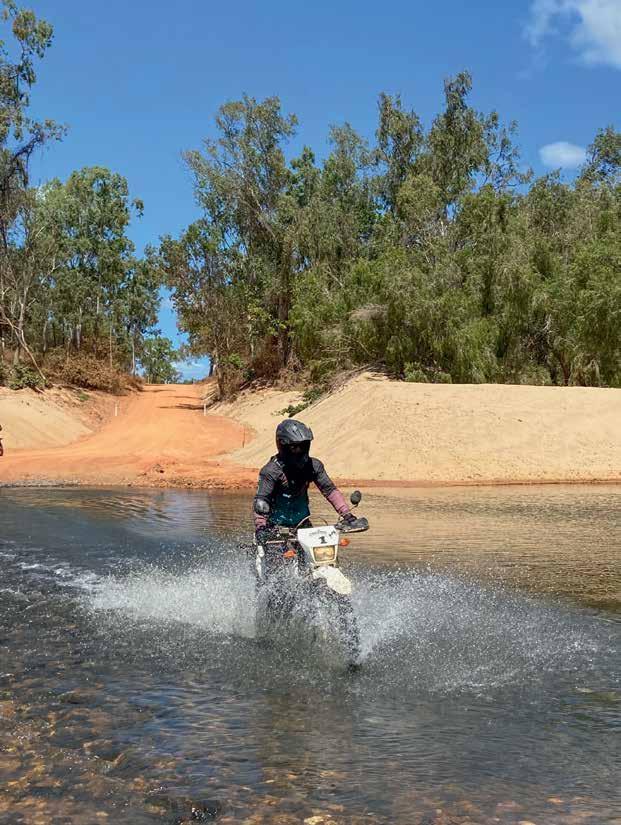
Above: Crossing the Laura River on Day 2. Below: The heritage-listed Laura Homestead. Top right: Lama Lama Country Billabong. Bottom right: A welcome swim at Fruit Bat Falls. I’m nursing a nice bruise after my stack on Day 4. Bottom far right: Anita and our group enjoy lunch next to a billabong in Lama Lama Country.
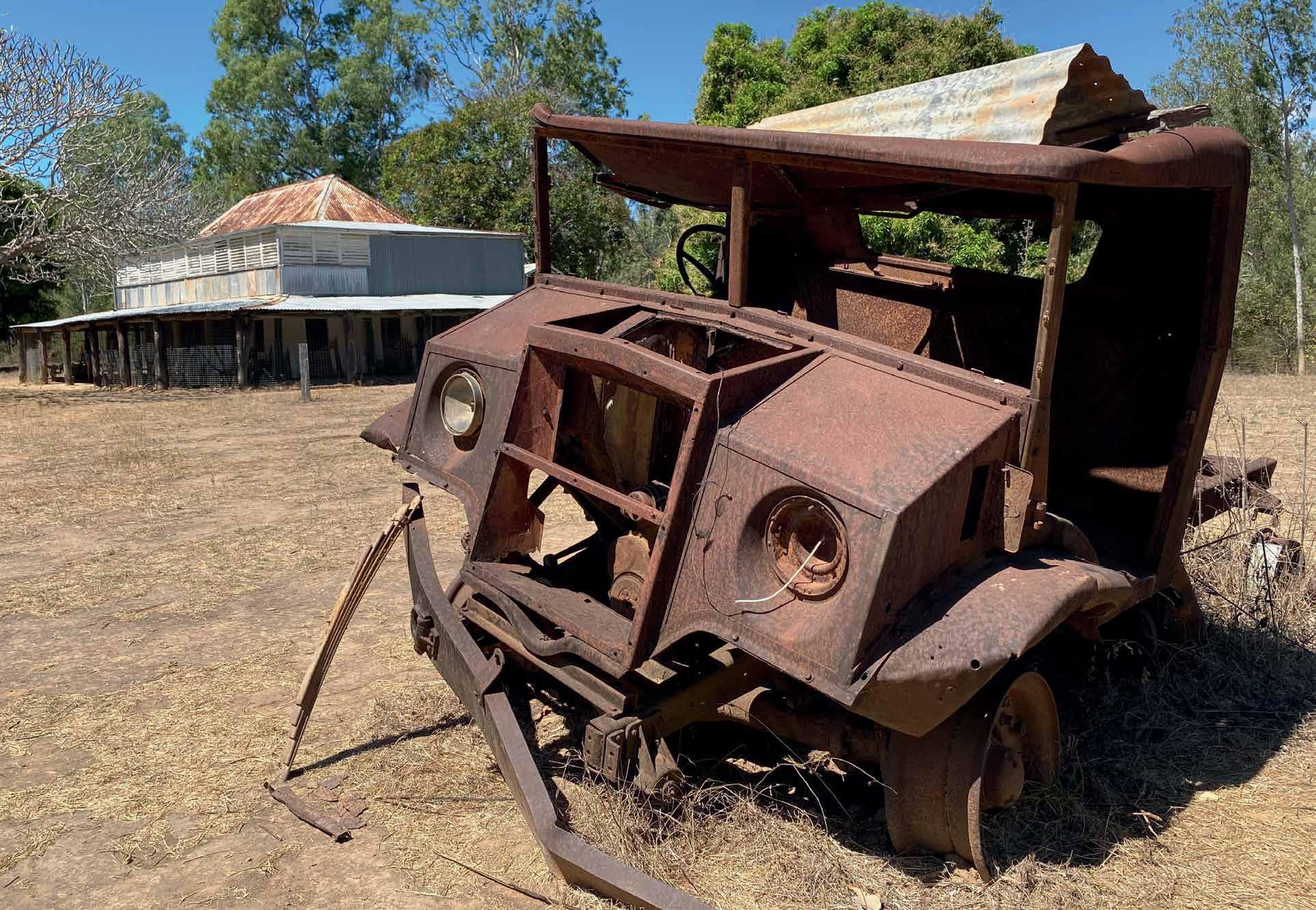
get to where the fun begins,’ we were told. The monotony was broken at lunch when we stopped at a billabong, the landscape reminding me so much of Kakadu where I lived for nine years and often rode the bush tracks to reach the gorge swimming holes back in the 1980s. After refuelling from the support truck, it was back on the PDR until Coen and a beer at the Ex ‘SEX’ Change Hotel. Camp that night was another 65km of corrugations before heading down a 3km track to the sandy banks of a spring-fed creek with a secluded swimming hole where we cooled off in crystal clear waters minus the crocs we were assured. Russ cooked up another feast: chicken curry. There was a brief early morning downpour which soaked through the top of most of the stretcher tents. Mine was spared as I’d tied the guy ropes to nearby trees to hang my washing. I’d woken to toss my nearly dry washing underneath the tent. I had two quick-dry sports T-shirts, which I rotated by rinsing at the end of each day. This meant the wicking fabric dried overnight. It also worked with my thin long socks but with so many creek crossing, socks don’t stay dry for long as motocross boots act as gumboots once filled with water.
I’d found my groove on the dirt by Day 4. And with all the steep hills behind us, ‘The Little Pig’ was holding her own with the boys on the GasGas 350s. When we started the 53km Frenchman’s track mid- morning, I was even keeping up and

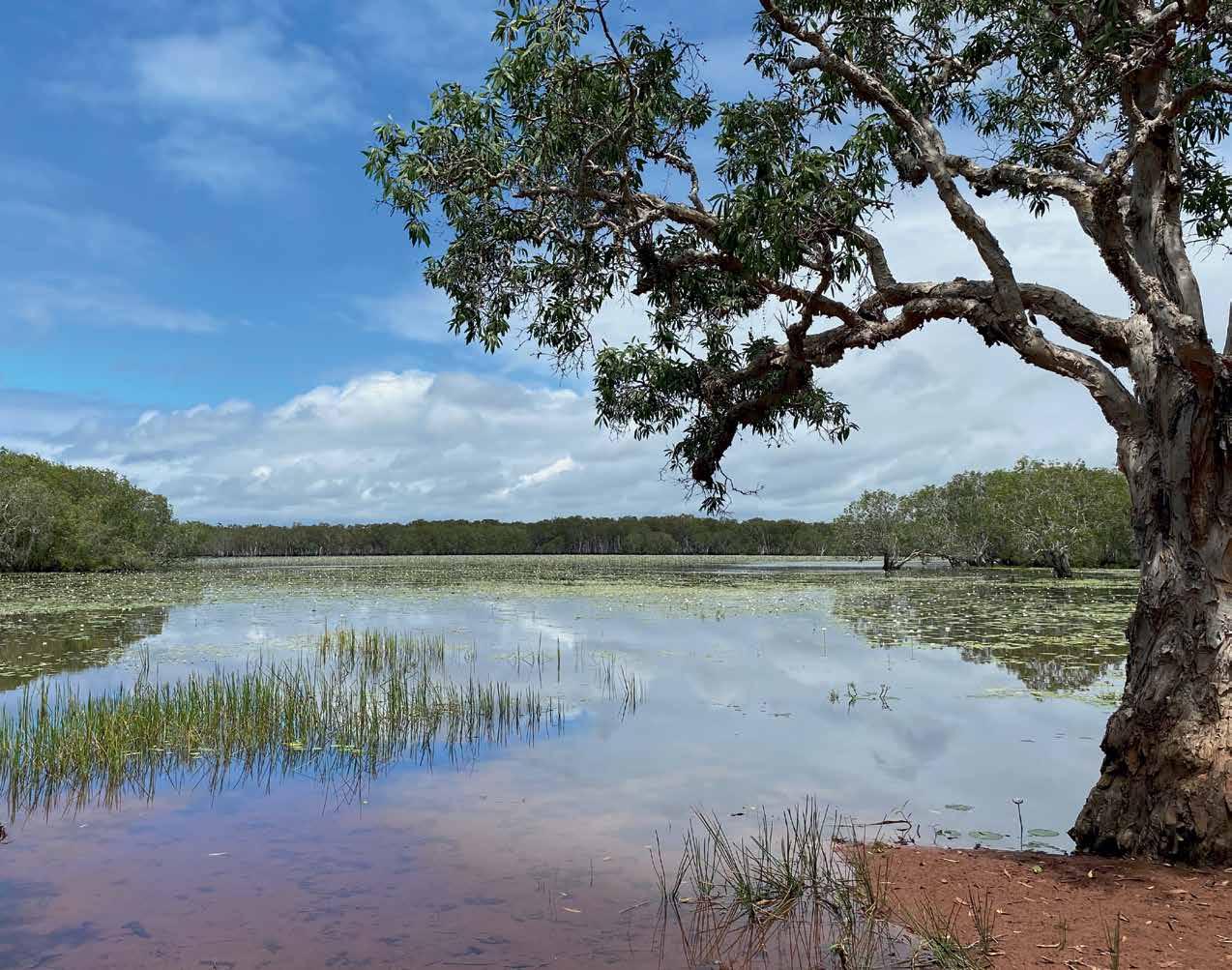
felt I was no longer pissing off whoever was the sweep, but both Jordan and Scotty always reassured me there was no rush. However, I was fully aware I was not a paying customer and didn’t want to spoil it for those who were. Any turn-offs and gnarly washouts, were flagged using the rally system with a rider having to wait for me and the sweep.
Frenchman’s Track starts off as a fairly easy flowing confidence-building track that winds through sparse woodland, but is dangerously deceptive as you’re lulled into a false sense of ‘I like this, lets open the throttle’. Then out of the blue, the track
dropped into a huge washout, which, I was later told, had claimed a few riders in the past. I was its latest victim and in a bid to save myself, I tried to power out but this particular manoeuvre was beyond the DR200s capabilities. I went splat, literally, on my chest. Fortunately, my motocross armour saved me from some serious broken bones. I stood up with a few bruises and a very weak left upper arm, which I later found out had a hairline fracture. After dusting off the ‘Little Pig’, it was a much slower ride until we reached the Pascoe River. The boys carried the bikes across and there was no way I
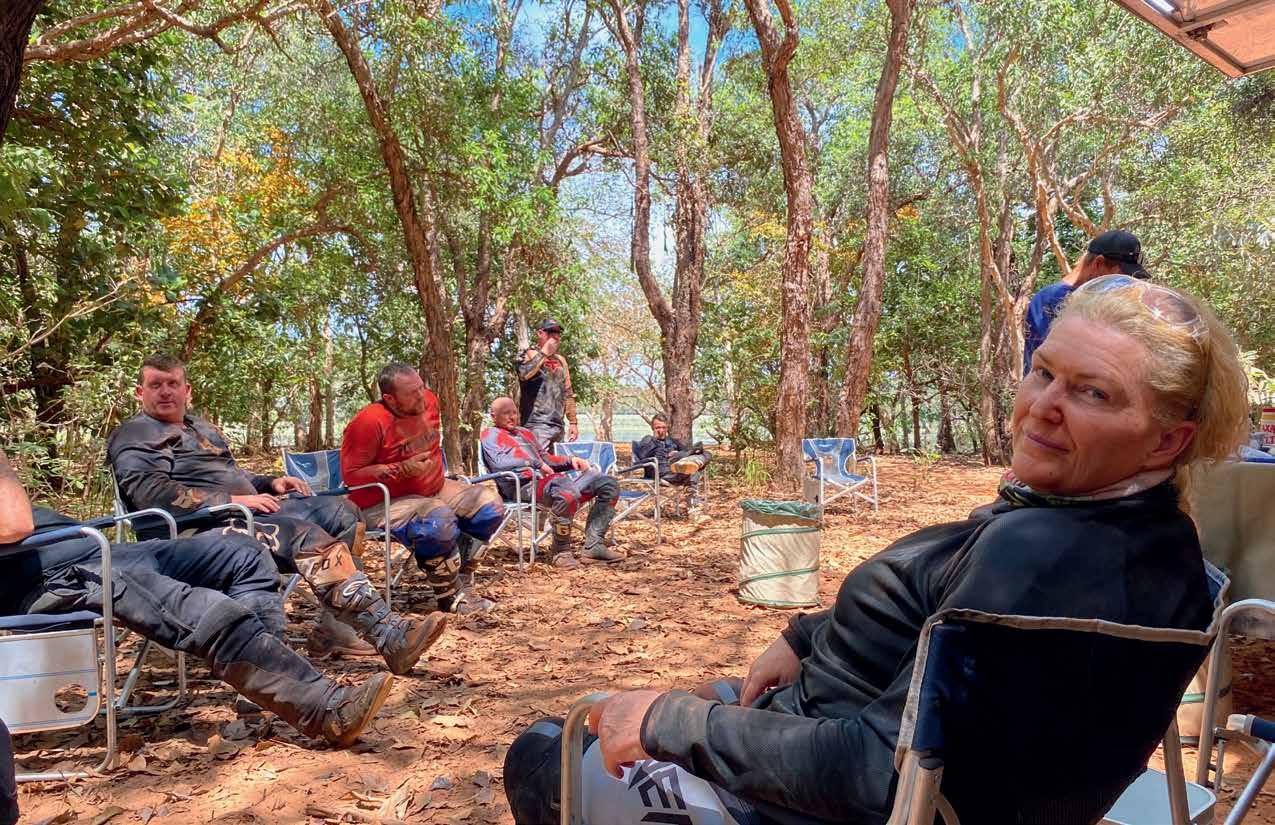
could ride up the steep gnarly exit with its bare rocks the size of small boulders. Scotty, swearing and cursing the DR200, got her up. I advised this would be a slow ride for me, slower than before, but it was also a ride of many stops for the boys as amongst 13 riders, there were 12 punctures. The boys had been riding hard over the sharp rocks and exposed tree roots. Scotty and Jordan, having swapped out more tubes on dirt bikes than you and I have had hot dinners, had each one changed and inflated with a battery pack compressor in record time.
After the Pascoe River the track turned to sand, a few more creek crossings including the Wenlock River and a swamp. This is where I dropped and drowned the DR when I couldn’t keep it between the deep ruts invisible under the dirty water. Scotty quickly de-watered ‘The Little Pig’ by standing her on the back wheel, draining the carburettor a few times and cleaning out the airbox. Once at the Bramwell Junction Roadhouse and our camp that night, the oil was drained, which fortunately was not milky so any water had steamed out the exhaust: no damage done. I thanked Scotty for picking up the DR the numerous times I’d dropped her in the sand on that last stretch of Frenchman’s and I thanked Anita for setting up my stretcher tent, a task I too would have struggled with. Later as we enjoyed thick juicy steaks perfectly cooked by Russ, and Jordon’s guitar playing and singing (he’s not only a talented dirt-bike rider but also a talented musician), I was glad I’d packed a good supply of codeine and panadol.
Roadhouse
Fruit Bat
It was very obvious the next morning that with my bruised weak left arm and sore ribs I was not capable or riding the two sections of the 105km Old Telegraph Track, a narrow track of sand, ruts, washouts, rocky sections, a stick bridge, several
Top right: While the boys fix their flat tyres, the rest of us cool off.
Middle left: Ride leader Scotty, de-waters ‘The Little Pig’ after I drop her in a swamp on Frenchman’s Track. Middle right: Fitting a new tube after yet another puncture. We had 12 amongst 13 riders on Frenchman’s Track.
Right: Ride leader Jordon at the start of the Old Telegraph Track.




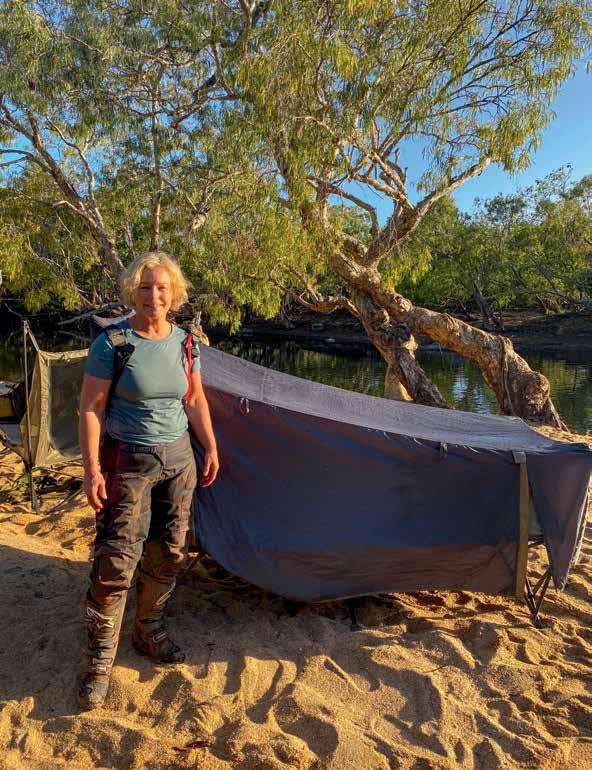
Above: The stretcher tents are comfortable but leak when it rains if you don’t tie off the guy ropes. Below: The infamous Gunshot Creek crossing on the
deep creek crossings and the infamous Gunshot Creek drop.
The guys made good time of the southern section of the Old Tele and arrived at noon for lunch and a refreshing swim at the stunning Fruit Bat Falls in the Jardine National Park. I’d hoped to ride the northern 35kms section of the Old Tele before the 80km run on of dust and deep corrugations on the PDR to the Jardine Ferry. ‘It’s mostly sand and there’s a few deep creek crossings,’ I was told. With my bruised and weak arm, I knew I was beat and agreed. Besides, the last ferry across the Jardine River

Forsome riders, a Cape York motorcycle adventure might very well be making it to the Tip, the very top of Cape York, even if this is riding mostly in the dust and corrugations of the main roads and the Peninsula Development Road (PDR). But I felt disappointed to not have ridden Starcke and the Old Telegraph Track, and even the CREB track if this had been opened. But I’d been unprepared: my dirt bike riding skills were no match for these tracks, and as a consequence I had missed out on what, I feel, a Cape York motorcycle adventure ride is all about.
Along with Cape York Motorcycle Adventures, which was the first tour group and has been operating since 1991, there are now nine tour companies offering adventure motorcycle trips to Cape York. Most riders are from Australia and New Zealand. Most book in groups of three or four or more and some get a group of 15 mates together (the maximum number on any tour). If you’re booking individually this might make for a lonely experience and even more so if you’re a little lacking in dirt-bike riding skills and the group you happen to end up with are all next level.
My absolute preferred way to ride Cape York would be to plan and fully prepare a ride with some adventure motorcycle riding mates where we had weeks instead of days. It would be a ride where we would spend time in Cape York’s remote wilderness. Where we’d swim in its pristine creeks (the ones that are croc free), and camp on deserted beaches (permits required) and cook freshly-caught barra for dinner. Where we could learn about Aboriginal culture from traditional owners like the Lama Lama people who run day trips and whose lands extend several hundred kilometres around Princess Charlotte Bay. But for many such an independent trip might not be possible for various reasons, so the best and safest option is an organised tour. A reliable bike is provided with crew that can do running repairs and quickly swap out tubes for all those punctures. They know the tracks and secluded camping spots. All your gear is carried, stretcher tents supplied, pub meals and campfire-cooked food provided and there’s cold beers at the end of each day of dusty hard riding. Glamping, camping and beach bungalows are paid for. Plus that $60 per bike Jardine ferry ticket and your flight back to Cairns from Bamaga is also included. Then if you’re injured and need a rest day, there’s a seat in the support truck while your bike is loaded on the trailer. And if you have a more serious stack, the PLB (personal locator beacon) is activated and you’ll be helivaced to hospital. Everything is taken care off and your only concern is to enjoy the ride. With the nearly $8000 price for a six-day tour, you really are getting a lot of bang for your buck.
To ensure your group is pretty much at the same dirt-bike riding skill level, you could also get a bunch of mates together and book out the 15 places on a tour. A group of women who are members of East Cost Female Riders Australia, and which Anita is also a menber of, did this.
The women who signed up for the Cape York tour had to commit to many months of regular dirt-bike rider training to ensure they were all adequately prepared to ride those tough tracks. And that is the real challenge of making it to the Tip.




to reach Punsand Bay, was 5pm. Missing it would mean spending the night with the mozzies, no camping gear, no food and no cold beer. I would certainly not be the sweep’s favourite person.
After crossing the Jardine River, it was another 70km ride on the PDR, mostly corrugations and dust, but some tarmac, to Punsand Bay Resort, where we were booked into beachfront bungalows for the last night of our Cape York adventure. Before dinner of local-caught mackerel, our group enjoyed beers overlooking the palm-fringed beach and blue waters of the Arafura Sea. We weren’t quite at the Tip (Pajinka) yet. That was a 30km ride which we would do tomorrow on Day 6 before our afternoon flight from Bamaga to Cairns.
After stopping at the Croc Tent to buy ‘I’ve Reached The Tip’ souvenirs, the last 15kms to Pajinka was a narrow one lane track of red dirt that wound through sub-tropical rainforest. It was the sort of flowing dirt riding I love, but the shadows hid a few potholes and this track to the ‘Tip’ was also popular with 4WDs. After a 600 metre scramble over rocks, we’d made it to Australia’s northernmost point. We were at the sign and with the Torres Straight Islands in the background took our group photos. While the boys relished their achievement, the challenge and testing their next level dirt-bike riding skills on Cape York’s tough tracks, it was not the same for me. I had not really made it. That achievement comes from the challenge, the ultimate accomplishment of riding the tracks to reach the ‘Tip’. But then everyone’s idea of a challenge is different. From Bamaga, it was a short flight back to Cairns where we all said our goodbyes and a few of the guys told me they would be back and Lance was already planning to book his tenth six-day bucket list ride with Cape York Motorcycle Adventures. ‘You’ve got to ride the tracks,’ he said. Would I be back? Yes, because this adventure ride has not quite been ticked off my bucket-list. But would I do another organised tour?
Cape York is too hot for an adventure suit. Leave it at home. I purchased all this gear new for Cape York and it all held up for the six day ride. After washing off the red dust, all still looked almost new. I expect to get many more years of off-road riding from this gear.
Pants: Fox Racing 180 Nitro pants in grey/black (mens). These are a great fit for women too and were the MX pants of choice by six of the guys on our trip. They all advised these were the most durable pants they’d ever owned. And that is saying something as these boys ride hard.
Jersey: Fox Ranger Drive Jersey (womens): In XL to fit over armour. Has 50+ UV protection fabric and integrated high neck and face buff for extra sun protection and keeps dust out too.
Armour: Alpinestars MX23 Bionic Action Jacket V2 Black (mens). The men’s style fitted me fine, but there’s also MX armour designed for women. While many of the boys in our group did not wear armour, mine saved me from serious injury when I ‘stacked it’.
Boots: Alpine Stars Tech 7 motocross boots. These were a very popular boot amongst our group. More than half the boys had Tech 7s. My boots were new and before Cape York, I solved the very annoying squeaking by pushing leather dubbing with a cotton tip into the joins where the leather meets the plastic. Then left the boots in the sun so the dubbing melts into the joins. Most of the boys’ boots squeaked but ‘hey who cares’, they told me. I had two pairs of thin long socks and rinsed out the dirty pair each night. Socks are dry only until the first creek crossing. And yes, these were pretty smelly after six days.
Gloves: Fox Bomber LT black gloves (mens). These gloves are lightweight, breathable and easy to pull off and put on even when wet, and have a comfortable knuckle guard.

Size small mens fitted me perfectly. Helmet and sunglasses: Fly Racing Trekker Adventure Helmet with visor. With a visor on my MX helmet, I opted for sunnies (nothing expensive). I’m not comfortable wearing googles. Even with all the dust, this worked for me. A few of the other guys including the ride leaders did the same.
Hydration Bladder pack: USWE Ranger 9 pack 3lt Elite. The 4-point harness design means the pack doesn’t bounce around on your back (that’s what the No Dancing Monkey sticker means). It has wide shoulder straps and multi-size adjustment loops to fit your size. I loved that there’s a few different zip panels to store your phone, snacks, lunch (without getting squashed), and hat when you’re stopped (essential in Cape York’s sun). Plus the pack is a little bit waterproof, which I found out when I slipped on a rock and went under while walking across the Pascoe River. Everything inside was dry, including my phone, which I stupidly did not put in ziplock bag.
To plan and book your six-day bucket list Cape York motorcycle adventure visit: www.capeyorkmotorcycles.com.au
Heather Ellis is the author of Ubuntu: One Woman’s Motorcycle Odyssey Across Africa and Timeless On The Silk Road. Available on Amazon and at www.heather-ellis.com

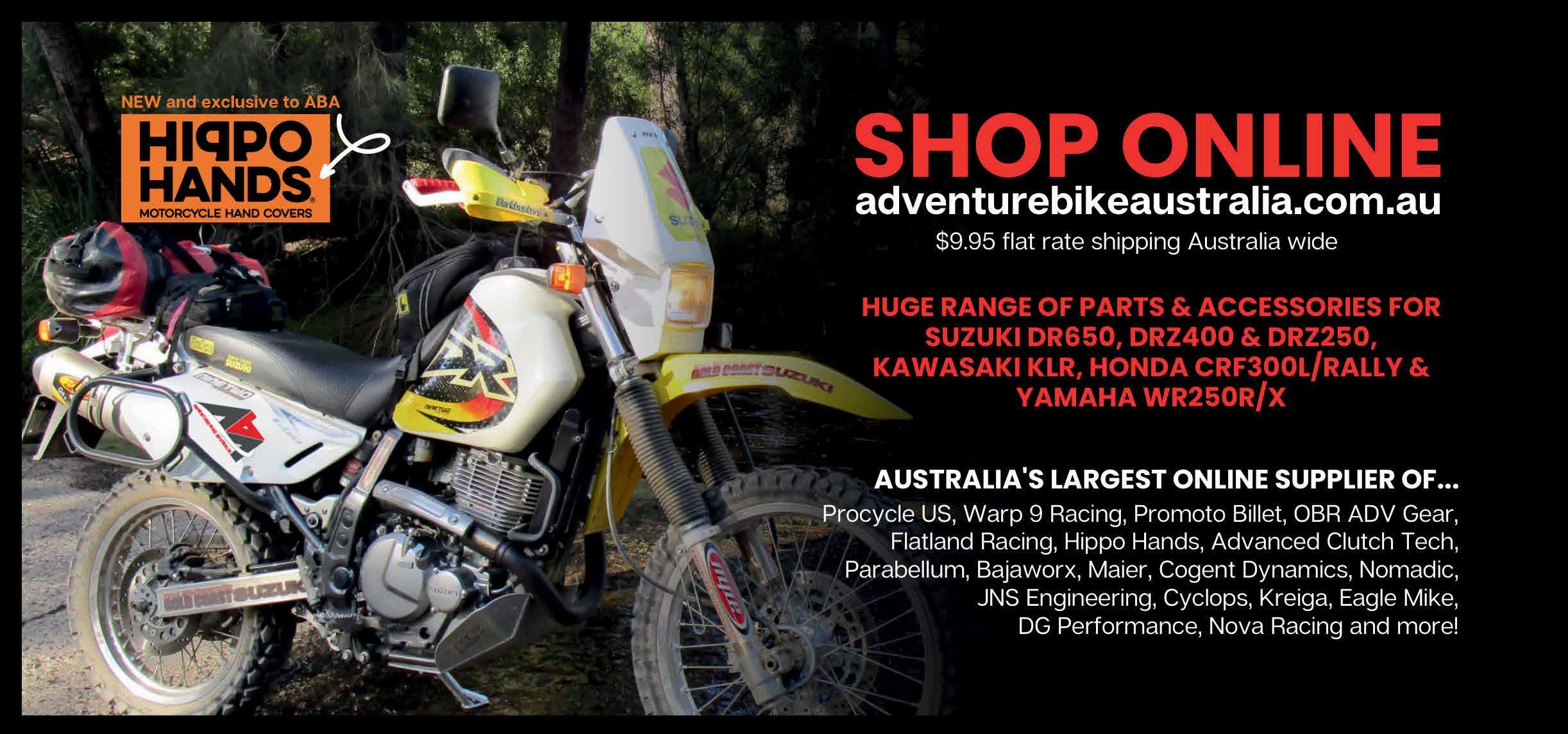
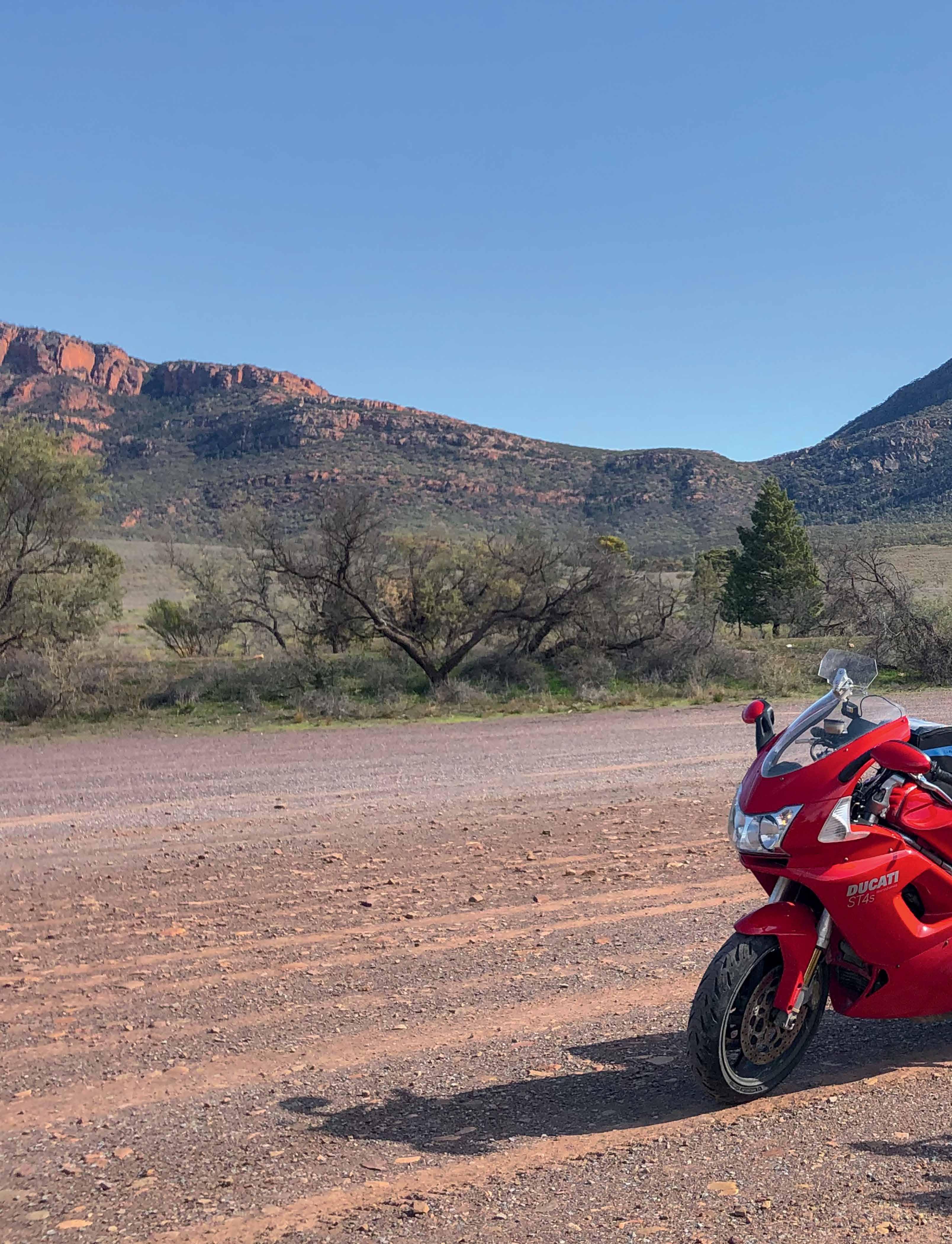
Ride report on the Border Run, Off Centre Rally and the Superbike. 2024

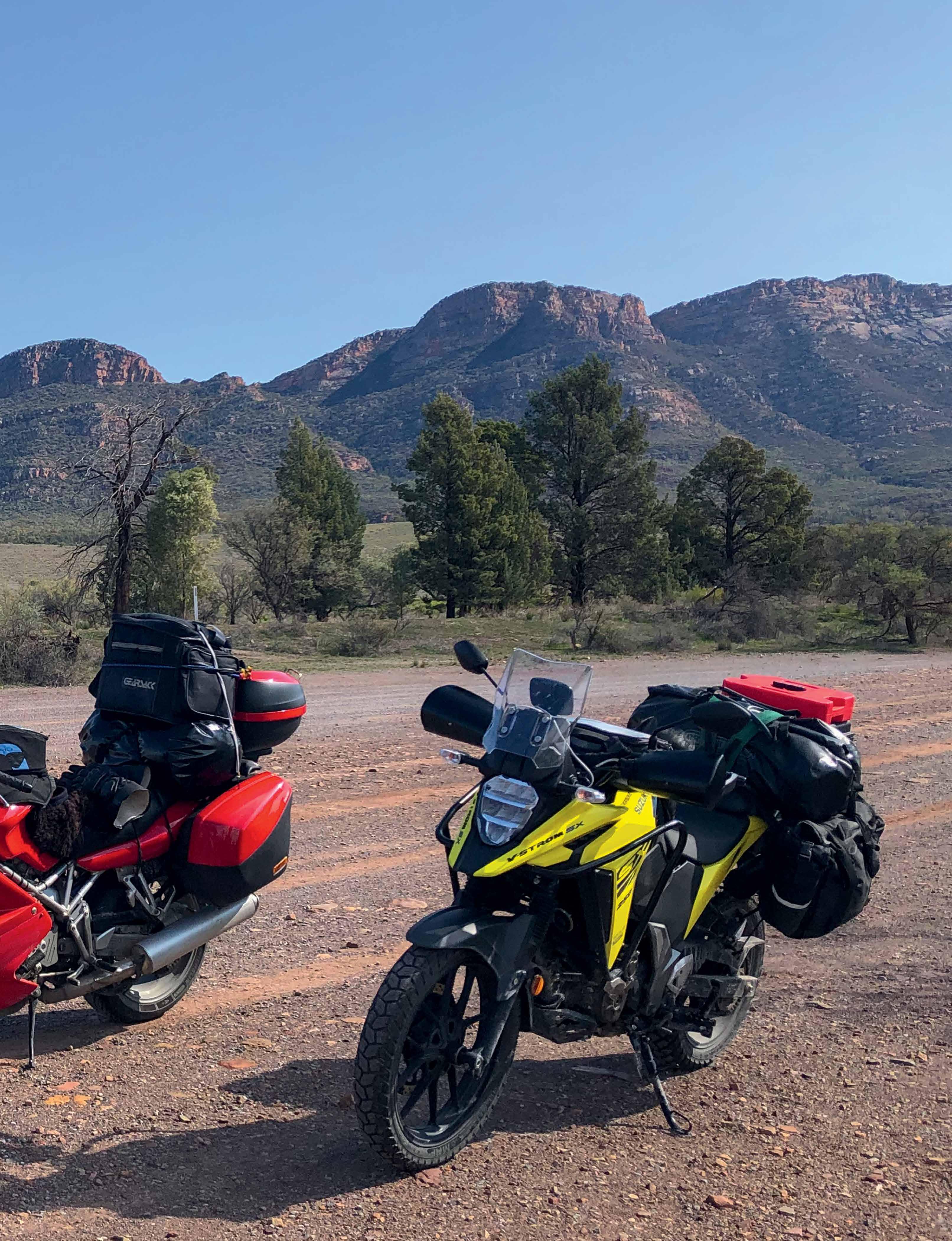
This story started some time ago when I decided that small is good, as in motorcycles that is. I have been riding a Suzuki DL650A for some years all over Australia, Europe and the USA/Canada. After my last ride in the USA/Canada where I rode with a local called Bill who only rode at 90kmph, I began to think, it was so easy and relaxing. On my return, I thought if 90kmph was okay then why not go small in capacity? I am not an off-road rider and after many miles off road in Alaska, decided that a lighter smaller-capacity motorcycle was the go as I was now 71, losing strength (some say some brain cells as well) and confidence; a lighter motorcycle made sense. I also wanted to go off road and with the Off Centre Rally coming up in Arkaroola I started looking about.
My list of “must have” etc on a new motorcycle looked a bit like this: must be a road bike (mainly so I could attach my tank bag), I did not want to sit on the handlebars, must be off-road capable, must be able to carry my tent and camping gear, a decent size fuel tank, must be comfortable etc.
After months of looking around for a small motorcycle, I bought the superbike (more about the name later). I spoke to many riders with small motorcycles especially the Kawasaki Versys 300 and tried a mate’s Suzuki DR650. While in Vietnam a few years ago I rode a Honda CRF250, a small fuel tank and the worst seat in history turned me off, great off-road though. In the end, I went to my local Suzuki dealer and checked out the new oil-cooled, singlecylinder Suzuki DL250SX V-Strom. First impression, a full-size motorcycle and just right for an old man. After checking all the ride reports on YouTube, I decided the Suzuki was the one. Now how did it get its name? While doing the final paperwork the dealer said to his mechanic “take Anthony’s Superbike and fill it with fuel”.
Now that I had the V-Strom it was time to run it in and carry out a few modifications, always bearing in mind added weight. The changes were the fitting of the optimal low seat, fork boots (gaiters), GPS holder, 12v cig lighter (USB port comes standard), and tank bag. As there were no ready-made extras for this Suzuki, I made crash bars, the main stand and racks to take Andy Strapz Adventure panniers. All set to go after the 1st service.
At the last minute I got cold feet about taking a 250 on the ride, I mean over 4,000 km in the middle of winter, how dumb, I even changed the luggage to my 650 but my wife said you bought the 250 for the Border/Off Centre so you had better take it; who was I to argue?
The big day arrived and off we went in the cold on the superbike. I live in Western Victoria so my route took me to Balmoral (guaranteed kangaroo dodging), and then into South Australia to Frances for morning tea on the bumpiest paved road in Australia I am sure. I think I was half an hour into the ride when I decided I had taken the right motorcycle. I was soon at Bordertown and heading north to Pinaroo my planned stop for the night. Well, Pinaroo came and went as I rode along at 90/95kmph (all speeds and distances are GPS) and I was having FUN. I rode all the way to Moorook (478km) where I set up camp feeling relaxed and fresh.

u
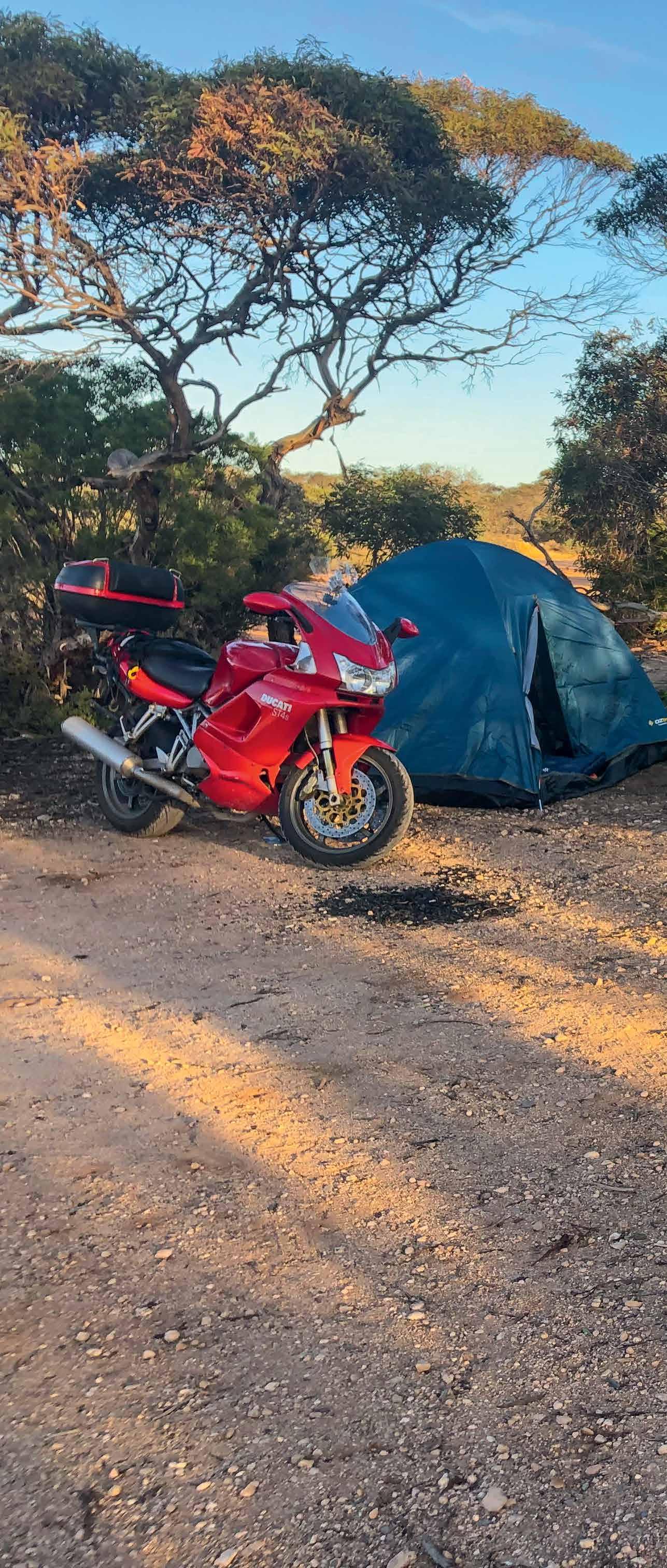


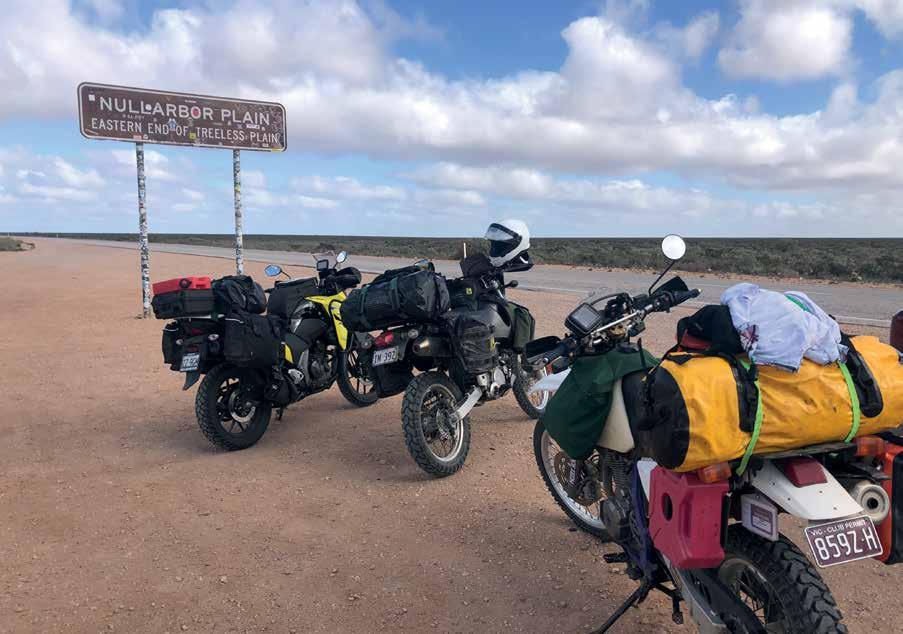
It was bloody freezing overnight but my new sleeping bag kept me warm. Set out for the north sort of planning Wilmington as a good day’s ride. Crossed the Murray at Waikerie and went on to Morgan for fuel where I met my friends Karen and Pete from Canberra, also going to the Border. Had morning tea with them before heading north and this is where the headwinds set in with a vengeance. I wound the throttle on thinking more cc would help and at one point was flat out using 4 litres per hundred (bugger). I pressed on and soon had lunch at Hallett and it was a very nice lunch with Karen and Pete. I then set out again into the wind and managed to arrive in Wilmington (351km) just as the wind died to nothing. I had taken the superbike on some gravel roads before leaving home but at Wilmington was the 1st time with a full load down to the caravan park.
I was impressed, never been so fast on gravel and I felt in full control, loving this. Next day past Port Augusta the back way (yes there is one, turn left after crossing the bridge) and out to Kimba. Now the long sections were coming along and I was just cruising at 90/95 and having a ball. Yep, this was great and the extra time on the road was good for the headspace, even had time to get out my movie camera and do some filming. Arrived in Kimba and saw two chaps stopped at a café, I asked them what the food was like and they said, ”tell you in half an hour” I joined George and Grant who were riding a DRZ400 and DR650.
After lunch, we rode together to Wudinna (304km) and I had to slow down a bit as they were riding at 80/85, this did my economy a great favour in the headwind. I camped and the two G’s moteled it and we had a great meal at the local pub a short walk up the road. Next morning the decision was made to go via Streaky Bay thus adding time and km to our journey. Great ride along some new, to me, roads and George found some gravel roads which was great and once again the little DL was fine. In saying fine, it was nearly the end of me. We were riding along at 90kmph or so when a crossroad came up. As is my normal practice I backed off approaching the crossroad and slowed down for a look when a car went through the intersection at high speed; just a few metres in front of me, just shows you a crash can happen anywhere. We camped at Penong; well, we shared a cabin at the caravan park (another 334km). On the Friday we all rode to the Border to visit the whale viewing point which was well worth the time and money (405km).
My friend Ian from Perth was waiting for me at the Border and we soon set up camp behind the roadhouse. We spent a lot of time catching up with old mates and making new friends before heading off to the Off Centre Rally (OCR), Ian was on his Ducati SP4s (a very unlikely adventure motorcycle but as it is Ian’s only motorcycle it doubles up as an adventure bike, kind of reminds me of the 70s and 80 when all motorcycles were adventure bikes including my Kawasaki 500H1). We met Grant and George at Penong and spent the next few days riding with them to Port Kenny, Cowell and Copley, we camping and they moteling it. On the Friday Ian and I rode into Arkaroola (SLOWLY), the 250 rider having fun with the

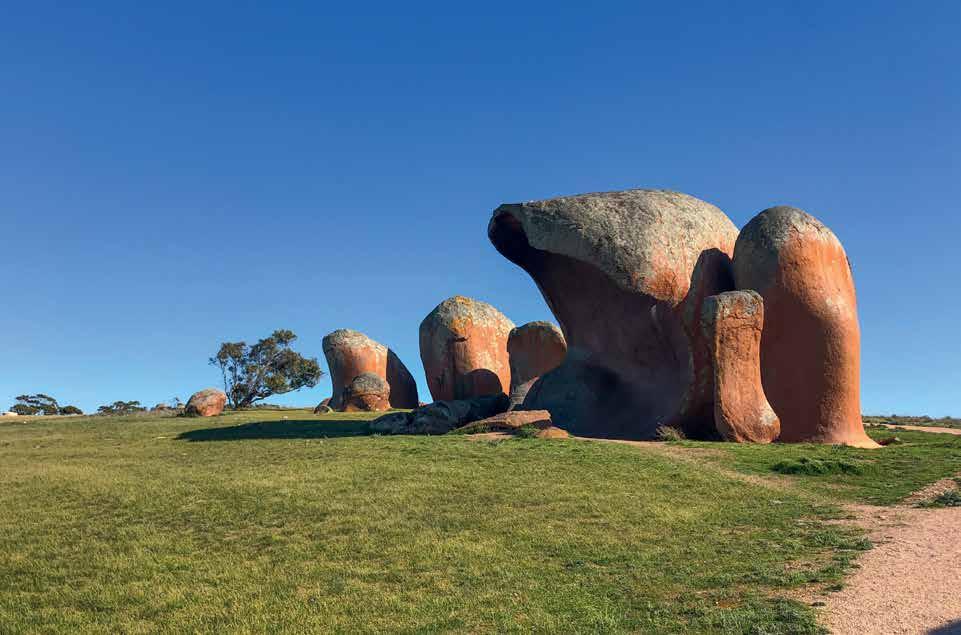
Above: Murphy’s Hay Stacks at Streaky Bay. Middle right: Hawker in South Australia is pretty much the gateway to the Flinders Ranges. Far right: Penong Windmills. Below: Beautiful Flinders Rangers.
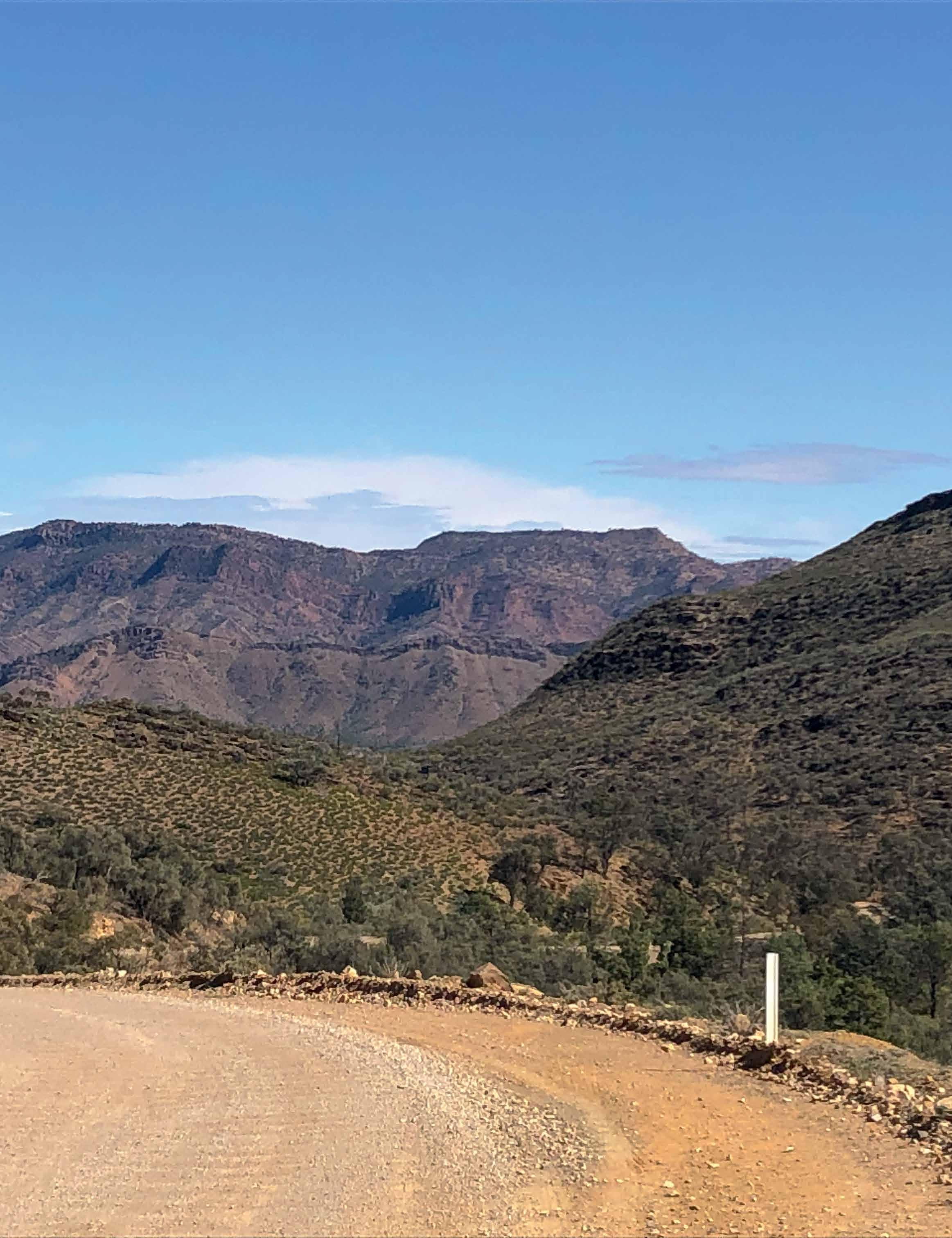


Ducati rider hanging on. We did pass Brenden riding his Vespa (200) so we were not the slowest, we also arrived unscathed. The rally was great fun, with old friends again and many riders having a great time mainly telling stories. The evening entertainment was good along with the meal we had. Ian and I looked about and could not find another Ducati or for that matter a 250 of any brand (Brendon came close with the 200 Vespa). Two days later we rode out with George and Grant and took the road to Wilpena Pound about 200km of dirt. Arriving safely Ian and I went on to Carrieton for the night. Next day we rode the 805km to my home in Victoria, yes over 800km in a day. Total distance for me of 4,822km at about 3.5 litres per kilometre at 90/95 kmph.
My thoughts on riding a 250 to the Border and Arkaroola. It was FUN, a lot of people looked at me sideways and I could hear them thinking idiot, mind you having Ian riding the Ducati did deflect some of the smirks.
In conclusion, I have some thoughts on riding a 250 all that way. I must start at the beginning. My 1st motorcycle was a Suzuki T200 Invader and its cruising speed was 70mph and that was its normal speed so riding a DL250 was not much different. I loved the lightness and ease of manoeuvring, both while riding and in the parking area. The 250 also took the worry out of riding on gravel, once again the lightness was a major factor, in other words, it was just plain FUN and that is a big part of riding anyway. Would I take the 250 on another long ride, well in answer to that I have a Darling River ride planned and yes, the Great Central Road/Plenty Highway are looking good for future rides. Gravel roads used to intimidate me, no longer. And let’s not forget Mt Augustus in WA in two year’s time, Ian reckons the Ducati is up for the ride!
Few thoughts on the DL250, good things 1st, extremely comfortable (for me), just the perfect seat, bar and peg positions, better than my 650. Extremely smooth and efficient engine with just enough power (yes, I know when you have too much power you have nearly enough). The finish was good and fitting my extras was easy. Plenty of room for a tank bag and luggage. It is an easy all day ride and going slower on such a comfortable motorcycle means at the end of the day you are feeling relaxed and needing a beer. Minuses, the instrument panel is terrible, bloody impossible to read in some light conditions (good at night) and the throttle coming off idle is like a light switch, please fix Mr Suzuki.
Overall, I just have to remind myself that Suzuki built a 250 commuter motorcycle and it would be great at that now I have changed it into an adventure motorcycle, big ask but it does it with great smoothness and comfort, just a little slower. Having fun!






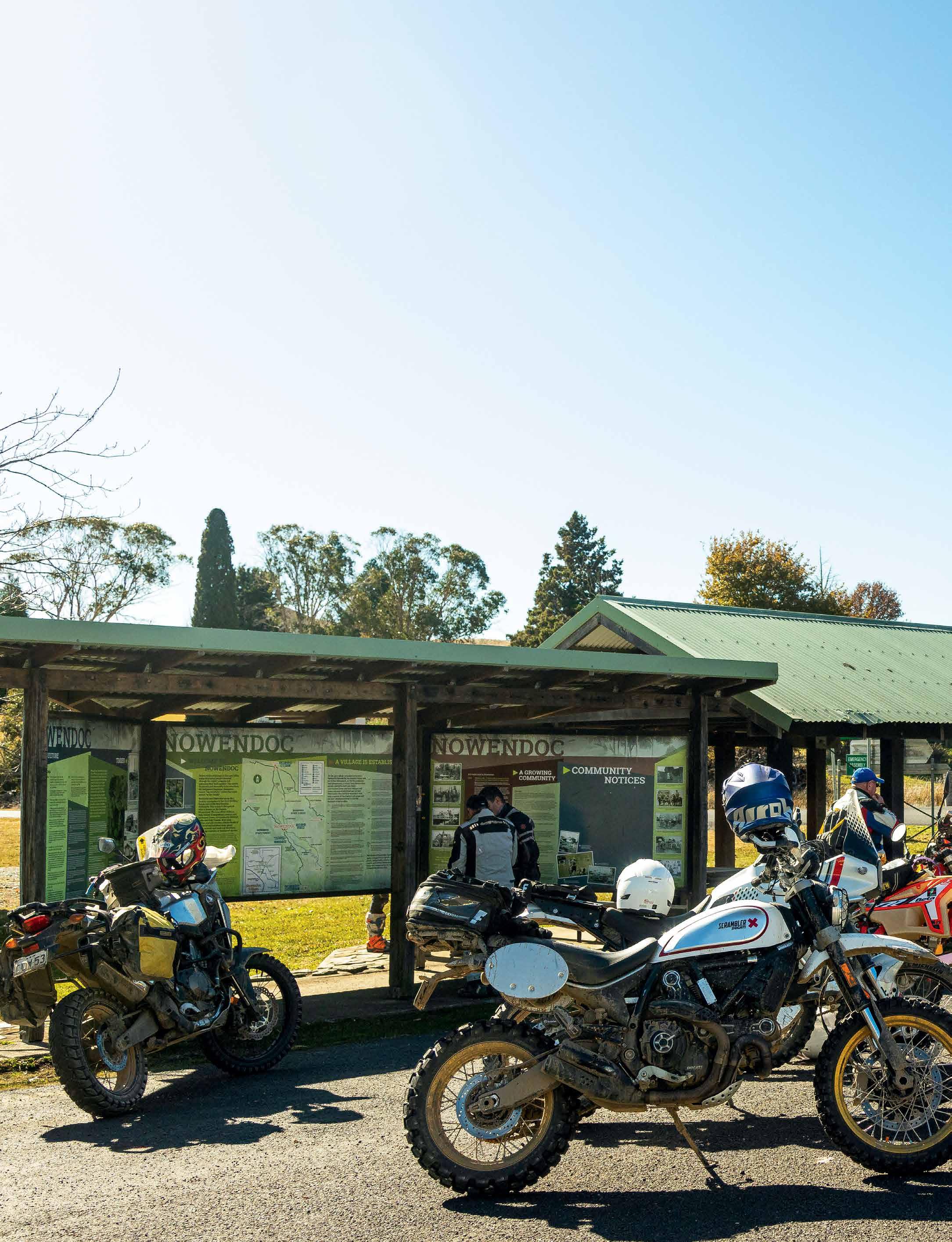

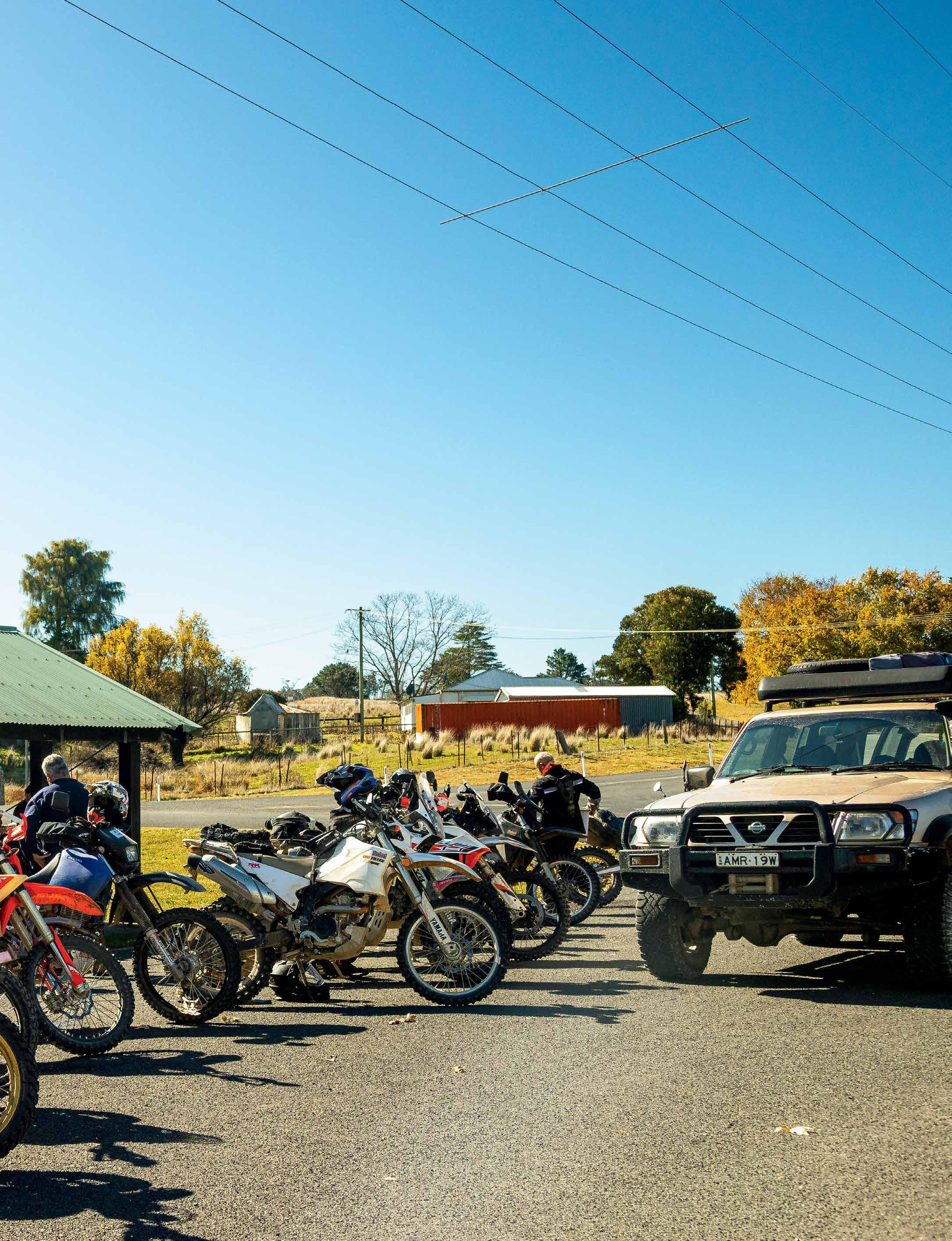


What is behind those mountains? What kind of roads? Would they be private ? Dead ends? Too rough?
These are the questions I kept asking my girlfriend every time I came up to visit her in Armidale from the Widden Valley in the Hunter where I work as a midwife for horses.
Riding an egg bike at work wrangling mobs of thoroughbred foals or leading a cranky mare on the bike from paddock to yards does not feed my hunger for adventure. I’m always looking at maps to get off the beaten track.
When I found the Endeavour ‘Thunderbolt’s Escape’ ride I was ecstatic...I couldn’t wait to see what was behind those mountains in the New England high country, following in the tracks of the bushranger Captain Thunderbolt.
So, I saddled up my trusty Mothership; a BMW 2007 Gs1200, held together with zipties and duct tape, and headed up to Gloucester where the meeting point was. We Spaniards know our gold, and I was keen to get up and at the dirt roads into the old gold mining towns and find out the truth about the man who preyed on the gold diggers. I also have a personal connection to


farms
Right: One of the many water crossings for the day. Bottom right: Just some of the amazing trails and views in the mountains.
him which I later found out was more than I thought.
Kye Anderson, the owner of Endeavour, certainly delivered the thrills (and spills) I was looking for.
At the meet and greet at the bustling Roundabout Inn in Gloucestor on Thursday afternoon, there was a mix of riders signed up for three days of bushranging. Little did we know that we’d be down one before we reached the 100km mark the next day. One bloke from Brisbane rolled his bike in the first hour of the first day, but still managed to finish the day riding with a partially dislocated collarbone.
Kye and Lesley are 34 but the rest of us were in our 50s. Endeavour can take as many as 15-20 out, but Kye prefers the smaller rides where he can deliver a more personal experience, especially when he has so much history to tell us.
FRIDAY 14-6-24 312km Ascent 6604m
After a good night’s sleep and breakfast at Hebby’s bakery which even serves a Thunderbolt blend of coffee from

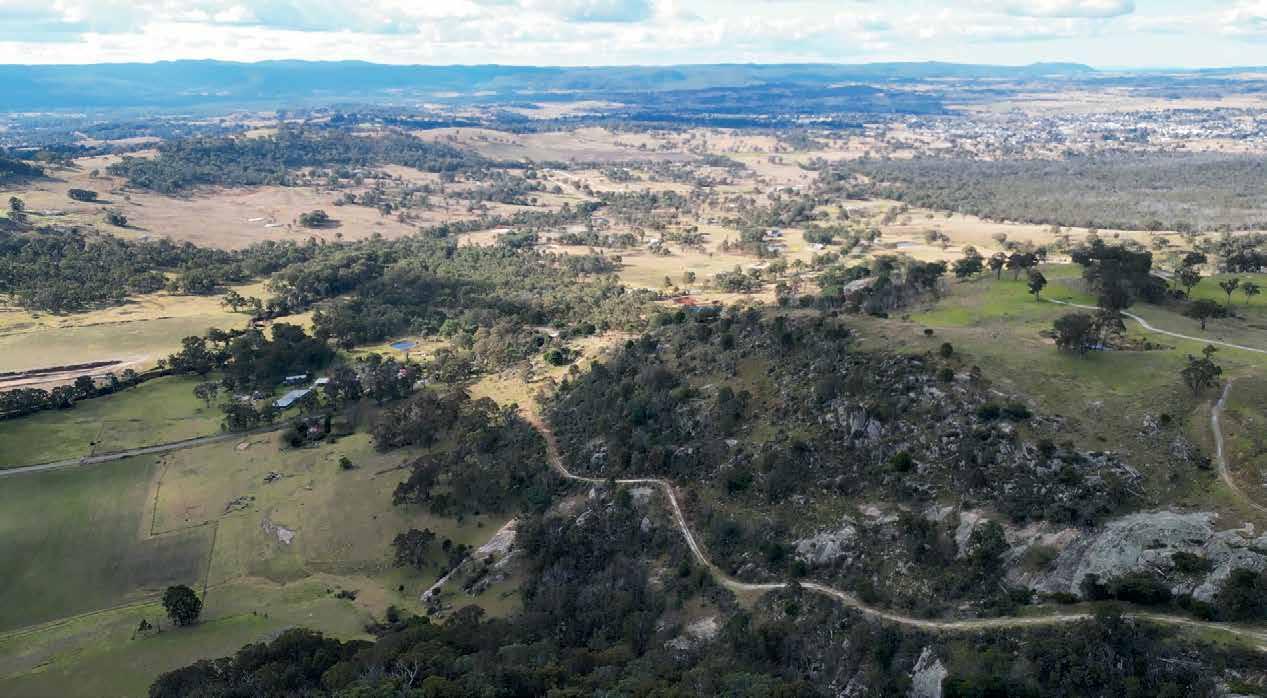
Walcha, we headed up to the Mograni Lookout for a briefing on the Bucketts way just a few ks out of Gloucester where we admired the view over the Barrington Tops. But we had 200kms to cover on the iconic Thunderbolt’s Way road (which goes from Gloucester all the way to Inverell via Uralla and Walcha) and the Great Dividing Range to conquer. Kye was keen to get us up and over ASAP as he had no idea on how each of us would handle the off the map routes through farms and national parks that only he has riding access to (his rides have the rare National Parks stamp of approval.)
Not being 100% confident on gravel roads on my bigger bike (the others were on lighter 650s), I was taking precautions and riding leisurely at my own pace. With Kye’s cornering system, they didn’t have to wait more than a few minutes for me.
Kye started his career as an international rider for KTM, testing new bikes and competing in Europe and now is sponsored by GASGAS who supplied his bike for the Thunderbolt tour. Fred Ward, (Thunderbolt’s real name) was also always after a younger, faster horse, and on his visits to the Widden Valley he stole some of the best racehorses and rode them to death.
We stopped roadside at landmarks where Thunderbolt would have taken a breather, and Kye was always ready with a historical fact about him that built a picture of a pretty reckless renegade and made us bikies look pretty tame!
We hit gravel passing through the town of Nowendoc which aptly means ‘rough ground’ in indigenous language. I was ready for plenty more of that and was enjoying it big time. Kye tells us that in the gold rush days, there was a pub at the bare lookout where we stopped and that the circus used to come to town.
Kye showed off his speed when he gunned it through forestry roads where the wallabies were barrelling by almost as fast as the timber trucks coming out of Gloucester - all we could see was a wall of chrome and flying stones. We rode all on public roads through the forests and passed through the most spectacular scenery of valleys and mountains as we climbed the 6600 feet into the highlands.
Lunch was catered deep in the Nundle forest with an improvised fire and a great spread of hot food that kept the energy up for ‘the road of a thousand bends’


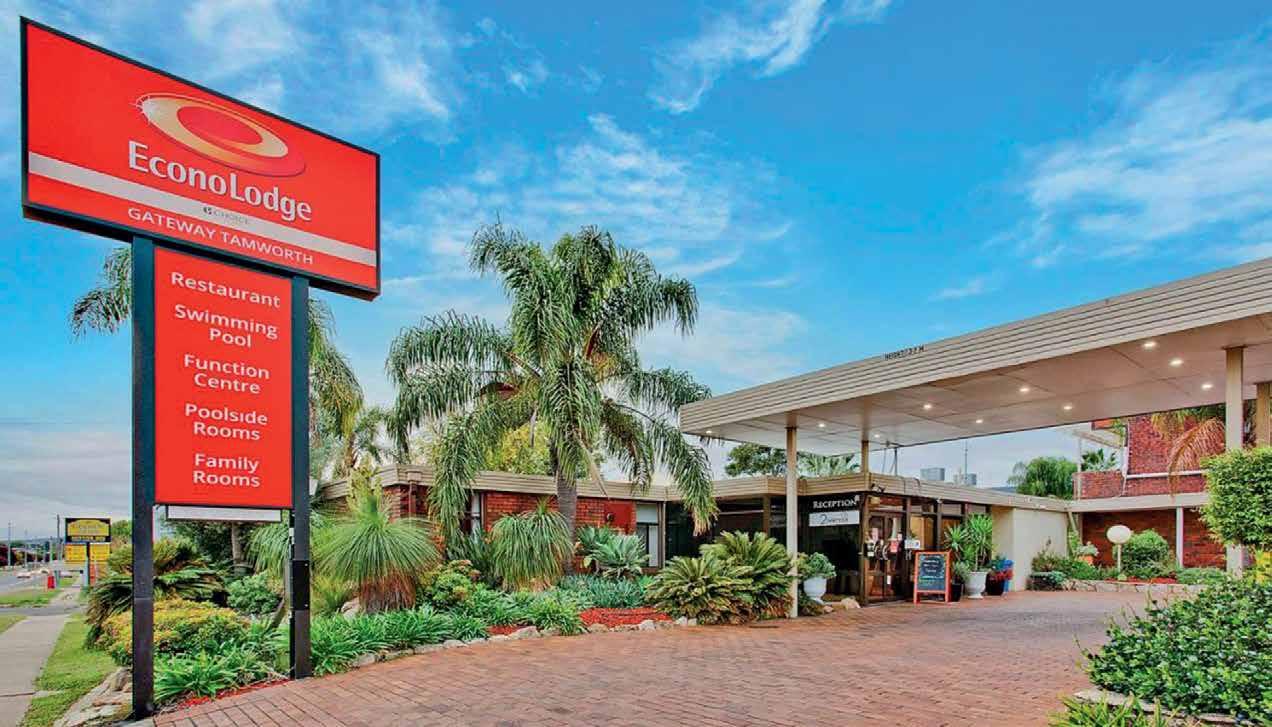
(there is one of these in the Costa Brava of Spain too).
We made it to Nundle, an 1850s gold mining town on the Peel River less than an hour from Tamworth, and checked out the old mining site sitting right next to the road.
We got into the Econo Lodge in Tamworth at the respectable hour of 3pm. A thoughtful Endeavour touch was the valet service into the motel - barely had I got off the bike before I was handed the keys to the room - relaxing on clean sheets in next to no time.
This was the biggest day of riding and where we got closest to the trail of Fred, or Thunderbolt.
“ After Thunderbolt held everyone in the pub hostage, the police chased him down and shot him. But he mysteriously turned up at the Glen Innes horse market making people think it was his lookalike brother who was shot. ”
After breakfast, we started on the stunning Moonbi lookout which is perched on a granite rock similar to the much graffittied boulder outside of Uralla, where Thunderbolt could look over the sweeping plains to where he was going to rob next.
Outside of Tamworth the cattle stations started and tarmac turned into dirt and we were pounding the cattle grids hard. I was having an awesome time but I must have hit a cattle grid the wrong way on the back tyre and Todd the sweep rider and I had to pump it back up at 40 PSI to be safe and make it to Walcha. With the tyre holding pressure out of Walcha, we carried on but with the 40 PSI, the gravel spun like a coin on a mirror. We encountered a few showers which made roads even more challenging.
We pitched for lunch in Uralla next to the only grave with fresh flowers. You guessed it, Thunderbolt’s, or was it? Kye
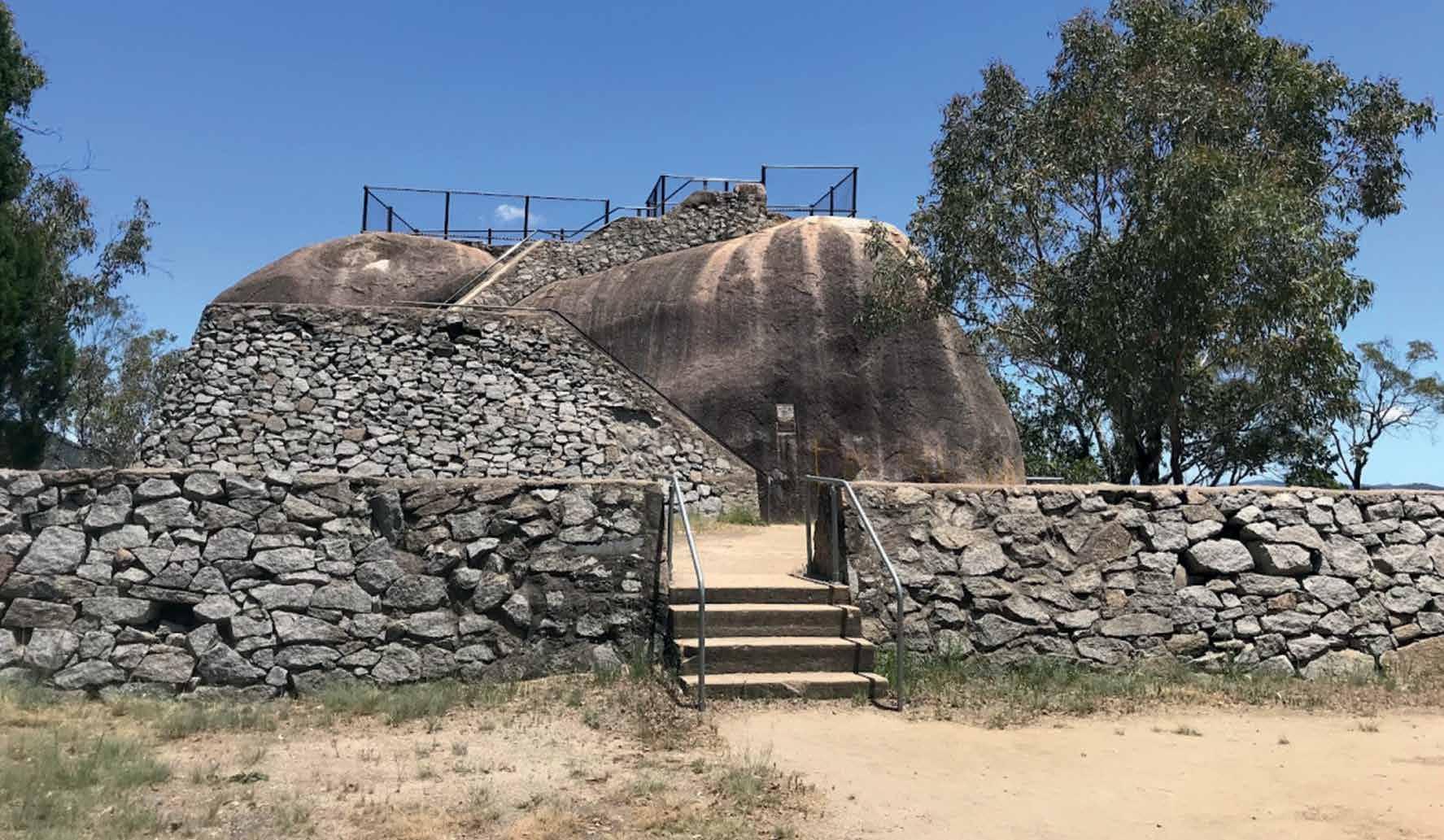



told a different story… after Thunderbolt held everyone in the pub hostage, the police chased him down and shot him. But he mysteriously turned up at the Glen Innes horse market making people think it was his lookalike brother who was shot. And Thunderbolt’s name was even on the passenger list for a ship to America. Sounds like a Mexican telenovela to me.
After admiring Thunderbolt’s lifesize bronze statue on the main street of Uralla, we headed off to the spooky Gostwyck church and past a giant yurt that is where they shear the sheep around Armidale. We admired the very full Dangar Falls. My favourite bar in Armidale is named after an Italian stuntman, Signor Vertelli, who walked over the Falls on a tightrope in 1866.
That makes our assault on Thunderbolt’s cave seem easy, though it was the toughest part of the tour.
I loved the more technical rough terrain getting to Thunderbolt’s cave and it was the highlight of the day though I was not expecting it to be so tough after what we had done up till then. Fred holed up there with his indigenous wife Mary-Ann Bugg whose tribe suggested the cave as a refuge.
Getting to the cave got a bit gnarly and wet and I dropped the bike in a puddle. Yes, a puddle. On the gravel farm tracks it had been getting warmer, rainier and more humid and my glasses in my new Arai helmet got foggy and I couldn’t see the road - it was like being in a diving mask. I panicked and things started to get complicated.
I managed to clear the glasses but it was wet and pissing down, but I got down the hill as good as I could. There was thick scrub on all sides and deep ruts. I just kept going, and there was only the sweeper Todd coming after me. There was a big puddle down the bottom of the hill, I saw


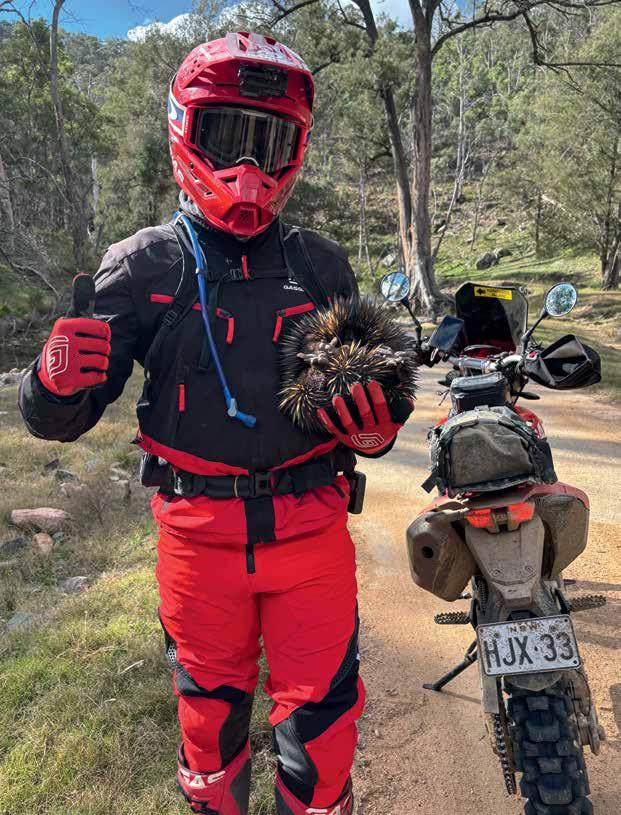

the tracks, the lead rider had gone through and others took the short cut round but I miscalculated and dropped the bike on the edge. I blame the heavily inflated tyres but I wasn’t quick enough to make the call.
I reassured them that I was ok and I still wanted to get to Thunderbolt’s cave. I looped back to the cave and the lead rider was waiting up the top for us. I wasn’t too shaky but everything felt like it was in slow motion. It wasn’t the most elegant ride up to the cave, but joder, I nailed it!
We could have stayed in Thunderbolt’s impressively big cave, which even has a fireplace and a natural chimney, but we got into the Guyra motel with time to spare at 3.30pm, plenty of time for a few cervezas.
On our last day, our first stop just outside Guyra was Ward’s Escape named after where he was apparently last seen before his alleged escape. The weather was highland clear, but cold and crisp and I wished my heated hand grips were working. Kye led us through farm land, gunning it between gates and I got suspicious we were escaping farmers, but they told me it was all above board as this is Endeavour with exclusive access to areas.
After three days on the trail of Thunderbolt, I imagined myself in his shoes, I mean instead of riding flesh and blood horses, we were riding iron steeds, and I looked at the cows and homesteads as he might have - plunder! As a Spaniard from Madrid who’s been here for six years, the ride caused a real change of perspective of the Australian landscape for me.
We rode to the World Heritage Guy Fawkes National Park, and I felt right at home seeing some brumbies that could be descendents of Thunderbolt’s nags.
Heading into an area called Gindaaydjin, meaning ‘plenty of big round stones on clear plains,’ we had lunch amongst the prehistoric stones of Glen Innes, their version of Stonehenge.
We finished on the Mount Mackenzie lookout which is one of the highest peaks overlooking the northern tablelands and the Boonoo Boonoo and Girraween National Parks, 1300m above sea level. We said our goodbyes and kisses at Tenterfield at the Royal Hotel where Thunderbolt might have had a drink after 1849.
Over a cerveza, I think back to my own connection with Thunderbolt in my region of the Hunter Valley. 180 odd years ago, one of his girlfriends lived in Sandy Hollow, a little town just 50km from my farm. Thunderbolt also hid out at Widden which was breeding thoroughbreds from 1857 and he would steal horses to ride from there. I’m told his cave is still on the property, but I am yet to find it.
Another adventure to be had on the bike after this epic one with Endeavour.
DISCOUNT CODE Juan10 for ten percent off any advertised Endeavour Motorcycle Tour.




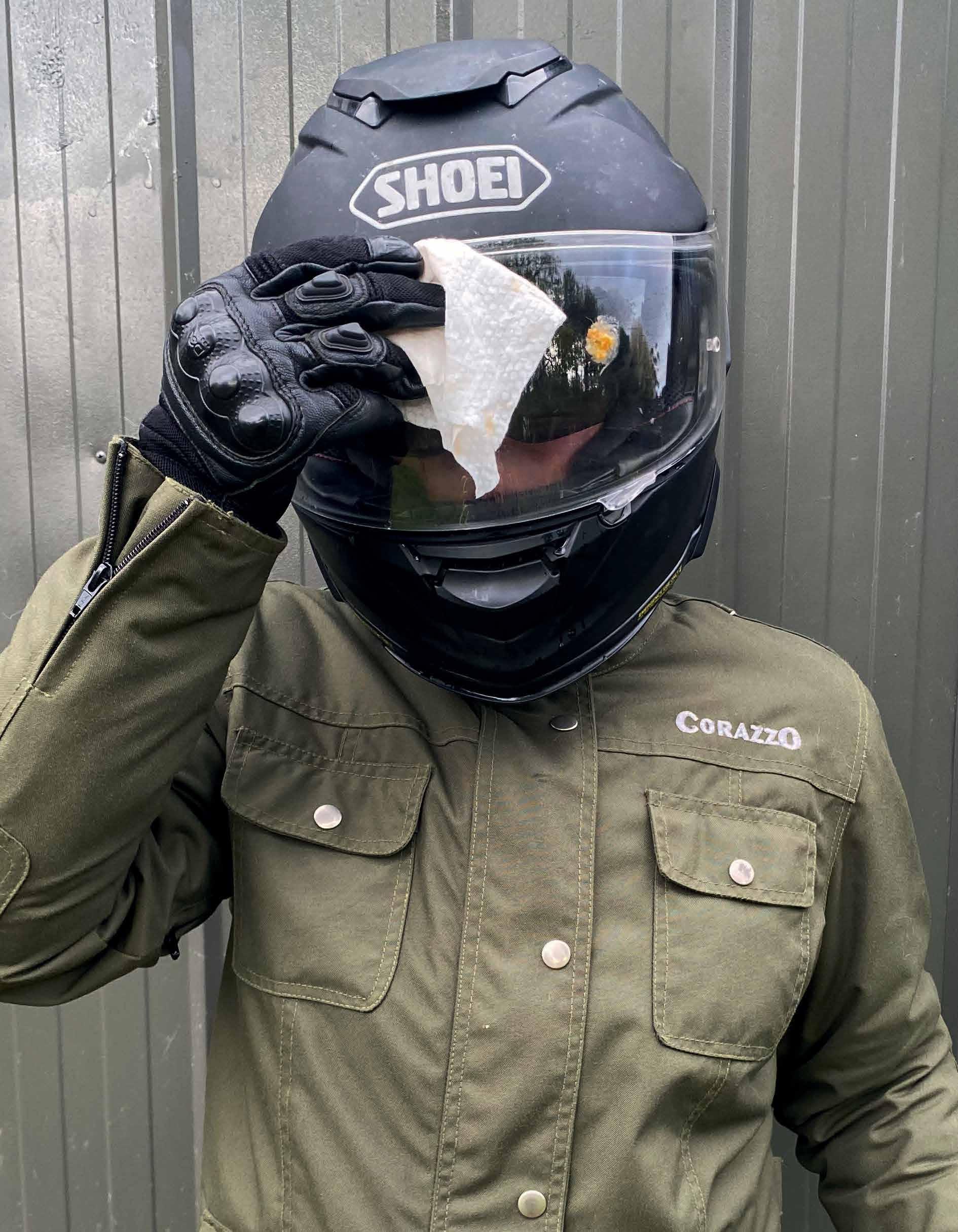
By Heather Ellis
ith spring and summer in southern states, comes bugs… lots of bugs. Riders in the north, no doubt, deal with bugs year round. And there is nothing worse than the ooze of a splattered bug and/or the specs of lots of bugs on your visor. My answer to this dilemma was pulling into a servo and using the dirty windscreen water and then wiping my visor dry with paper handtowel, which may or may not be available. I won’t even think about how many tiny scratches I’ve put in my Shoei helmet visor in the process. A replacement, by the way, costs $110.
WDevil Wipes founder and rider Mick Spiller did the same until he thought there had to be a better way. So when he sent me the gift of four packs of Devil Wipes, cleaning my visor would now be instant (no putting up with bugs until I passed a servo); actually do the job properly; and not damage my visor. Each handy slim resealable pack of eight wipes fits snuggly inside my jacket. And at around 70 cents per wipe you can reuse depending on how many squashed bugs you’ve wiped off your visor. The secret to Devil Wipes is the non-woven porous fabric soaked in de-ionized water. The wipes are safe for use on poly carbonate and tinted lenses and don’t contain chemical cleaners and are free of abrasive, alcohol, ammonia, and petrochemicals. So no smears either. And to honour the ‘Devil’ name, 10 cents from each pack is donated to Save the Tasmanian Devil Program.

Devil Wipes are only a temporary fix to cleaning a dirty visor so once home, you still need to wash your visor with a soft cloth and mild soapy water and rinse with clean water.
You can buy Devil Wipes online at: www.devilwipes.com Or ask at your local motorcycle shop.
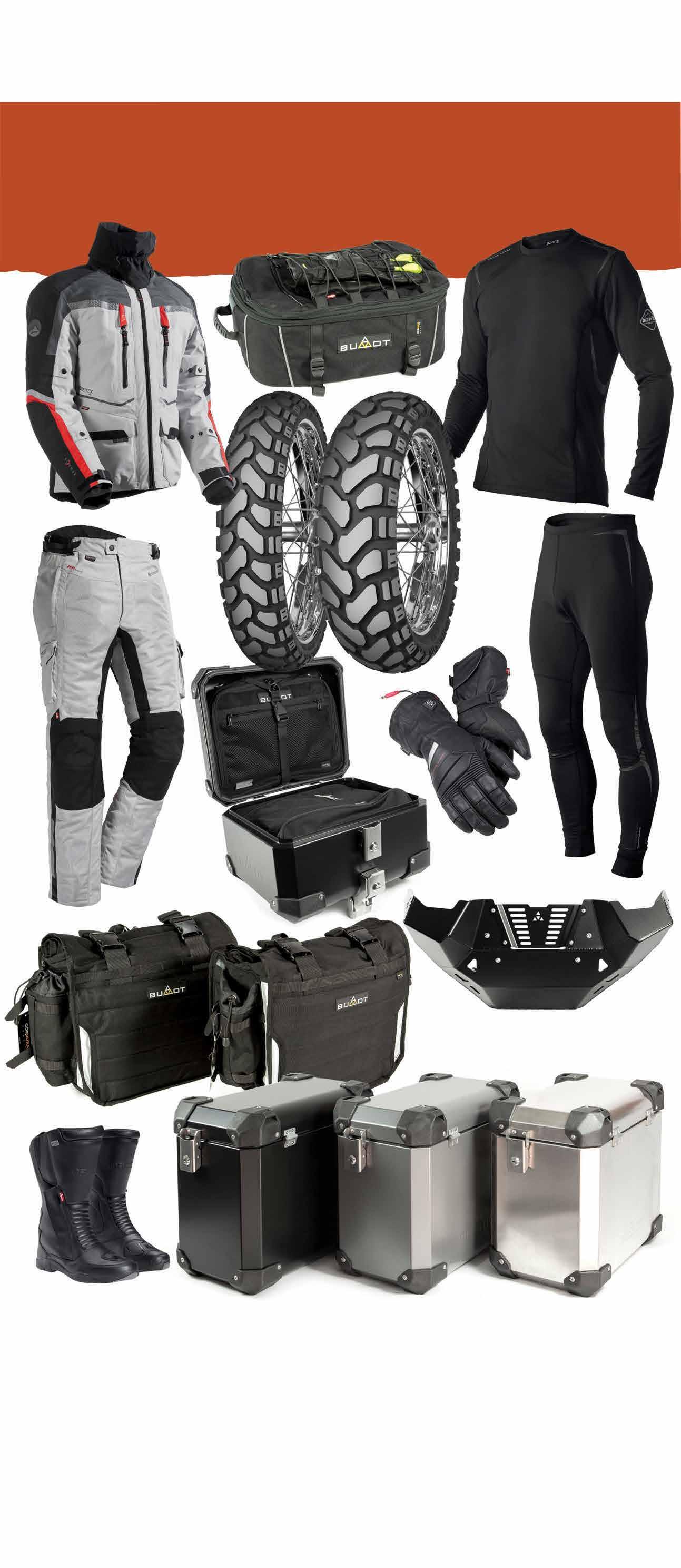












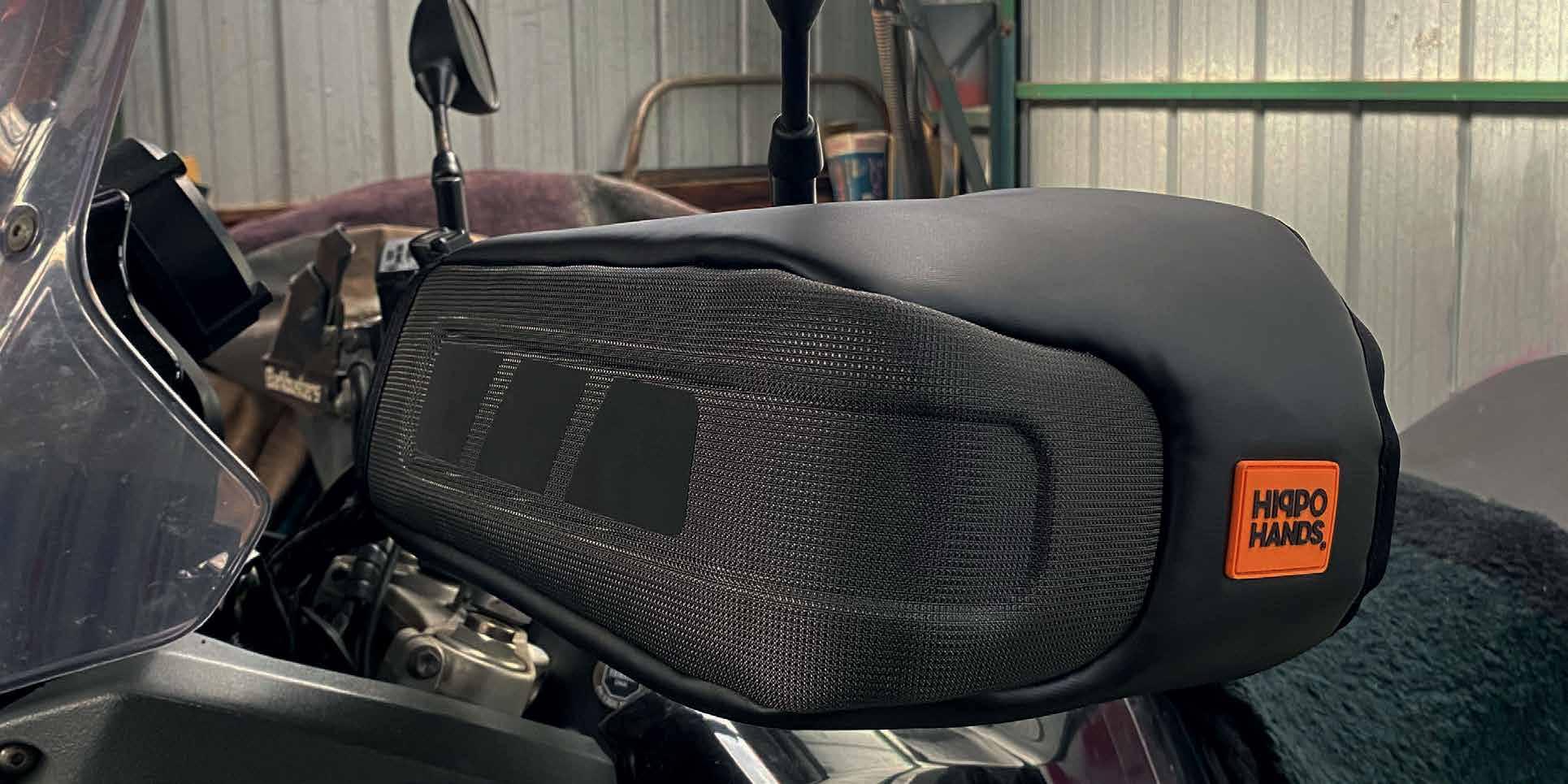

Words and Photos: Heather Ellis
Motorcycle hand covers or muffs as these are often called, saved my hands from freezing winds and icy rain while working as a motorcycle courier in London in the mid 1990s. Despatch riding was how I topped up my travel funds after my ride through Africa on my Yamaha TT600. Fast forward to 2024 and while I ride year round in Victoria and sometimes in rain, which means wet gloves, I don’t use muffs. This is because getting caught in a downpour only happens occasionally, and once home, I can dry out my gloves before my next
Above: Hippo Hands ‘Backcountry’ has a sturdy waterproof outer shell but need to be fitted over hand guard protectors like Barkbusters.
Left: Hand covers saved my hands from freezing rain and icy winds while working as a London despatch rider in the mid 1990s.
ride. But when touring in Oz or on an overseas motorcycle adventure, this is not always possible. And no matter how high the waterproof rating, all gloves will get wet in a torrential down pour or hours of riding in rain. If you’ve found a pair that stays dry, please let me know. Water gets in and saturates gloves eventually. And wet gloves mean cold hands.
In London, my handlebar muffs kept my hands, encased in winter gloves, warm and dry during the year I was a despatch rider including a long wet and very cold winter. I can’t remember the brand I used back then, but today there are many brands selling various styles to suit different bikes and riding styles. I was recently asked to try out a pair of Hippo Hands ‘Backcountry’ motorcycle hand covers and what impressed me at first was how light weight but robust
Right: Hippo Hands ‘Backcountry’ has padded insulation and a narrow opening to keep hands warm and dry, but aren’t too bulky for standing up when riding off road.
Middle right: Hippo Hands come in 3 different sizes. Bottom right: The Backcountry features a front reflective panel for higher visibility in low light situations.
these are. Hippo Hands is a US brand and have been around since the 1970s. It all started when founder Craig Vetter, while on a long chilly ride with freezing hands, wrapped his sleeping bag around his handlebars using duct tape. Today, there are three models Rogue, Alcan and Backcountry, all for different climatic conditions, bikes and riding styles. All are black and need to be fitted over handlebar guards such as Barkbusters, which secures the muffs in place with several velco attachments. This makes fitting and removal quick and easy. The smaller Backcountry model, with reflective panels on the front, is best suited to enduro, mid-sized adventure, dirt bikes, Harleys and commuters. The 23cm depth, means you can easily stand up with the muffs not getting in the way while riding off-road.
I’m in the early days of planning my South America motorcycle adventure, and was recently chatting to a friend who had just returned from her own solo ride from Peru to Argentina. ‘I wish I had a set of those in Patagonia,’ she’d replied when I told her I was reviewing the Hippo Hands hand covers. Icy winds and freezing rain are all part of an adventure ride in the far south of South America, even in summer, she told me. While the muffs are light, these are rather bulky, and when I reached warmer climes further north, I’d need to be strategic about packing in the bottom of my panniers. Space is at a premium on any adventure ride.
Remembering my courier days during a London winter, muffs don’t really keep your hands toasty warm at slow speeds. Cold air is still going to circulate inside the opening as the Hippo Hands Backcountry doesn’t have a cuff like the Alcan model so I’ll still definitely need winter gloves. But combined with heated gloves or heated grips, you’d be very toasty indeed while touring. It’s at highway speeds when muffs work best to cut down wind chill. But, by far the biggest advantage of muffs is keeping gloves dry when it’s raining. Wet gloves mean cold hands and wet

gloves take ages to dry out. While touring or on an overseas motorcycle adventure, you may not always have somewhere to dry gloves for the next day’s ride. All Hippo Hands models have a waterproof outer shell with layer of padded insulation inside. The Backcountry is the smallest model (23cm length), with a narrow flat opening, so rain is not getting in easily, but you can still see the controls. But water will run down your arms and into your gloves if not tucked into your jacket. The thing I also like about the Backcountry model is it feels very sturdy like it would stand up to a few tumbles and being bashed against branches on narrow dirt
tracks. The Hippo Hands Backcountry even kinda fits in with the bike. But muffs arn’t something I’d have as a permanent fixture on my everyday bike unless life suddenly went pair-sharped and I found myself as a door dasher. However, for touring over several days or weeks when rain was expected and when on an overseas motorcycle adventure that can last months to years, I’d definitely pack my new set of Hippo Hands.
Hippo Hands Backcountry hand covers retail for $249.95 www.hippohands.com and click on the link for Australian orders


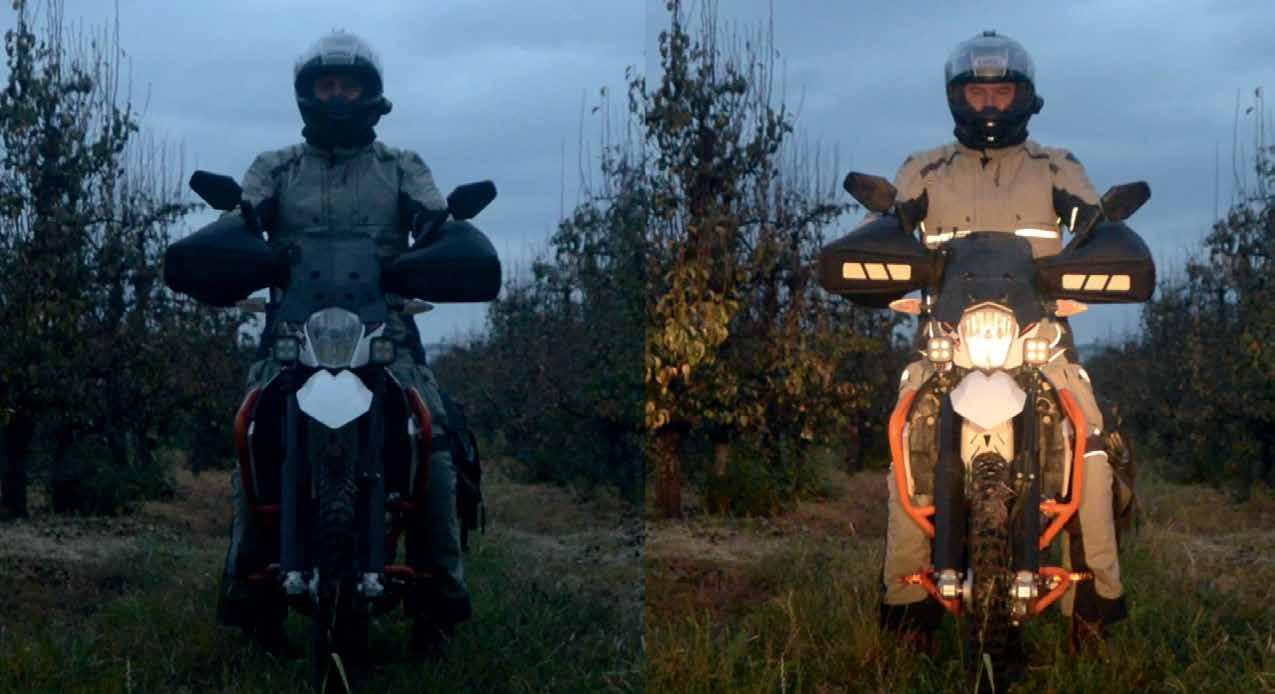

Words and Photos: Bob Wozga
ecently, I was privileged enough to be given a pair of Boss-Dyn-01Jeans and a Falcon Leather Aviator Jacket supplied by Pando Moto, an apparel company based in Lithuania.
RDon’t be misguided by the fact that Lithuania was part of the old Soviet Union and so the style and quality will be second or third rate. They are a leading
motorcycle brand in Europe. Their origins go back to 1936 where riders were hard and their pants and jackets were harder, Pando has used European design and engineering to create premium motorcycle clothing concentrating on safety, quality and durability. They cover everything from gloves to booths, armor and everything in between. When opening the box, my first impression of the
jeans and aviator jacket was the weight. They are heavier than my usual jeans and jacket I usually wear. The Boss-Dyn-01 jeans are heavy good quality denim with solid stitching. They come with padded inserts for the knees and thighs and when fitted into their pockets, they don’t protrude making you look like you’re wearing floaties about to go into the Bondi surf for the first time. They have a European style, and I found them to be a very comfortable fit. Some riding jeans I’ve tried in the past just didn’t fit right, sag where they shouldn’t sag and length that seemed too short. The outer layer of the jeans is made of Cordura Denim which is a blend of military grade nylon, 606 staple fiber and cotton. The inner lining is made of ultra- high molecular weight polyethylene which is light weight but extremely strong.
The material has been thoroughly tested and given a AAA rating which gives you a drag time of 6.7 seconds or 71 metres whichever comes first. That is a long way to skid along the Hume Highway. I must admit that I wasn’t prepared to test and prove otherwise. I will confirm that they are very comfortable, deep pockets, being stretch jeans, they don’t deform after riding for a day, and I didn’t feel any uncomfortable temperature changes in my legs with wind chill when riding from Sydney to the Southern highlands where the temp changed 6 or 7 degrees. This makes them a good year-round pair of jeans to wear.
The Falcon Leather Aviator Jacket is again a heavier motorcycle jacket that I’m used to wearing but is very comfortable and fits well with a good length of sleeve and the rib around the neck does not choke when zipped right up. The Aviator Jacket may seem a little old school, but it still looks cool. Tailored from 1.12mm goat semi-aniline leather that makes it very durable and soft enough that it doesn’t hinder movement while riding and the oil content in the goat leather gives it water resistant properties. The jacket is stylish enough to be worn anywhere and the quality of the jacket is evident as soon as I unpacked it from the box. The side pockets are deep and easy to zip and unzip. The inner waterproof pocket could be a little bigger to fit your wallet and phone. An inner quilted liner unzips easily and is only a vest, this is a good thing and prevents your hands getting trapped,

pulling the arms out if they are damp. With and without the inner liner, I didn’t feel any uncomfortable wind chill on the expressway with the temperature change riding to or from the Southern Highlands. The jacket comes with ultra-thin elbow and shoulder armor that does not protrude and the back has pockets for optional Quatroflex Motorcycle Back Armor. It is recommended to purchase the back armor for extra protection if you happen to skid along the Hume. The Jacket has a AA rating which gives it a drag distance of 35m or 4 second drag time. I was not prepared to do a crash test to prove them wrong. The jacket is breathable enough to make it ideal for both summer and winter riding.
I was impressed with the quality and fit and style of both the Boss -Dyn-01 Jeans and the Falcon Leather Aviator Jackets. A lot of thought has been put into producing a product that focuses on the delivery of high- performance
protective clothing for motorcycle riders.
Both the jeans and jacket have come with the option to extend the warranty to 3 years and can be accessed by scanning the QR code that come with the product tags.
They produce protective gear for both male and females.
Their website is easy to follow and has made the arduous task measuring sizes simple, alleviating the frustration of sending back clothes that don’t fit.
The Australian distributor is https: www.motoest.com.au/collections/ pando-moto
Boss-Dyn-01 Jeans retail for $351.00
Falcon Leather Aviator Jacket Black retails for $505.00
Quatroflex M-XXL- Motorcycle Back Armor (Optional) retails for $50.00
Thank you to Pando for sending the jeans and jacket to do a review.



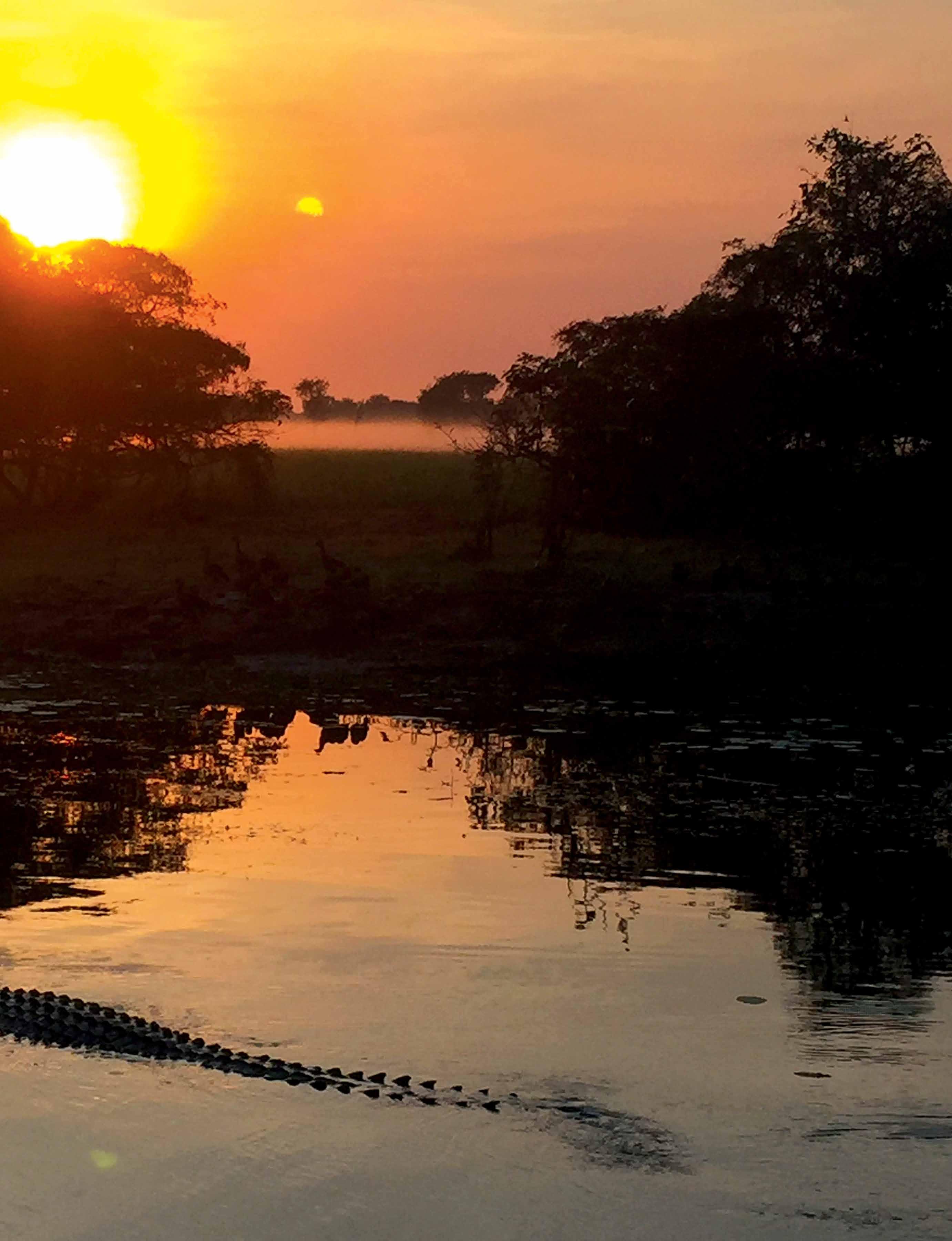

Kakadu, tops the list of my favourite adventure rides. Once you’ve made the trek to Kakadu National Park, in the Northern Territory, you’ll want to stay at least a couple of weeks exploring this timeless ancient land that covers nearly 20,000 km² with its Aboriginal culture dating back more than 65,000 years.
While Victoria has been my home for the past 23 years, long before Victoria and long before my travels across Africa and Central Asia, I was a Territorian. I lived and worked in Kakadu as a mine worker: a radiation safety technician at the Ranger Uranium Mine near Jabiru, 250kms east of Darwin. The Ranger Mine closed in 2021 and mine clean-up and revegetation is underway. All will be reabsorbed back into Kakadu and the township of Jabiru handed over to the Aboriginal traditional owners, the Mirarr people, with plans to

make it a hub for tourists. As a World Heritage site, visitors to Kakadu both from Australia and international, continue to grow with over 200,000 people a year. Kakadu was my home from 1981 to 1993. My only transport over those years was a series of dirt bikes until I graduated to my Yamaha TT600. There was a group of us back then riding either the Yamaha TT600, the XT600 or the Honda XR600 and there was many a weekend we’d head off to one of Kakadu’s gorges relishing in riding the challenging 4WD tracks. Today, some are graded dirt with teeth-charring corrugations (which I discovered on a recent family 4WD trip), especially the 65kms of dirt into Jim Jim Falls. Unfortunately, the once famous ‘jump up’, (a rather tricky section) is now bitumen. But other 4WD tracks are still an off-road riding challenge with some creek crossings and sandy patches. You’ll need to plan your visit with the dry season; June to September, as most tracks are closed in the wet and it’s too bloody hot, humid and wet outside these months anyway.
As you’ll likely to be riding up from southern states, I’d take the back road into Kakadu from Pine Creek taking the track into Gunlom Falls (if it’s been re-opened). Gunlom was one of the locations for the filming of Crocodile Dundee. Further along the track is Koolpin (Jarrangbarnmi) Gorge which has a series
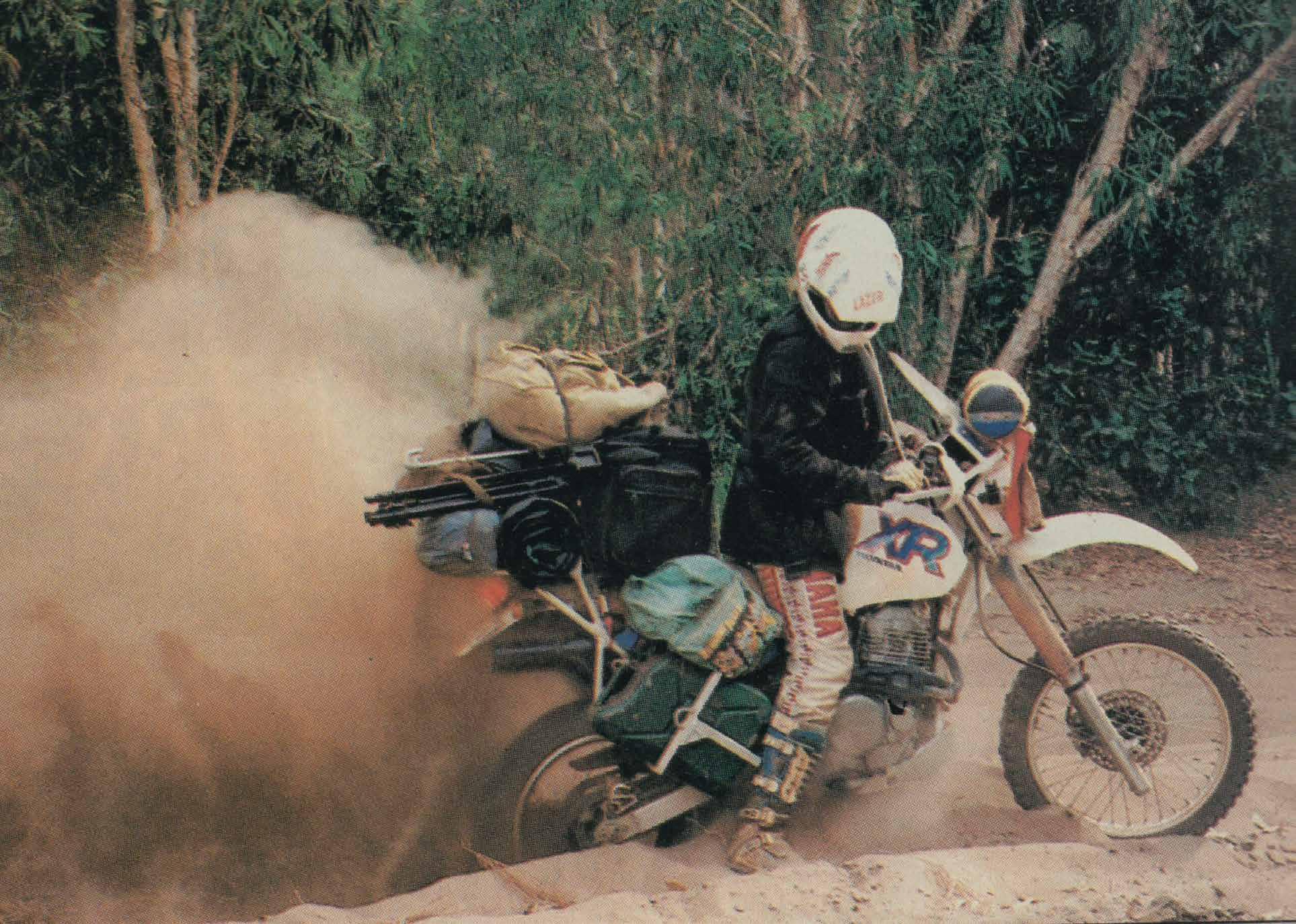
Top far left: My Yamaha TT600 new in 1992 and the perfect bike to explore Kakadu’s more challenging tracks.
Top left: Kakadu National Park map.
Above: Bill from Victoria, rode his Honda XR600 to Kakadu seeking adventure and found it on the track to Bilkbilkmi (Graveside) Gorge.
Right: Kakadu’s rivers are teeming with salt water crocodiles like this one in the East Alligator River near Ubirr.
of seven large rock pools. You’ll need to pre-book a permit. Make the effort to get a permit as Koolpin is often deserted. There’s a locked gate but you’ll pick up your key (issued with the permit), from the Mary River Ranger Station, back along the Kakadu Highway. All this information will be provided to you with your permit. After exploring Koolpin Gorge area, hiking, camping and swimming for a day or two, and a stop at Gunlom (if opened), head to Majuk (Barramundi) Gorge. It’s an 11km dirt track off the Kakadu Highway winding through giant termite mounds to the campsite. It’s a short ride to the gorge


but you have to walk a short way to reach the rock pools and waterfall. This is one of my favourite places and swimming in the pristine waters with its plunge pools with rock swim-throughs on top of the falls is unforgettable. There’s a few fresh water crocs in here but no salties or ‘mud geckos’ as we call saltwater crocodiles in the

Territory. In fact, there’s freshies in most of the gorge swimming holes in Kakadu but don’t worry as they only eat small fish and frogs. Saltwater crocs, and there are some big buggers (6 meters +), in all the billabongs, rivers and larger creeks so stay clear. This is their territory.
You might be wondering after three
Top left: Kakadu’s termite mounds still tower over Rob as he stands on his Yamaha Tenere.
Above: Aboriginal x-ray rock art covers many of the overhangs at Nourlangie Rock.
Below: Hike to the top of Jim Jim Falls for this spectacular view out of Kakadu.
Right: Jim Jim Falls and a swim in the plunge pool is a highlight on a visit to Kakadu. u

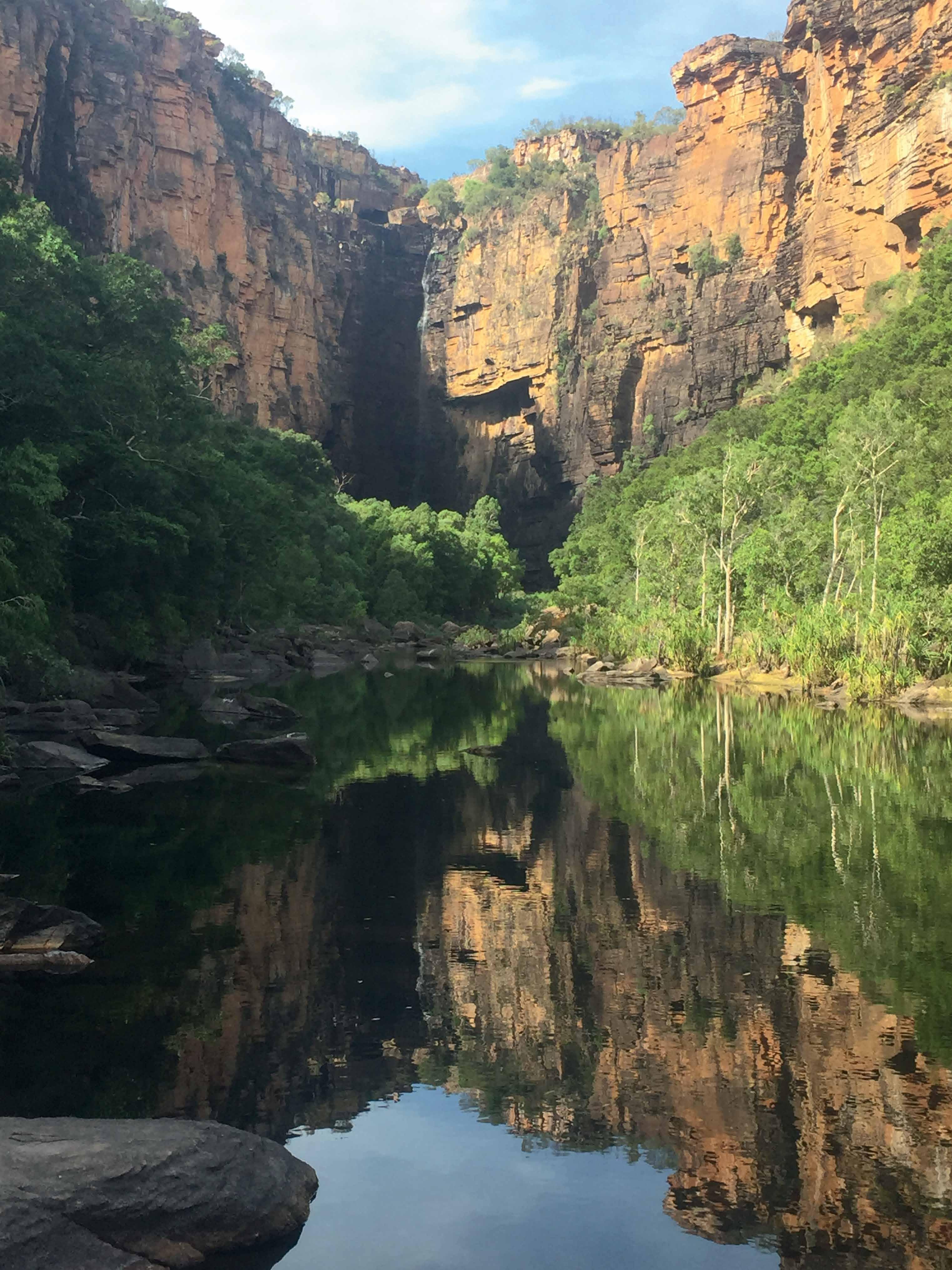

or four days of camping and swimming in pristine waterholes with no shops since you left Pine Creek, what about food? This is where dehydrated meals are a must for your camp fire cook up. Kakadu is about spending time in the wild and absorbing all this ancient land has to offer so a bit of roughing it is part of the adventure.
From Barramundi Gorge you’ll head back to the Kakadu Highway and tarmac for the 50kms to Cooinda Lodge where you’ll re-stock your supplies and will, I’m sure, be in need of a few cold beers. Cooinda is the gateway to the Yellow Waters wet lands in the heart of Kakadu and a morning or afternoon cruise is a must and will be one of the many highlights of your trip to Kakadu. You’ll see plenty of crocs, buffalo and its teeming with birdlife. Stay overnight at Cooinda (it’s got a great swimming pool), where you’ve got the option of a cabin or camping but in peak season you’ll need to pre-book as Cooinda gets very busy. The other option is to camp at the nearby Jim Jim Billabong Campground where a ranger will collect camp fees. No need to book. No swimming here!
Fortunately, most tourists don’t get off the beaten track so once you head back
into Kakadu’s wilderness, you’re pretty much on your own again. Don’t miss the 60km ride on the 4WD track into Bilkbilkmi (Graveside) Gorge (pre-booked permit needed). You’ll have some creek crossings and sandy patches ending at a
“ The campsite was next to Jim Jim Creek on the sandy track to Twin Falls but too many saltwater crocs were lurking in the shadows so the campsite was moved to higher ground.”
cascading waterfall in a gorge filled with a hidden sub-tropical rainforest. Camp overnight or longer to explore and then head back to Cooinda to re-supply and stay a night to enjoy a few more cold beers, before you head off on your next adventure at Jim Jim Falls. Years ago
Above: TT600 and XR600 in
Right: Saltwater crocs can grow to massive sizes.
the campsite was next to Jim Jim Creek on the sandy track to Twin Falls but too many saltwater crocs were lurking in the shadows so the campsite was moved to higher ground. Karnamarr Campground overlooks the escarpment and here you’ll be mesmerised by the changing hues of ochres on the sandstone cliffs at sunset. There’s also a rather posh amenities block with flush toilets and hot ‘solar-powered’ showers. This campsite is 5kms from Jim Jim Falls and its deep plunge pool along a sandy track and then it’s a 1km scramble over boulders to reach the falls. Twin Falls has been closed for years as too many crocs have moved in. At the end of every wet season, before Jim Jim Falls is re-opened, the park rangers set traps and remove any saltwater crocs that may have moved into the plunge pool. In the dry it’s too far from them to make it over the boulders. Spend an extra day camped at Karnamarr and do the hike to the top of Jim Jim Falls, which offers spectacular views out over Kakadu. If you’re running low on supplies, the ranger-in-residence might help you out if they’re doing a shopping run to Jabiru.
When you ‘finally’ drag yourself away from Jim Jim, call into Burrungkuy (Nourlangie) and explore the ancient Aboriginal rock art galleys. Along with Ubirr (which you’ll explore later), these two sites feature some of the world’s oldest rock art. Stop in Jabiru for some luxury R&R at either the Croc Hotel or the Aurora Lodge and Caravan Park. By now your seven-day Kakadu National Park pass has expired, so call into the Kakadu National Park headquarters to renew it. Spend some time viewing the displays and especially the timeline map where the significance of the Aboriginal people and their culture will not only be deeply imprinted on your psyche, but will also remind you of the brevity of our own individual time here on earth. This will not be
lost on you as by now, the ancient land that is Kakadu, would have fully seeped into the very essence of your being. On your last days here as you watch the sun set over the majestic Magella Wetlands from the top of Ubirr rock you will leave Kakadu changed.
Kakadu National Park information:
You’ll need a pass to visit Kakadu, which can be purchased online or at a number of visitor centres. Some areas like Bilkbilkmi (Graveside) gorge and Jarrangbarnmi (Koolpin) gorge, if not closed, need pre-booked permits. There’s no need to pre-book most camp sites as you just turn up and fees will be collected by the ranger.
For details visit:
www.parksaustralia.gov.au/kakadu


Anadventure ride to Kakadu really should be on every adventure riders bucket list. Getting to Kakadu, especially from southern states, will be an adventure on its own so plot your route sticking to the back roads as much as you can. Maybe you can string a series of adventure rides together from what other readers have submitted.
We’re blessed in Australia with so many adventure tracks and trails to explore whether a day ride or something much much longer. I hope in future issues of Adventure Rider you’ll share your favourite adventure ride. Share where it is; what’s to see; and why you like it. And include a few photos and a map. Or the editor can create this for you. We will also fix any typos etc. so don’t worry if writing is not your thing.
Send your submissions to: yourview@clemengermediasales.com.au

Words and Photos: Don Beaton
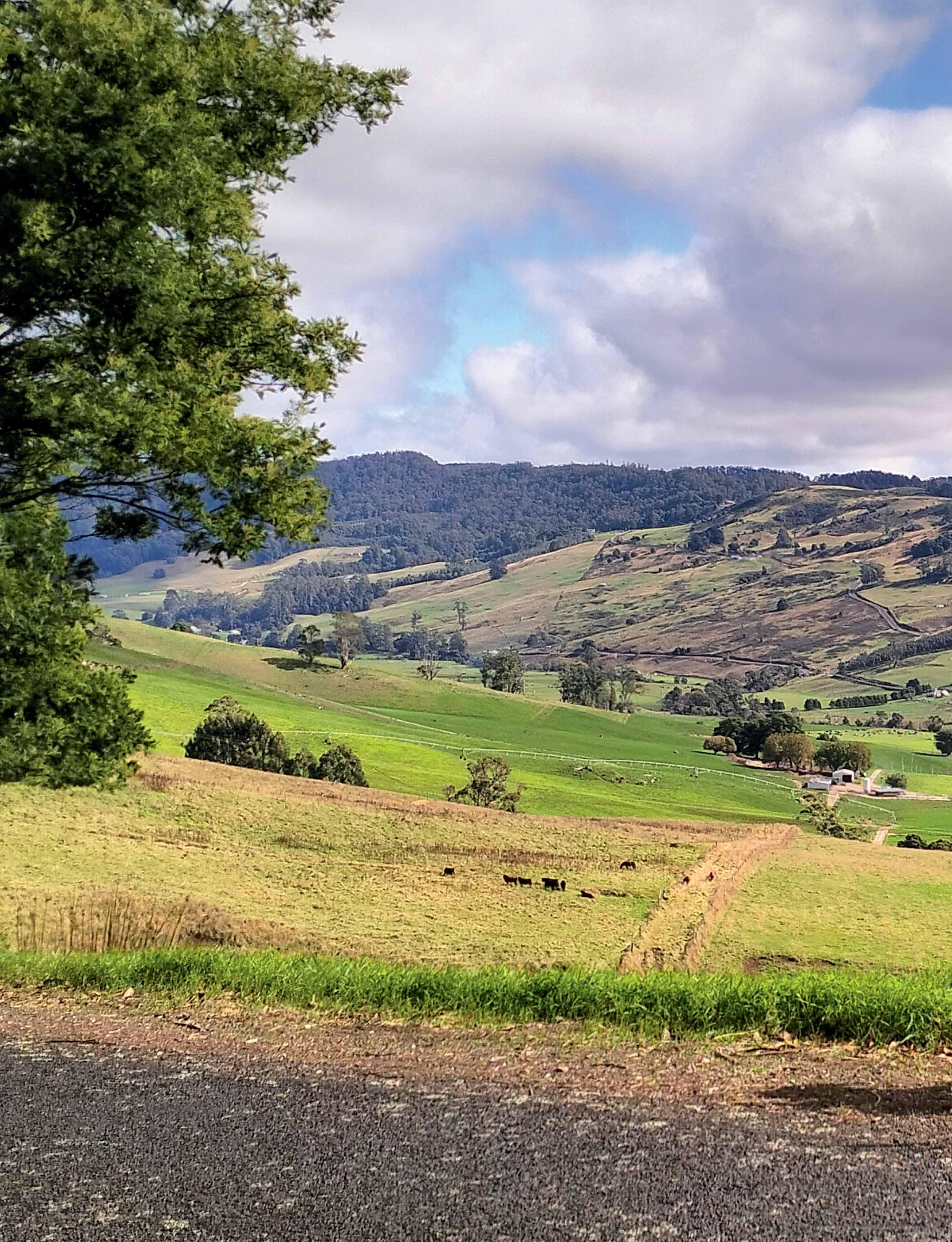
This route (6 hours or 353km) is one of my favourite rides in Tasmania, it can be a good option for an overnighter to then head home via the Great Lakes on the second day or a good option for the start of a longer Tasmania trip straight off the spirit of Tasmania in Devonport.
Deloraine is a picturesque little Tassie town with multiple cafes for great coffee and breaky options to get you energized for the ride ahead.
Once on the road, the first couple of hours is a zig-zag through the mid north west of the island with a mix of twisty black top and good gravel roads that will take you through Chudleigh, Mole Creek, Sheffield, Barrington, Kindred, South Riana, Hampshire and then across to the A10.
Turning south on the A10 takes you down through the Hellyer Gorge, a great section of road which is famous for being a Targa Rally Stage. On to Waratah where there is fuel for the bike and the heritage-listed Bischoff Hotel is worth a stop for lunch to fuel the body.
From Waratah it’s on to Savage River, coming into the Tarkine region, cruising down another stunning section of road then a loose twisty gravel road takes you down to Corinn and the famous Pieman Ferry.
After a getting a cold drink and a ferry ticket, it’s time to board the ferry and cross the Pieman River.
Once across the Pieman the dirt continues for another 10 km before turning to the black stuff again and you’ll travel past a wind farm and some elevation with ocean views of the west coast.

If time permits a visit to Granville harbour and trial harbour is worth the time to get up close and personnel with Tasmania’s wild west coast, then onto Zeehan and finally into Strahan. Grab a couple of cold drinks in Strahan and head out past the airport to the beach. If it’s low tide you can ride on the beach here, find a spot and watch the sun set. Life is good.
Don Beaton runs Southern Cross Motorbike Tours in Tasmania and specialises in hiring adventure motorcycles and provides expert advice on exploring Tassie’s backroads. Don can also curate a ride for you based on your available time and what type of motorcycle adventure you’re seeking.
For details: www.southerncrossmotorbiketours.com.au


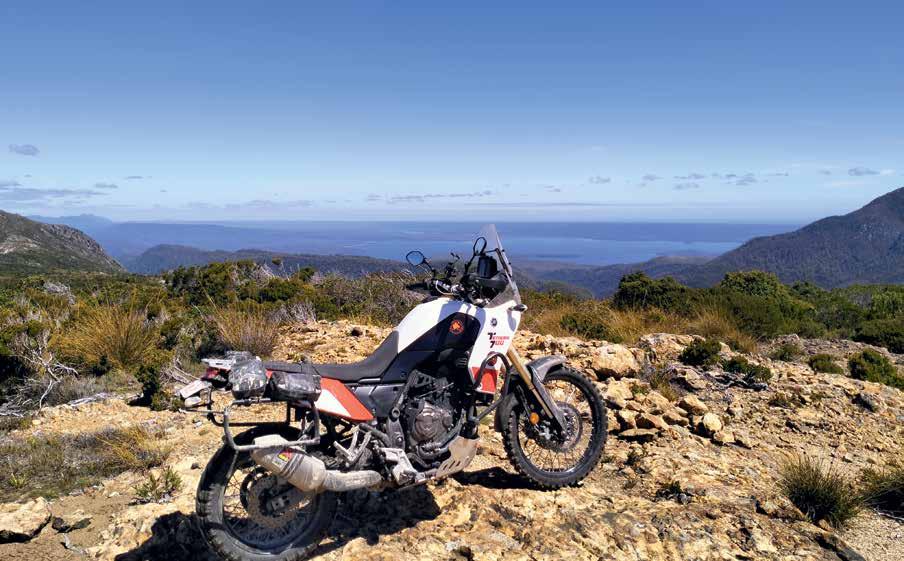
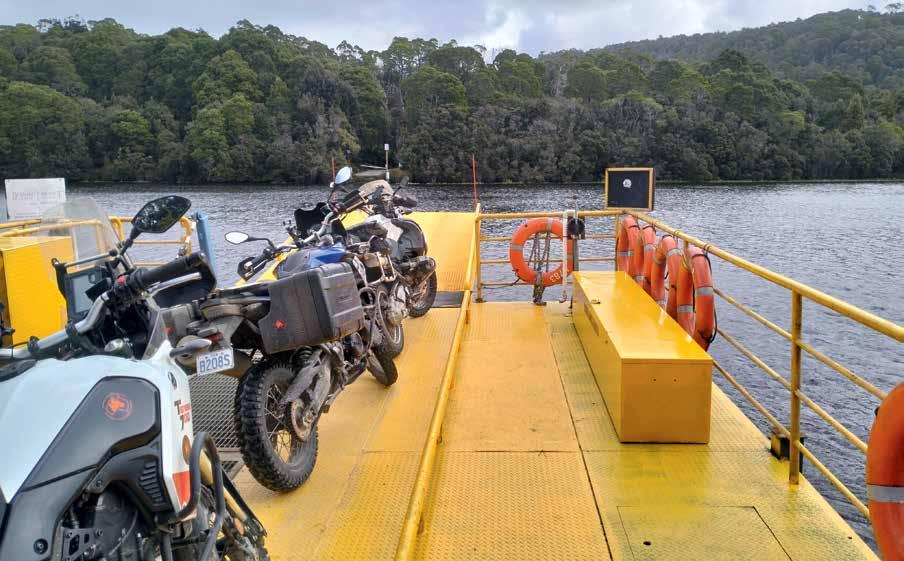
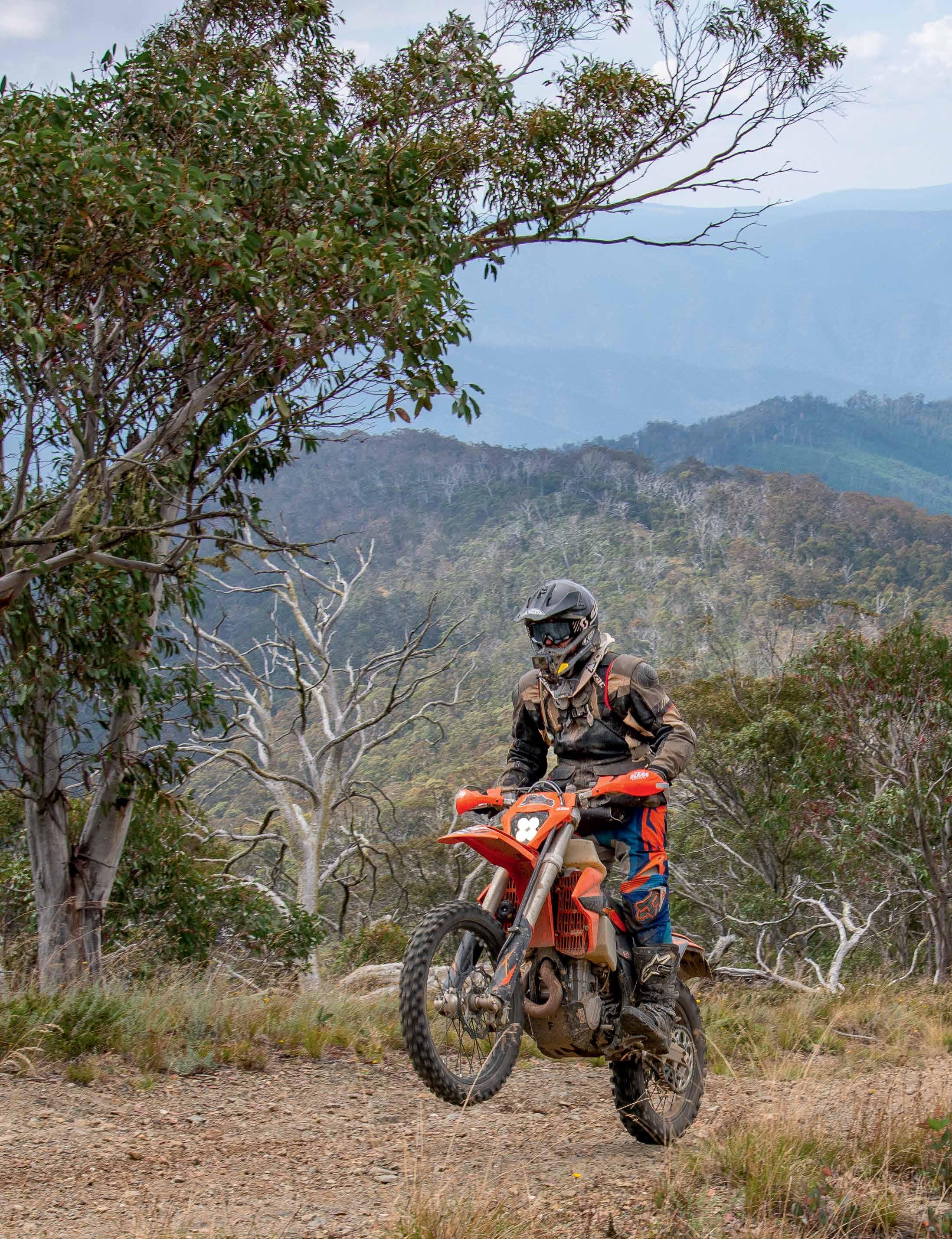
Share Your Favourite Adventure Ride
Here at Next Level Dirt Bike Tours, we get asked a lot about our favourite high country tracks. While it is hard to pick one, for today I’m going to say its Sarah Spur Track northwest of Dargo. When heading northwest the track begins with stunning views looking down towards a helipad and beyond that to the Wongungarra River in the valley.
As you commence the decent you’re torn between keeping your eyes on the track so as not to be thrown off by one of the numerous erosion mounds, and taking in the stunning views. Half way down to the valley floor you ride up a small hill that is utilised as a helipad in case of emergency. From here the view continues to amaze as riders descend directly down to the river. As with most big rivers in the high country, this one can become impassable after decent rain.

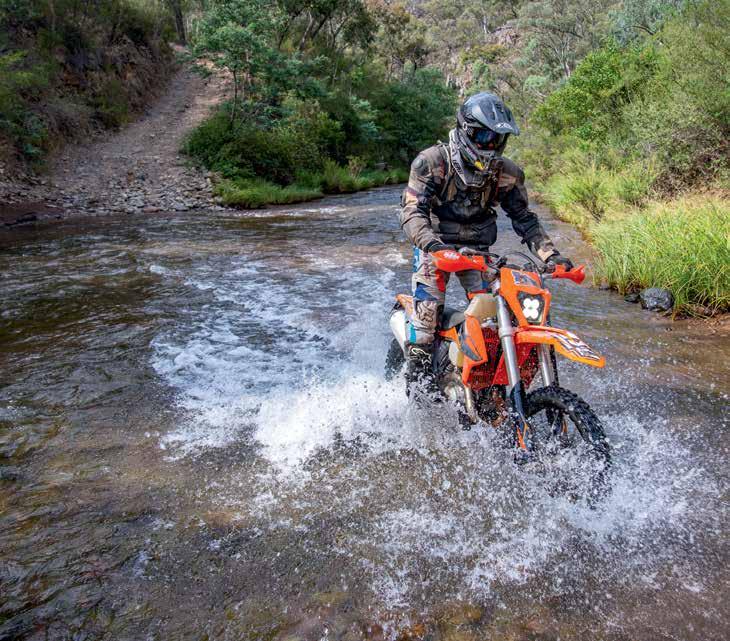
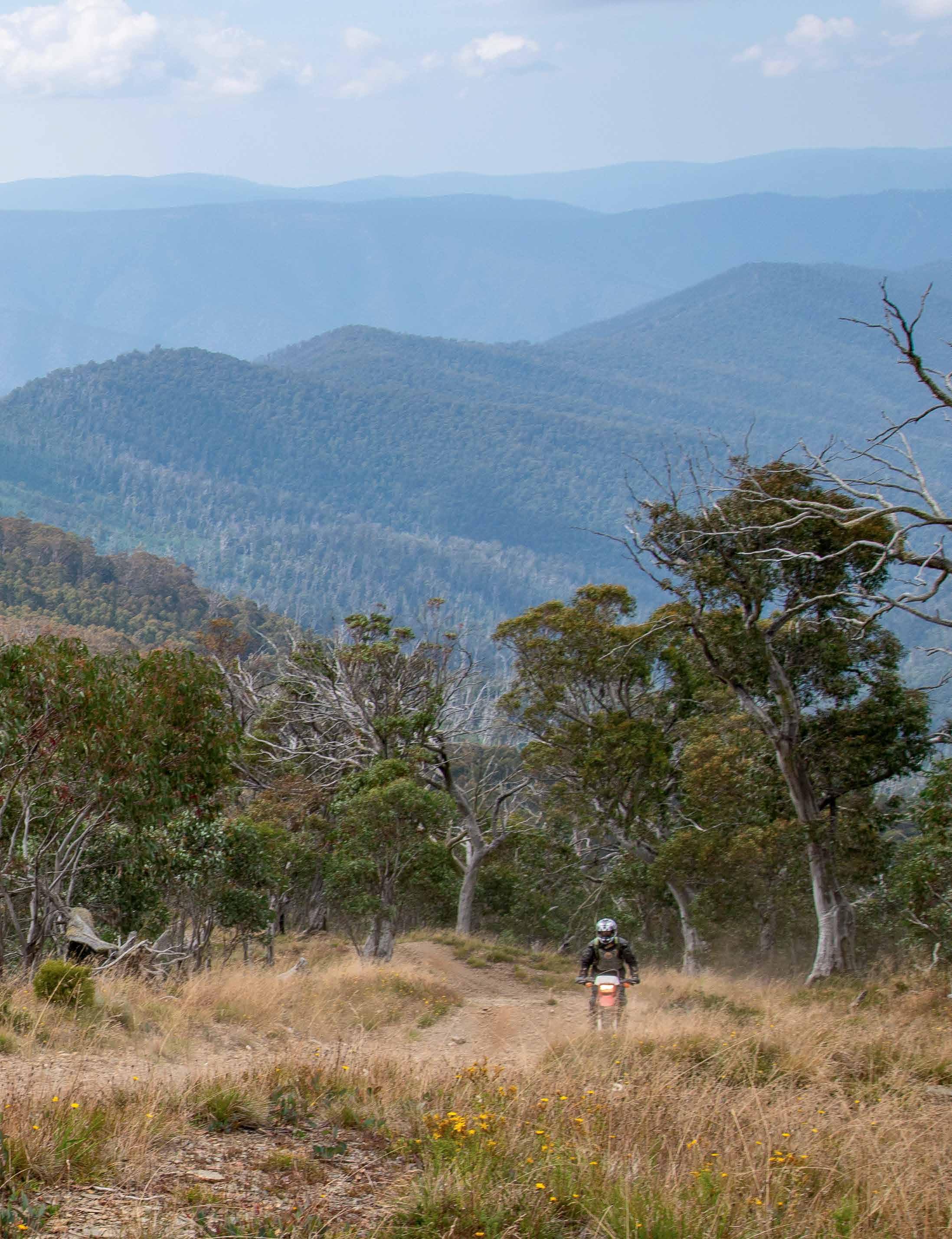
From the Wongungarra River the track climbs steeply for the first 5kms or so with numerous erosion mounds and a loose gravelly track surface. Riders definitely want to keep the momentum up on this section to avoid stalling out and having to attempt to start again. For the next 5kms to 7kms the track is less steep and while it continues to climb, it is more undulating. The last couple of kilometers climb
steeply again with a rocky surface underneath. The track is open all year round but beware in winter it can get icy and slippery at the top. The views from the top are well worth the climb however and on a clear day its a great place to kick back and enjoy a muesli bar. This is a great track to incorporate in your trip if you’re heading from Dargo over towards Harrietville or Bright.
Josh Rykers runs Next Level Dirt Bike Tours deep into Victoria’s High Country taking riders on some spectacular and often little known trails. Tours are tailored for either lighter enduro bikes or larger adventure bikes and range from single day to multiple day trips. They also offer beginner ride days. For details: www.nextleveldirtbiketours.com.au

Above: Crossing the Wongungarra River on the Sarah Spur Track. Above left: When riding the High County tracks in Victoria and NSW make sure you’ve got a detailed map. Below: Riding the Sarah Spur Track from Dargo to Harrietville.
A Book Review By Heather Ellis
An adventure ride over a long weekend, a week or even several months here in Australia is relatively easy. Pack your bike; head off down the road. But when it comes to an adventure ride to another country or even Round The World (RTW), this seems overwhelming and may even fill you with a little fear for there are many unknowns. This is where reading the experiences of other motorcycle adventure travellers will not only put your mind at ease, but will give you the inspiration and reassurance that your own epic overland motorcycle adventure is easily doable.
The Moment Collectors Asia: Twenty Travellers’ Tales From The Most Diverse Continent On Earth by Sam Manicom and friends is a collection of 20 unique and adventurous ‘moments’ of life on the road in Asia from motorcycle travellers globally. It’s the second book in the series following the success of The Moment Collectors –Twenty Travellers’ Tales from Around the World (2022). Having met so many other riders on their own RTW motorcycle adventure, Sam wanted to capture some of their more adventurous moments in a book and hopefully inspire more riders to take off on their own journey to distant lands.

For motorcycle travellers, Sam Manicom needs no introduction. But if you are new to adventure travel, Sam has travelled with world on his BMW R80 GS called Libby since the early 1990s. Many of those later trips were with partner Birgit on her own BMW, a 1971 R60/5. He has published six books, some are also available as audio books and he also works full time in adventure motorcycle travel as a feature writer, presenter and co-host of Adventure Rider Radio RAW show.
The Moment Collectors Asia covers Myanmar, Cambodia, Vietnam, Pakistan, India, Nepal, the Stans of China, South Korea, Siberia, Mongolia and Central Asia. Many of the writers are well known with their own bestselling motorcycle adventure travel books, while others you’ll meet for the first time. I was honoured to be asked by Sam to contribute a story and I
chose a moment from my travels on my Yamaha TT600 in Kyrgyzstan and Kazakhstan.
Riding either solo, in pairs or as a couple two up, these motorcycle adventurers share moments of the sheer joy that comes with exploring often remote locations where they are welcomed into the homes and hearts of the locals. But there are also moments of hardship as life on the road is not always easy and is not for everyone.
These adventure motorcycle travelers will take you through some of the most magnificent landscapes in the world. From the remote steppes of Central Asia; to the high Himalayas of Nepal and India; to the forests and temples of Myanmar; the jungle backroads of Cambodia; exploring South Korea; and to the extremes of eastern Siberia including an ice road to visit the reindeer herders in the depths of winter, and much more.
‘Are these writers challenge addicts? No, they are just like you. They have simply discovered a way to see the world that gifts them with days full of surprises and delights which more than counter the risks. One of the key things they have in common is an incredibly strong streak of curiosity,’ says Sam Manicom.
If you’re worried about your inexperience to take off on your own overland motorcycle adventure, you’re not alone. Most, if not all of the writers from The Moment Collectors Asia started out, just like you and me. Some had not even ridden a motorcycle before and like a ‘bolt-outof-the-blue’ (often after a few beers), the idea to take off on a motorcycle adventure came to them. At the end of each story, there’s a bio about each writer and links to their website and social pages. They also include a few words about their chosen bike. It’s interesting that no heavy-weight adventure bikes make the list. Instead popular bikes include: the Suzuki DR-Z400S, a handful of Honda XR250s and a Honda CB500X, a KTM 690 and KTM 625, two Yamaha XT600s and my Yamaha TT600, a Royal Enfield Himalayan 411 and a Royal Enfield Bullet 350, two BMW R100 GS and two BMW F800 GS, plus a Moto Guzzi Le Mans.
Each moment shared by these motorcycle adventure travellers is introduced with an inspirational travel quote and
is illustrated with pencilled sketches by artist Simon Roberts taken from the writers’ photos.
The back of the book is a valuable adventure motorcycle travel resource filled with links. There’s links to adventure travel equipment; a Helpful Hints section; travel information; motorcycle travel organisations, clubs, and forums; and Facebook Groups for you to connect and gain inspiration to start planning your trip. Plus there’s links to motorcycle travel books and publishers;
podcasts; and even foundations that offer grants to help fund your adventure. You’ll definitely keep checking this resource section when planning your own motorcycle travel adventure.
These are The Moment Collectors Asia: Maria and Aidan, Jeffrey, Heike and Filippo, Chris, Fern, Anatoly, Sheonagh and Pat, Sherri Jo, Heather, Paul, Candida, Tammy, Brad and Travis, Simon R, Anita, Carl, Simon and Georgie, Zebb and H, Leigh, Jacqui, Heather and Dave, Birgit and Sam.

By Chris Donaldson
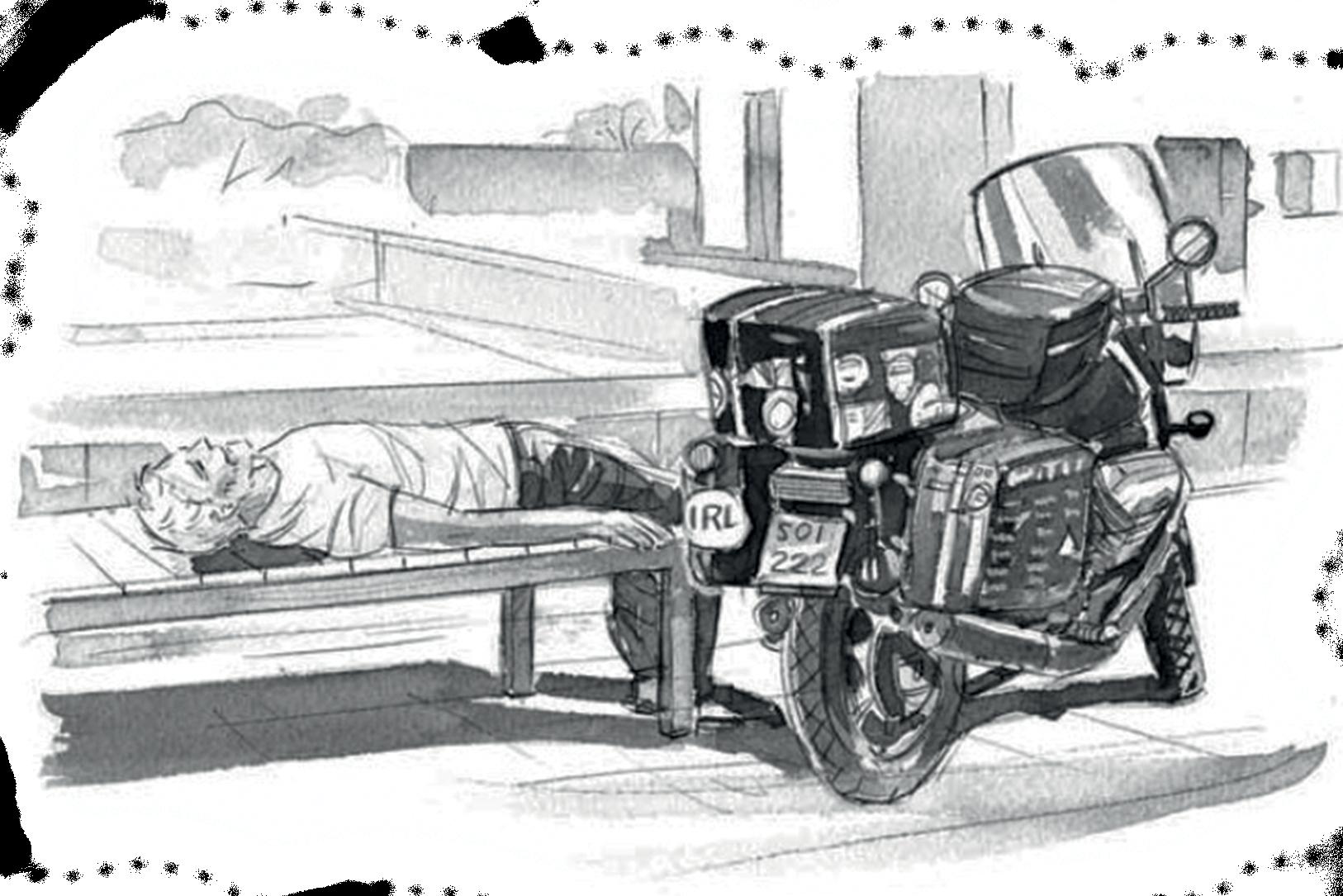
“Everything I was, I carry with me, everything I will be lies waiting on the road ahead” –Ma Jian
‘It’s early afternoon, I’m in an Indian army camp, and my Moto Guzzi has a full tank of petrol.
A wave of contentment broke over me as I sat watching the scene unfold
before me. For a moment I’m 21 again, off to see the world with the fresh eyes that only youth can see through. I was living by the day, by the hour, not knowing nor particularly caring what would happen next. I didn’t know where I would sleep that night, or what these feckin soldiers wanted. But I wasn’t

worried. Something will happen, so whatever! This was one of those moments that travelling is all about. Completely outside any norm, and totally separated from the planned and expected. It was an instance of pure selflessness, not caring about anyone else. It’s just me and the bike. But nowadays, ruled by health and safety stuff, adventure is considered foolhardy and reckless. But ask yourself, when you’re about to bite the dust, will you look back and say, “Great, I made it without drama!” or do you wanna choke laughing at the awesome times and epic fuck-ups you made?’
Chris says of his bike: ‘The Le Mans is a perfect adventure bike: simple to maintain, it’s lightweight, and the V-twin engine is tough enough to power a Russian tank. But it still goes like shit off a shiny shovel when you want it to. Modern motorcycles need computers and a specialised workshop to do repairs.’
Chris Donaldson, 64, and diagnosed with Parkinson’s, rode his 1977 Moto Guzzi Le Mans from Belfast to India setting off in 2022. His RTW motorcycle travels first started in 1979 when he rode the same bike through the Middle East to South Africa and then from Canada and the US to South America. From Nepal, in 2023, he flew his bike to Australia where it remains on display at the Moto Guzzi Cathedral in Yea, near Melbourne). www.chrisdonaldson.com
The Moment Collectors Asia: Twenty Travellers’ Tales From The Most Diverse Continent On Earth is available on Amazon and at www.sam-manicom.com
Heather Ellis is the author of Ubuntu: One Woman’s Motorcycle Odyssey Across Africa and Timeless On The Silk Road. Available on Amazon and at: www.heather-ellis.com
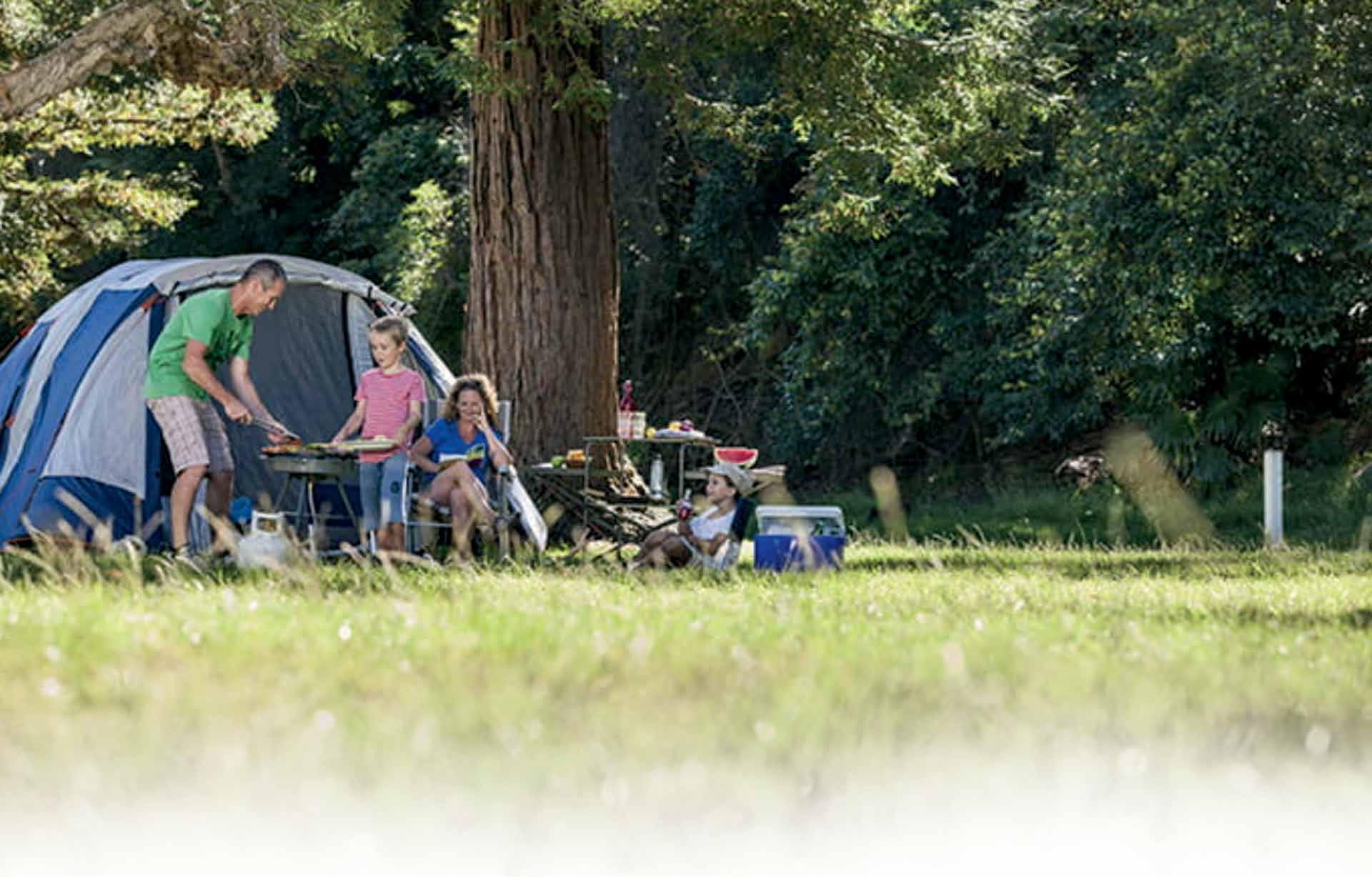
Bob Wozga Column
The warmer weather is just around the corner which means it’s time to blow the dust off the box storing the camping gear, air out the test and sleeping bag. For some, time to get into the bike maintenance, fix those niggly things from the beginning of winter that you promised to do. It’s also time to start looking at places to ride to and prospective places to camp.
One of the things that I hear at BBQ’s, dinners and even on social media sites is “Why are National Parks are always closing sections off parks, blocking or closing tracks, even putting locks on tracks to prevent the public from entering with their 4x4’s and bikes. It’s a public park for the public so accessing these places is our given right
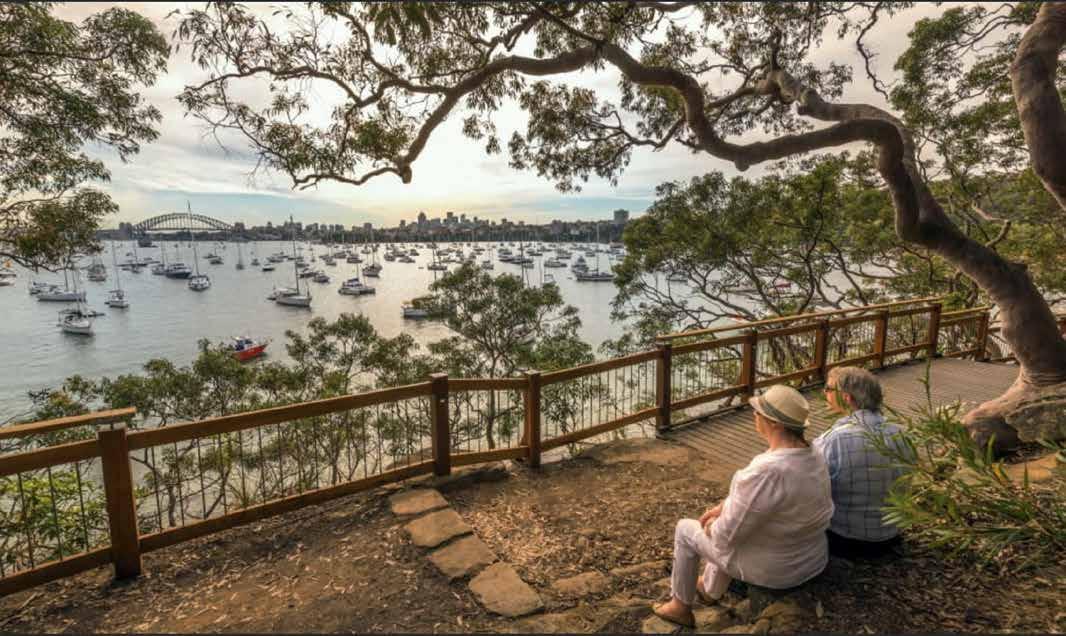
as taxpayers and no one is going to tell us what we can and can’t do or go”. Or “It can’t possibly be hard to look after a National Park, what do these people actually do to earn their money?” Often, I must roll my eyes after giving a short explanation and knowing I’m not getting anywhere and need to walk away. They can find it difficult to understand places and tracks are closed for good reasons and the neighbour over the fence generally does not know the answers.
So, let’s try for a better explanation.
Managing 895 national parks in NSW with 4 World Heritage-listed sites covering 7.6 million hectares is no mean feat. Added to that, the provision and maintenance of picnic areas, boardwalks lookouts and tracks as well as protecting culturally and historically significant sites takes a tremendous amount of planning and management. Project managing the renovations of a house can be difficult and frustrating enough. When you consider that Australia has the unenviable claim to having the highest mammal extinction rate in the world, you can understand the importance research, fire management, eradication of invasive plants and animals have not only on National Parks but on the country as a whole. There is method in the madness with how the National Parks NSW are managed.
Tracks and trails are blocked or closed due to a myriad of reasons such as bushfires, just think of 2019 – 2020. National Parks work closely with the Rural Fire Service. The back burning window is becoming smaller each year creating a greater risk as time goes by. The complaint
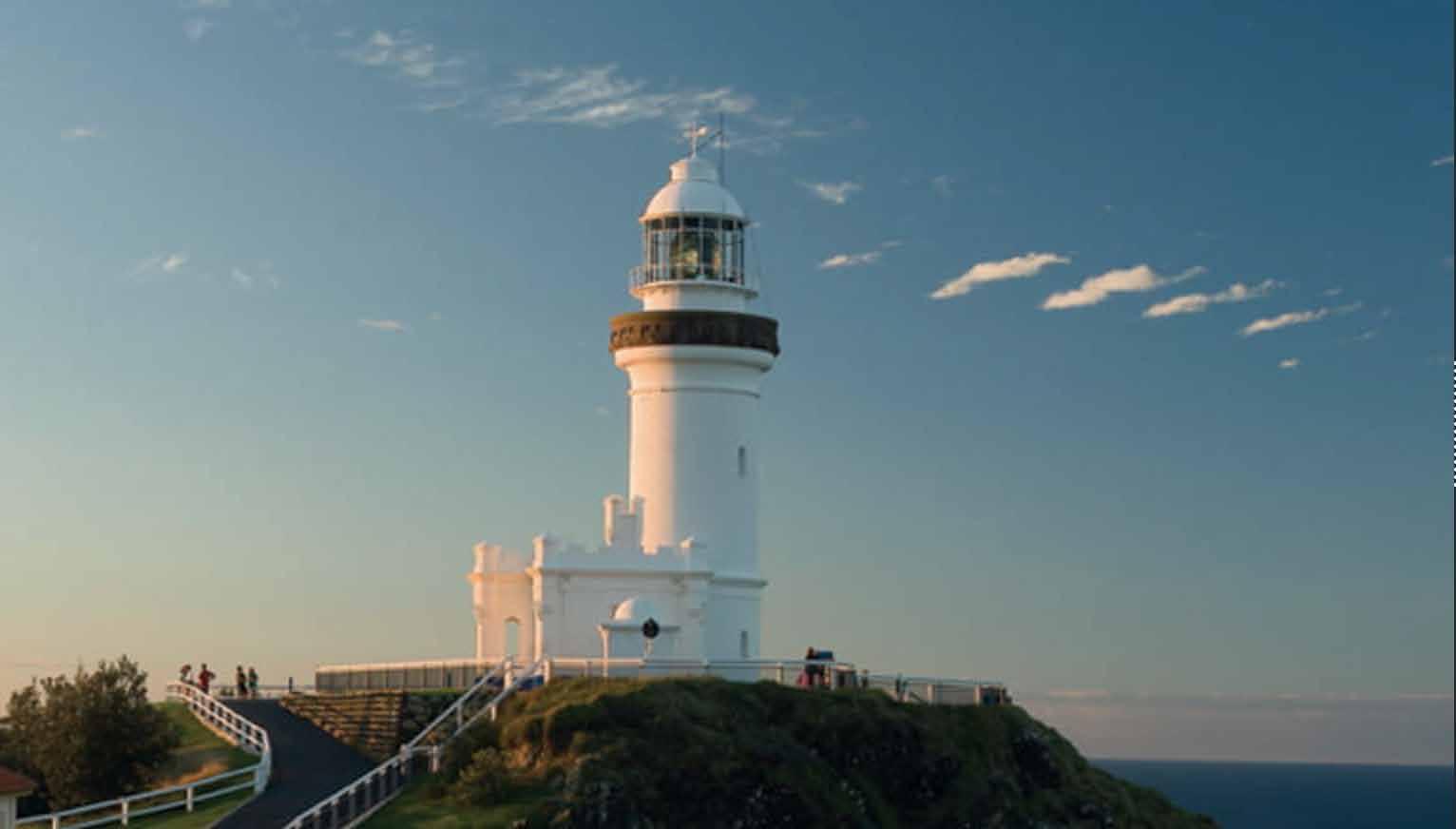
often heard that the RFS can’t access areas due to locked gates is incorrect because the RFS has keys or the combination to open the locked gates. Tracks can be closed due to flood damage making them impassable due to rockslides, washed out creeks and fallen trees. Tracks can also be closed to prevent the public from dumping cars and garbage in these areas. There is nothing worse than finding a burnt-out car and scattered garbage in a pristine location. This also has the psychological effect on you as to whether it is a safe place to stay with your motorcycle unguarded.
Tracks can be closed for the regeneration of sensitive vegetation and to curtail soil erosion. Trailbikes cutting tracks can have a lasting impact on the area that can take years to recover. Tracks can also be closed to conduct research. With in excess of 1100 plants and animals being threatened with extinction, much needed data is required to identify the
distribution of threatened fauna and flora and to direct efforts for their conservation. Maintenance and upgrading of infrastructure may also cause for tracks to be closed.
It should also be noted that not only do you risk a fine, but your insurance can become void if you have an accident or need to be rescued from closed tracks and prohibited areas.
You can ride your motorcycle on public roads, formed vehicle trails and fire trails –the motorcycle is required to be registered and ridden by a licensed rider.
I was recently at Cape Byron Lighthouse to photograph the sunrise and spoke to the park ranger as crowds were walking up the road in the darkness to witness the birth of a new day. The public are generally well behaved however you still get the few that climb over barriers to get their view. One of the things that they must keep an eye on are flying drones around the lighthouse in the early hours.
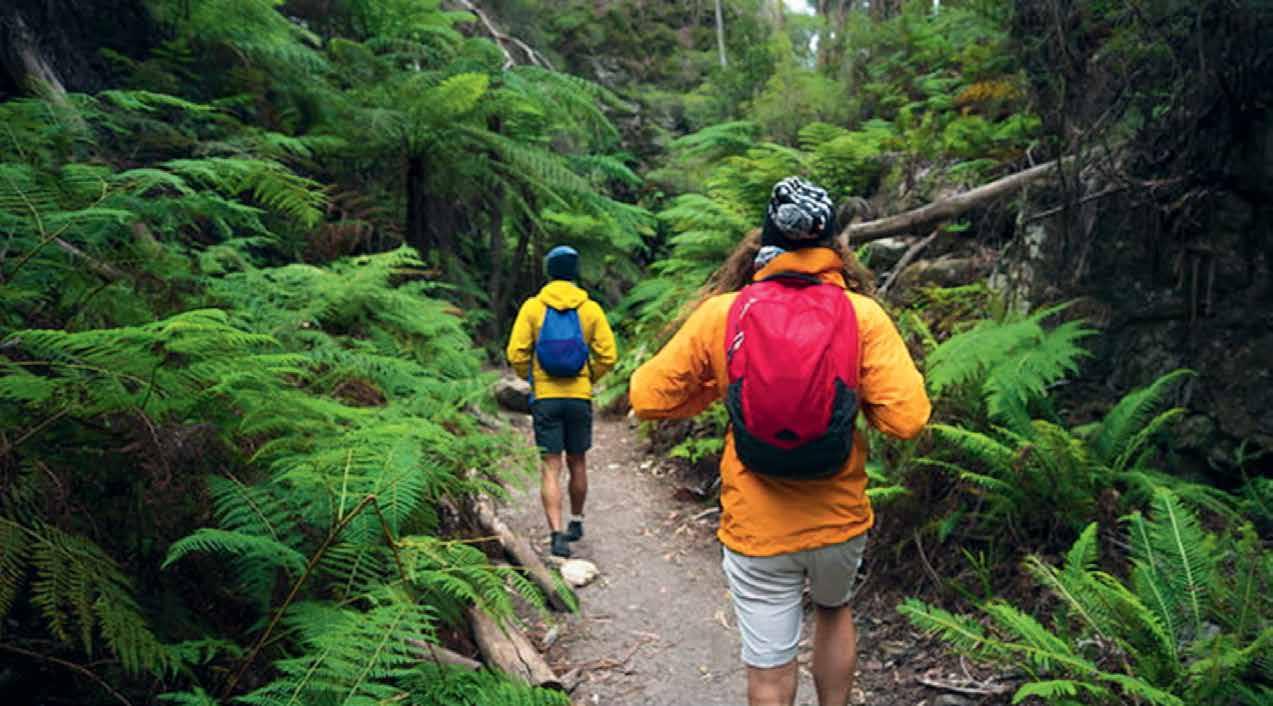

You may ask what risks drones pose, and why you can’t fly them in these areas?
Apart from being a restricted flying area and you are not permitted to fly them within 30m of people nor fly them in the dark, they also create a risk to the bird population. Nesting birds see the drone as an apex predator and can abandon nests. A permit to fly drones can be applied for from National Parks NSW to fly in certain areas.
National parks NSW has a comprehensive website that details alerts for parks whether they are open or closed and reasons for closures. It’s always good to prebook a campsite or cabin and the website so you don’t get caught out turning up somewhere with nowhere to stay.
The National Parks NSW website is https://www.nationalparks.nsw.gov.au/ Each state will have their own website to check out.
The Forestry Corporation has similar policies and information can be found on https://www.forestrycorporation.com.au/ visit/activities/four-wheel-driving-andtrail-bike-riding
There is always a reason for everything.


Atthe Rally Du Maroc in Morocco, Hero MotoSports’ Ross Branch won the Rally GP world championship, giving the Indian brand its first-ever victory. Monster Energy Honda’s Tosha Schareina also claimed victory and helped HRC successfully defend its manufacturer title. In order to win his first championship, Bradley Cox of BAS World KTM Racing defeated Konrad Dąbrowski of Duust Rally and Romain Dumontier Team Honda in the Rally 2 competition.
Bradley Cox of BAS World KTM Racing won the Rally 2 race, beating Romain Dumontier Team Honda and Konrad Dąbrowski of Duust Rally to clinch his maiden title.
Ricky Brabec was within nine points of the Botswanan after winning the Desafío Ruta 40 YPF Infinia, but a knee injury in stage 1 of the Rallye du Maroc forced him to withdraw from the race and the title
FIM World Rally-Raid Championship
contest. Branch switched on the autopilot. Cruising beside his trusted Hero wingman Nacho Cornejo, he remained clear of turbulence and finished third among the W2RC participants, just behind Tosha Schareina and Adrien Van Beveren.
That crowned him the third Rally GP world champion, a historic event for Botswana and Hero, both of which had never won a FIM championship before. Van Beveren won silver, while Schareina took bronze after his Moroccan victory propelled him to the podium at the penultimate minute.
The Spaniard won his second rally of the season, the BP Ultimate Rally-Raid Portugal, paving the way for an exciting 2025 season. Monster Energy Honda won its third consecutive manufacturers’ title.
The new Rally 2 champion also reigns supreme in Africa, particularly South Africa, which will join the W2RC schedule
1. Ross Branch of Hero MotoSports: 88 points
2. Adrien Van Beveren of Monster Energy Honda: 76 points
3. Tosha Schareina of Monster Energy Honda: 70 points
FIM Rally-Raid World Cup, Rally 2
1. Bradley Cox of BAS World KTM Racing: 100 points
2. Romain Dumontier of Team Honda: 94 points
3. Konrad Dąbrowski of Duust Rally Team: 73 points

next season. Bradley Cox completed a double whammy by winning both the rally and the championship.
Michael Docherty and Tobias Ebster helped BAS World KTM Racing secured a podium finish. Cox stole the championship in the last hour from Romain Dumontier of Team Honda, who was riding a new mount. The Frenchman finished second, with Konrad Dąbrowski of Duust Rally taking third place.
The Southern Cone stole the show in the Rally 3 championship, with Chilean John Medina defeating Argentinian colleague Eduardo Alan. Local star Souleymane Addahri finished third after winning on home territory, the Africa Rallye Team’s third in Morocco.
1. John Medina Xraids Experience: 58 points
2. Eduardo Alan Xraids Experience: 33 points
3. Souleymane Addahri Africa Rallye Team: 25 points
2. Hero MotoSports Team Rally: 155 points 2024 WRC podiums following the Rallye du Maroc:

1. Monster Energy Honda Team: 193 points

“Photo was taken in Shropshire hills the start of a great days riding the local lanes near me.” - Matthew





